27.08.23 Collectors’ Cars, Motorcycles & Automobilia
 0669 Auction Catalogue August 2023 Prestige marques from the 1920s to early-21st century modern classics
1967 Aston Martin DB6 Vantage Due Drop Events Centre Manukau, Auckland
0669 Auction Catalogue August 2023 Prestige marques from the 1920s to early-21st century modern classics
1967 Aston Martin DB6 Vantage Due Drop Events Centre Manukau, Auckland


 0669 Auction Catalogue August 2023 Prestige marques from the 1920s to early-21st century modern classics
1967 Aston Martin DB6 Vantage Due Drop Events Centre Manukau, Auckland
0669 Auction Catalogue August 2023 Prestige marques from the 1920s to early-21st century modern classics
1967 Aston Martin DB6 Vantage Due Drop Events Centre Manukau, Auckland

views of the Waitematā Harbour, and enjoy service that is second to none. Our team are dedicated to providing a five-star hotel-like experience, tailored to you.
Unwind in the day spa and indoor pool, browse the wine library and enjoy world class cuisine in our elegant restaurant. Our architecturally-designed homes create the ultimate oasis for luxury retirement living. To find out more about life at The Helier, get in touch today.



17 May 2024 - 08 June 2024

On this exclusive tour, you’ll experience the rich art history Europe has to offer. Guided by your personal hosts, award-winning NZ artist Sir Grahame Sydney, and his wife Fiona, dive into some of the world’s greatest art collections. You will have the opportunity to view artworks from world-renowned artists in person while exploring the beautiful cities of Madrid, Paris, Bruges and Amsterdam.
ThemajorgalleriesofMadrid,ParisandAmsterdamhousemanyofmyfavoriteworks,thosecitiesaresimply wonderfulartpoolsintowhichtodive.Iknowthemall,admirethemexcessively,andcan’twaittosharewhatIhavediscovered there,whatIknow,andtospendmoretimewithsomeofthemostbeautifulobjectsevermade.
-SirGrahameSydney

Head Office Collectors’ Cars
Advertising & PR
Paul Evans Managing Director paul@webbs.co.nz
+64 21 866 000
Karen Rigby Advertising Manager karen@webbs.co.nz
+64 22 344 5610
Elizabeth Boadicea Marketing Manager elizabeth@webbs.co.nz
+64 22 029 5611
Design
Olivia Woodgate Creative Director design@webbs.co.nz
+64 22 323 4919
33a Normanby Road
Mount Eden
Auckland, 1024
23 Marion Street
Te Aro
Wellington, 6011
webbs.co.nz
Caolán McAleer Head of Collectors’ Cars caolan@webbs.co.nz
+64 27 929 5603
Ian Nott Consultant, Collectors’ Cars ian@webbs.co.nz
+64 21 610 911
Chris Wiseman Administrator, Collectors’ Cars cars@webbs.co.nz
+64 21 215 7646
Printer
Bluestar
Edition of 1,800
Offset Printed, 104 pages
300gsm Matt Art
150gsm Matt Art
120gsm Laser Offset
Freely distributed to subscribers or available at select public art spaces and hospitality venues.



While trusts are an invaluable asset protection mechanism, they also require regular review to ensure they are structured to suit your current circumstances.
Your trust may include out of date provisions, people you no longer wish to benefit or receive information or it may even be time to reduce your number of trusts.

Davenports Law provide specialist asset structuring and planning advice to suit each unique situation.
Protect the assets that you have worked hard to acquire, contact our Managing Director, Tammy McLeod.

Every crisp an edible masterpiece





The impressive mechanical complexity. The rich and important sense of history. The joy-giving, sometimes even tear-bringing, balance of beauty and engineering.
These are just some of the attributes that make classic cars such an obsession for collectors, but they could just as readily be used to describe another type of classic — the luxury watch. In fact, with both objects sharing a special appeal and a number of similarities, it’s little wonder that Webb’s is seeing increasing crossover between these two collector camps.

One of the major aspects that cars and watches share in common is aes thetic appeal. The best examples of both are designed to please the eye first and foremost, drawing on our nat ural human inclination toward sleek lines, elegant curves, and beautiful fin ishes. They are often works of art in their own right, recognised and admired as ob jects of desire and beauty even by those who claim not be interested in their workings.
But of course, true fans know that the inner workings are where both classic cars and watches really shine. Made up of dozens, often hundreds, of individual parts that work together in perfect harmony, they share the esteem of being true mechanical marvels. In this area, sometimes the crossover between cars and watches takes on a more literal sense, with the two worlds colliding to create something that encompasses the best of both — almost always to highly collectable results.
Heuer was the first big name watchmaker in motor racing, beginning in the 1930s making dash-mounted timers and later wrist chronographs that were popular with racing drivers in the 1950s and 1960s, often used by F1 teams as their principal timing devices. Included in this catalogue is a TAG Heuer F1 Helmet Clock, which commemorates TAG Heuer’s sponsorship of various F1 seasons racing-car drivers in the 1970s and 1980s. Another prime example from the mid-century era would be the legendary Rolex Daytona, which was designed and named in tribute to the iconic Daytona International Speedway in Florida. Six decades on it remains one of the most sought-after luxury timepieces in the world, with Webb’s last year selling a stainless steel example for just over $50,000. A more contemporary example is the Ayrton Senna Limited Edition Tag Heuer, named of course after the inimitable Brazilian race driver. Earlier this year Webb’s sold a 2002 edition of the watch at another estimate-busting price, highlighting once more the appeal of pieces

that capture the innate connection between the precision of timekeeping and elite motorsport — let’s not forget that the racing world is one where tenths of seconds make all the difference between winning and losing!
The engineering that has gone into a luxury car or watch is often mind-boggling, and a testament to the skill and ingenuity of the people who designed and built them. This is especially true of classic examples that have stood the test of time to remain as much a pleasure to drive or wear now as they did in their heyday — take for example the 1967 Aston Martin DB6 Vantage featured in this catalogue, or an original 1958 Omega Speedmaster. Such storied machines provide a connection to the past, and help us to remember and understand how things were done in a different era. It is this sense of history and heritage in particular that makes both classic cars and watches such worthy investments; their rarity and value only increases with the layering of years, making them prized by collectors.

As New Zealand’s premier auction house, Webb’s continually seeks new and meaningful ways to present works to market. A recent development within our Art department has been the introduction of curated collections, where a single theme connects a diverse range of artworks. As Manager of Art Tasha Jenkins explains, these themed catalogues are a natural progression from the highly successful single owner collections that Webb’s has become known for — providing a way to keep auctions engaging and interesting for our vendors, buyers, and our specialist team:
“While sales such as our Works of Art auction offer a wider range of works that appeal to many buyers, curated sales have a strong thread that connects the works overall. We are able to include more detailed essays about the works, why they were included, and how they fit in with the other works in the sale. These collections offer a selection of works that when hung together all speak to each other.”
Curated sales are intensive to put together, with the team carefully considering a theme and then patiently consigning specific works or artists that fit the criteria — a process that may take six to 12 months to come to fruition. A recent example was Twenty, which brought together 20 works from 20 artists whose investment level is on the rise. The idea for the catalogue arose from a string of auctions in 2022 where Webb’s set new price records for multiple artists. The resulting auction saw a new record price set for A. Lois White, and exceptional results gained for works from Adele
Younghusband and Louise Henderson — all modernist women artists whose work was long overdue for market recognition. Tasha says: “It is nice to have a major art auction that lets previously under-the-radar names be celebrated. This auction gave us a chance to do that.”
 A. Lois White, Religion and Life EST $150,000 — $300,000
A. Lois White, Religion and Life EST $150,000 — $300,000
Tasha points out that a highly-considered approach gives curated auctions a special, exhibition-like context that has advantages for both vendors and buyers. The niche nature of the catalogues helps draw out new vendors and hard-to-find works, while the longer lead times and bespoke displays and texts offer plenty to pique collector interest. “It is always exciting to have paintings come out of the woodwork that you weren’t expecting. It’s also fun to play around with the design of the catalogues and marketing for these sales because we can do something a bit different.”
For those hoping to experience one of these curated catalogues, your next opportunity will be Pencil Case Painters, happening later this year: a selection of works from Shane Cotton, Bill Hammond, Tony de Lautour, Saskia Leek, Séraphine Pick, and Peter Robinson. This important group of Cantabrian artists is referred to as the ‘pencil case painters’ — a moniker that captures the doodle-like qualities of works by this collective in the 1990s at Ilam School of Fine Arts. If you have any works by these artists you would like to bring to market please contact our specialist team, we would love to hear from you.

Traditionally considered a workaday tipple — reliably affordable and dependably strong — bourbon is breaking free of its humble reputation to become a real top shelf contender in New Zealand. Webb’s has seen a surge in interest for premium varieties in recent years, with big names reaching record prices at auction. And this thirst for ‘the Spirit of the South’ shows no signs of abating.
Bourbon is a type of American whisky made from a mash of at least 51% corn, bestowing it a slightly sweeter profile than its Scottish or Irish counterparts. Its history is a long and storied one, but it is believed that the first bourbon was distilled in Kentucky in the 1780s by a man named Elijah Craig. The Baptist preacher and later entrepreneur is credited with inventing the practice of charring the oak barrels in which bourbon is aged, a process which gives the whiskey its distinctly smooth flavour and signature notes of vanilla, caramel and spice.
As the American writer Walker Percy once painted it, “the joy of bourbon drinking is not the pharmacological effect of the C2H5OH on the cortex but rather the instant of the whiskey being knocked back and the little explosion of Kentucky U.S.A. sunshine in the cavity of the nasopharynx and the hot bosky bite of Tennessee summertime”. Bourbon is a drink steeped in the rich cultural history of the American South, evoking the lore of the hard
working Southern Gentleman, the sound of blues and jazz, and the smell of sun-warmed grass, wood-panelled bars, and a pecan pie cooling on the counter. While other spirits may have previously outshined it in cool factor or intellectual association, it has endured proudly and unpretentiously as a symbol of American history, craftsmanship and innovation.
Although it may be deeply rooted in American culture, bourbon is enjoyed by drinkers all over the world — and particularly here in New Zealand. Mainstream producers such as Jim Beam and Heaven Hill have helped push it to become the country’s most consumed spirit, and of course most will be familiar with the hugely popular RTD brands that have notoriously provided a cheap and easy means of consumption. But while bourbon has traditionally been seen as something of an entry level, rough-and-ready option here, the enjoyment landscape is changing. In recent years discerning local drinkers have started to turn their attention to the more sophisticated and complex attributes of the drink, contributing to increasing global demand for varieties at the premium end of the market.
So, what’s behind the surge? Firstly, a huge growth in appreciation for craft spirits across the board has seen drinkers and collectors looking for examples that embody traditional craftsmanship and unique flavour profiles that pay homage to their heritage — and it doesn’t get much more evocative than bourbon. As with all whiskeys, another market factor at play is the time it takes to produce a great bourbon. Compare for example to gin, which can be made in a few days and has consequently seen its prestige diluted by its popularity, with a proliferation of distilleries (of varying quality) having cropped up in the last decade. Whiskey on the other hand takes years, and a great deal of expertise, to make. Not just in distillation, but in the slow, methodical ageing in oak barrels.
The craft cocktail movement has also helped drive demand for premium bourbon, with the return-to-vogue of cocktails such as the Old Fashioned, Manhattan and Boulevardier enticing consumers to invest in premium pours for their commercial or home bars.

Distilleries have responded to growing interest by producing limited quantities of crafted bourbons that offer greater depth of flavour previously seen in the mass market. Webb’s has seen demand take off at the premium end of the bourbon spectrum, with the iconic Pappy van Winkle leading the charge. The Old Rip van Winkle 10-year-Old recently fetched $3,107 in our March Live auction, while the Pappy van Winkle Family Reserve 15-Year-Old reached $4,780 in our January Online sale. The Family Reserve 20-Year-Old also more recently reached $7,170 — eclipsing previous records. For drinkers who are new to bourbon, or collectors who are just dipping their stirrer into high-end spirit market, Webb’s Director of Beverage Nick Hargrave recommends options like Michter’s US1 Small Batch Bourbon Whiskey, or the Woodford Reserve Distillers Select Kentucky Straight Bourbon Whiskey, both of which are available through Webb’s online Cellar Buy Now.
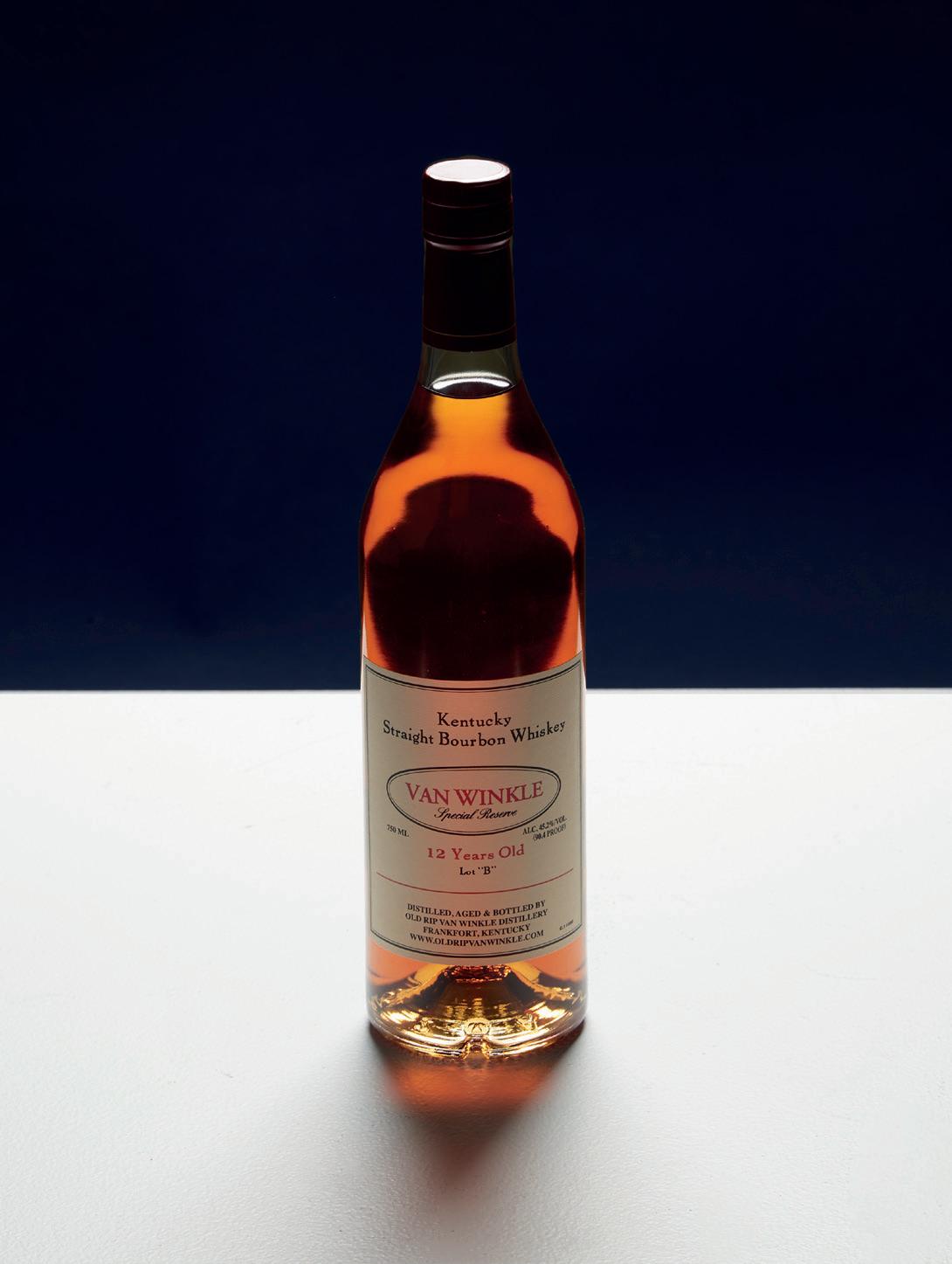
In the spirit of the Southern hospitality in which bourbon is so traditionally enjoyed, he’s also shared one his favourite cocktail recipes — a little something to wash off the day and welcome you into the world of this deeply flavoured and richly storied drink.
30ml bourbon

30ml sweet vermouth
30ml campari
stir over ice and strain over a large ice cube. garnish with an orange peel and enjoy!
Offering more than just an extension of Webb’s services, Webb’s stunning Wellington gallery was purpose designed to provide a collaborative space in which to engage with the capital’s talented arts and cultural community at a local level. The latest expression of this ongoing project is an exhibition from Pōnekebased artist Liam Barr, which explores themes of environmental fragility in a time of insatiable human consumption.
Born in Scotland in 1966, Barr immigrated to Aotearoa in 1974 and his home studio is currently based in Island Bay. Barr’s artistic path took shape after settling in Fremantle, Western Australia, during the early 90s; initially trained and employed as a graphic designer, he
shifted his focus in 2001 to solely work on his fine art practice. In 2004, he returned to Aotearoa, accompanied by his wife and daughter, to further develop his practice as an artist.
At the heart of Barr’s artistic expression lies the exploration of humanity’s relationship with its environment. Through his meticulously crafted oil paintings, he skilfully captures the essence of people and their sense of belonging, or lack thereof. While his painting technique may be considered classical with its multi-layered approach, his subject matter is not. Each series of work explores a different theme — from his early magic-surrealist and tiki-inspired motifs, to narratives rooted in our history, Barr’s artistry
has continuously evolved. In his recent works, he blends realism with a touch of semi-surrealism, inviting the viewer in to a beguiling realm of imagination and storytelling.

As the artist himself explains, “surrealism can be subtle, I like to toy with the freedom to imagine and bend it to what I want it to be and say.”
In Overflow, Barr presents a series of personally-charged, environmentthemed works with contemplative reflection at their heart.
“Overflow is a pressure release valve, a warning signal, an omen and an invitation. It emerges from years of observation, witnessing the destruction of flora and fauna through farming and forestry practices, genetic engineering and, in more recent times, the impact of excessive water on our environment, revealing the unmistakable, interconnectedness of it all.”
The works see solitary figures locked in dialogue with the viewer in an intimate exchange, inviting us to meditate on the imbalances reflected in our climate-changed world. While this collection of work spans several years, a common thread unites them. These figures exist alone with their thoughts, grappling with the unfamiliarity of change, questioning and seeking connection and clarity.
Overflow will be Barr’s 10th solo show since 2003. His work has also appeared in numerous national and international group shows, and in 2020 The Urban Art Foundation held a retrospective of his work which was exhibited nationally via digital billboards. Webb’s Wellington is thrilled to be presenting this thought-provoking collection to local fans and collectors.
Mark Hutchins-Pond Specialist, Art mark@webbs.co.nz+64 22 095 5610
Karen Rigby Business Manager karen@webbs.co.nz+64 22 344 5610
At first glance the contents of the box didn’t seem too exciting: a set of children’s architectural wooden blocks from around the 1960s. Webb’s Decorative Arts Administer Karen Dunsmore thought they might see some interest from a niche collector — maybe a parent or someone in the architecture field— but didn’t expect too much fanfare for a vintage learning tool. That was until she received an email:
“It was from the family who originally owned the blocks! They recognised the distinctive box instantly as a set that had inadvertently been sent to an op-shop during a clearout a few years earlier. They couldn’t believe it. The blocks held deep sentimental value for the family and they were willing to bid a healthy amount to get them back — which they did.”
The serendipitous blocks are just one example of the many surprise treasures that find their way to The Estate: Webb’s menagerie of design, vintage, and all things generally interesting. The fortnightly online sales have developed a cult following for their offering of quality mid-century furniture, antiques, glass, ceramics and art, however, as the above story illustrates, it’s often the most unexpected and unassuming items that garner the most joy — and the most money. As Karen explains:

“The items that come to us don’t always come from ardent collectors. Frequently they are pieces that were inherited, picked up randomly at the Sallies, or that had been boxed up in the attic of the family home for decades. Vendors of these items often have little idea of their worth and end up being pleasantly surprised by the auction result.”
A very recent example of this was a medal that appeared in The Estate last month. More specifically, A Most Eminent Order Of The Indian Empire, K.C.I.E., Knight Commander, awarded by Queen Victoria sometime in the late 19th century. The Estate specialist team knew the history of the medal, and that there was fair market demand for such examples, thus they set the estimate at a healthy $2,000–$3,000. To the delight of both Webb’s and the vendor, the medal blew this estimate out of the water to realise a final price of $7,170.
With The Estate having built up a roster of eager and regular clients, the team always welcomes fresh pieces to ignite buyers’ curiosity and love of the hunt. Karen encourages potential vendors to take a second look at those old chairs at the bach, the box of vintage books in the garage, or the glassware that hasn’t been taken out of the cupboard since the ‘80s — you just never know if you’re sitting on something special.
Karen Dunsmore Administrator, The Estate theestate@webbs.co.nz1 1957 Aston Martin DB2/4 MKII
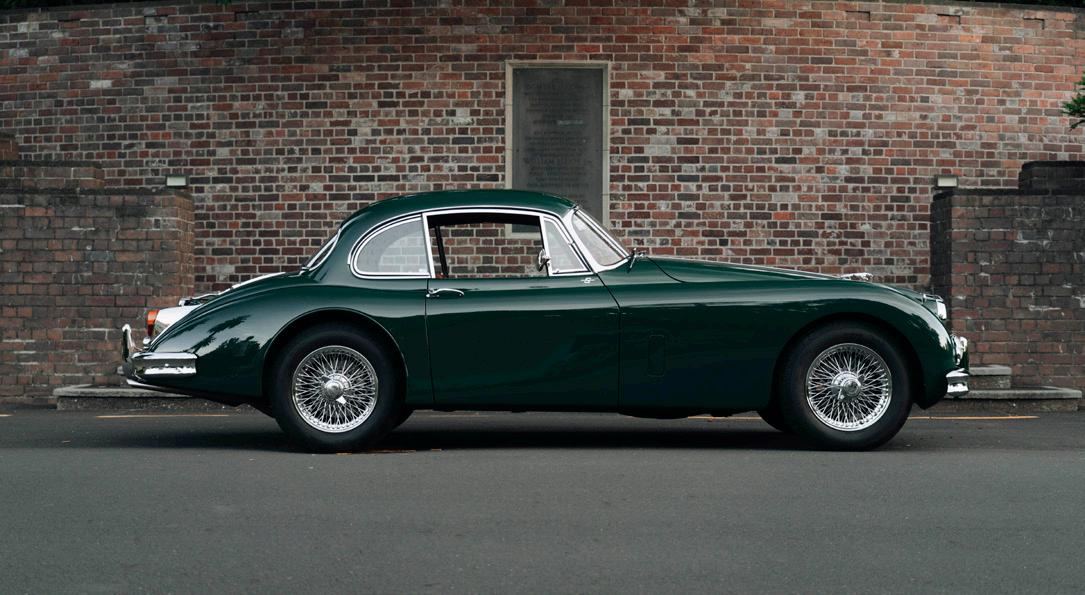
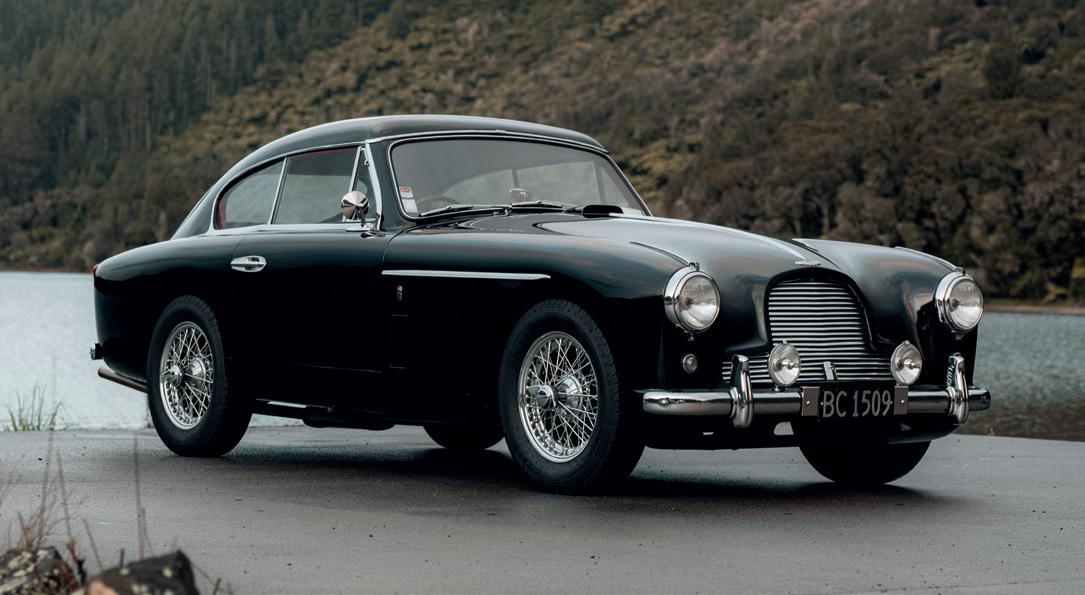
PRICE REALISED $418,000
EST $375,000—$400,000
SALE August 2022
Aston Martin unveiled their Mark II upgrade of the DB2/4 at the London Motor Show in 1955. The most observable changes were the raised roofline with a chrome strip and the addition of tailfins. Worldwide the Aston Martin DB2/4 MKlls are now blue-chip collectibles. They are an even rarer sight on the New Zealand market and our client took note, with a fabulous result.
2 1974 Porsche 911S Targa 2.4
PRICE REALISED $324,500
EST $320,000—$350,000
SALE April 2022
3 1960 Jaguar XK150 3.8S
PRICE REALISED $275,000
EST $280,000—$320,000
SALE April 2022
The 911S 2.4 was bettered only in performance terms by the legendary 2.7RS, and 1974 was the final year of non-impact bumpers and lightweight cars. Remaining in its original colour of Light Ivory, this Targa was one of roughly 40 produced in right-hand drive. The 911S derivatives are benchmark cars and, therefore, the most desirable of all the mainstream 911s, making this Porsche a serious collector’s item and one rarely seen on the roads.

4 1991 Porsche 911 Backdate
PRICE REALISED $242,000
EST $220,000—$240,000
SALE April 2022
5 1969 Jaguar E-Type by Beacham
PRICE REALISED $242,000
EST $230,000—$260,000
SALE August 2022
6 1971 Ford Falcon XY GTHO Replica
PRICE REALISED $233,200
EST $150,000—$180,000
SALE November 2022
7 1963 Mercedes Benz 190SL
PRICE REALISED $218,500
EST $180,000—$220,000
SALE August 2022
The final incarnation of Jaguar’s fabulous ‘XK’ series of sports cars arrived in 1957. This example was one of only 115 right-hand drive 3.8-litre ‘S’ coupés made, making it one of the rarest of all XK150 variants. With full matching numbers, this XK150 was one of the finest Jaguars Webb’s has ever offered and represented a wonderful opportunity for the serious Jaguar collector to acquire an example of one of the most powerful limited production XKs manufactured.
8 1969 Mercedes Benz 280SL (W113)
PRICE REALISED $212,750
EST $200,000—$240,000
SALE November 2022
9 2013 Rolls-Royce Ghost
PRICE REALISED $201,250
EST $185,000—$220,000
SALE August 2022
10 1968 Merceds Benz 280SL
PRICE REALISED $212,750
EST $200,000 $240,000
SALE November 2022
Webb’s is seeking entries for our forthcoming December live auction. Invited entries of interest include Jaguar, Porsche, Ferrari, Mercedes, Maserati, and Rolls-Royce. We are also seeking American, Australian and British classics including Mustang, Cadillac, Ford, MG, and Land Rover. Get in touch today for a complimentary auction appraisal for your classic, collectible, or vintage motor.
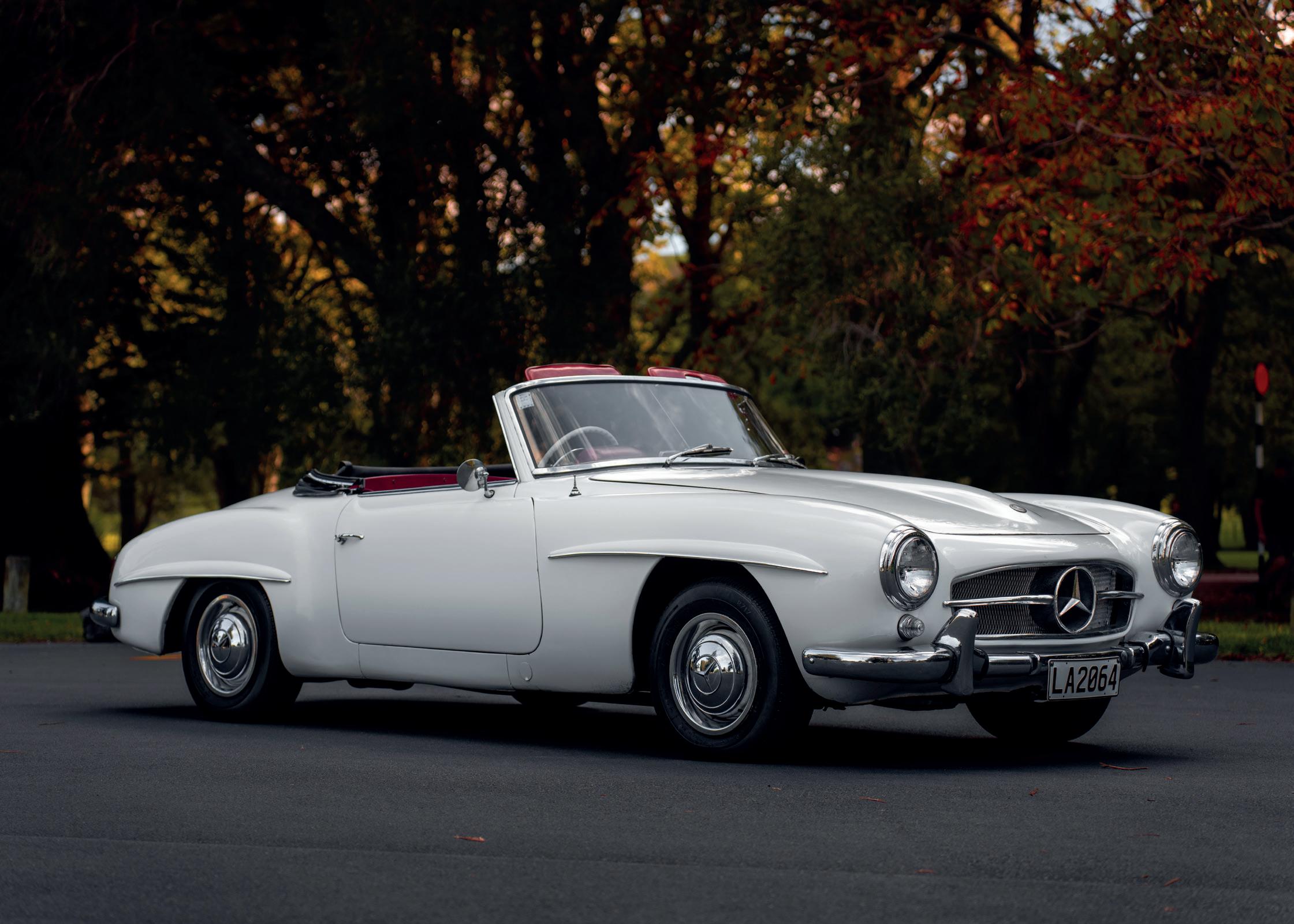
Foreword
Welcome to our second Collectors’ Cars, Motorcycles, and Automobilia catalogue of 2023. Following a successful smaller sale in April at the Webb’s gallery, we are excited to return to The Due Drop Events Centre in Manukau this August.

Although the April sale was smaller in size, it was no less impressive in results. The Chris North Motorcycle Collection garnered significant interest, leading to a white glove sale with all 12 bikes finding new homes on the day. Among other highlights, the spectacularly restored 1937 Alvis Speed 25 achieved a worthy price of $158,125, and our sumptuous cover star, the 1954 Jaguar XK140 Roadster, sold for $175,375, making a local buyer very happy.
In light of the current economic climate, many have enquired about the state of the market. We are pleased to report that the market remains strong, with eager buyers seeking the right additions to their collections and making strategic purchases to capitalise on rising values for certain marques. Tracking online indices from classic.com and Hagerty’s, we can see strength growth in some of the very models featured in this catalogue, such as the Datsun 240Z, BMW M3 E46, Nissan Skyline GT-Rs, and Mercedes-Benz W124s.
As expected, this catalogue offers an eclectic mix of rare and sublime vehicles, designed to evoke nostalgic moments for enthusiasts. Among the many standouts, we must single out the 1967 Aston Martin DB6 Vantage, an exquisite open-chequebook restoration with an expertly tuned-up 4.2-litre engine, epitomising timeless elegance and the remarkable engineering that Aston Martin is known for. For the vintage motorsport enthusiasts, the 1954 Buckler 90 is a true gem, boasting a rich racing history in both the United Kingdom and New Zealand, showcasing the craftsmanship of a bygone era.
For the JDM fanatics, the ultimate prize is the 1990 Nissan GT-R32 Nismo. Renowned for its racing pedigree and thrilling driving dynamics, the model’s value seems to be steadily rising. The 1998 BMW M3 Sport Evolution, part of BMW’s legendary M series, offers the perfect blend of power, agility, and driving pleasure. It is presented in remarkable condition, making it a prized possession for BMW aficionados.
Additionally, we have already begun accepting consignments for our December 2023 sale. Whether you’re interested in selling or acquiring a unique vehicle, don’t hesitate to get in touch with us.

All the extraordinary vehicles featured in this catalogue, along with many other special offerings, will be on view from 23 August. We invite you to come down, say hello, and explore the catalogue in person.
Thank you for joining us in celebrating the passion for classic cars, motorcycles, and automobilia. We look forward to an exciting auction and the opportunity to share these remarkable machines with all of you. See you at The Due Drop Events Centre in Manukau!

There is NO cooling off period offered for motor cars or motorcycles offered at public auction. All vehicles sold within this auction are sold on an ‘as is’ basis. Under the Conditions of Sale applicable to the sale of the lot (please see the catalogue or www. webbs.co.nz for our conditions of sale), buyers must satisfy themselves as to each and every aspect of the quality of the lot, including (without limitation) its authorship, attribution, condition, provenance, authenticity, age, suitability and origin. Lots are sold on an 'as is' basis but the actual condition of the lot may not be as good as indicated by its outward appearance.
The fully illustrated catalogue will describe the vehicles to the best of our ability on information supplied. Should we receive pertinent information after the publication of the catalogue, we shall affix what is known as a Consumer Information Notice (CIN) to the vehicle. A list of all CINs will be available by the time the vehicles are presented for view. We are happy to offer our opinion only and should not be relied upon. In short, you should satisfy yourself as to the completeness, condition and integrity of any lot prior to bidding.
Any statement in relation to the lot is merely an expression of opinion of the seller or Webb’s and should not be relied upon as an inducement to bid on the lot. Lots are available for inspection prior to the sale and you are strongly advised to examine any lot in which you are interested prior to the sale. Although all care has been taken to accurately describe the condition of this lot, this report has not been prepared by a professional conservator or restorer and no guarantees. Webb’s is not entering into a contract with the addressee in the respect of the condition report and accordingly does not assume responsibility to the addressee in respect of it.
However where the Consumer Guarantees Act 1993 applies, nothing in these Terms shall contract out of or shall limit the application of that Act.
Consumer Guarantees Act 1993
Where the Consumer Guarantees Act 1993 does apply the Buyer acknowledges that the following are relevant circumstances in relation to the supply of the Goods and may reduce the acceptable quality guarantee under the Consumer Guarantees Act 1993:
(a) any information Webbs has disclosed on behalf of the Vendor concerning the nature of the Vendor (for example whether the Vendor has used the Goods itself), the context in which the Vendor offers to supply the Goods;
(b) where the Goods are a vehicle:
(i) the results of any Vehicle
Condition Report;
(ii) any defects or observations in relation to the Vehicle and which are recorded on the CIN card or notified by Webbs have been taken into account by the Buyer before bidding on the vehicle;
(iii) notification of any defects is an indication to the Buyer that further defects may exist.
2. Vehicles
Buyer Inspection:
A vehicle is complicated machinery that may contain inherent and latent defects which can only be discovered by a thorough pre purchase inspection. The Buyer acknowledges and agrees that:
(a) the responsibility for examining and assessing the condition of any vehicle rests with the Buyer;
(b) Webbs recommends that the Buyer carry out a pre purchase inspection even where no defect disclosures have been made by the Vendor; and
(c) the Buyer has had every opportunity to carry out an inspection and its own evaluation of the Goods and their quality prior to purchasing the Goods.
Vehicle Condition Report
Any Vehicle Condition Report attached to the Vehicle has been prepared following a limited and basic inspection of the Vehicle. When preparing the Vehicle Condition Report, no part of the Vehicle was dismantled, no diagnostic testing was undertaken. The Vendor and Webbs recommend that any interested Buyer arrange a full mechanical inspection of the Vehicle prior to purchase.
Warrant of fitness:
(a) Vehicles will be sold either unregistered or currently registered with a Warrant of Fitness (WoF) having been carried out within the last 30 days of the sale date. Each vehicle offered by Webb’s at auction will mention which is applicable
(b) Where any vehicle does not at the time of delivery have a current certificate or warrant of fitness the Buyer undertakes to Webbs that they will not, except for the purpose of obtaining in-service certification, operate the vehicle until it has been inspected and certified for in service fitness as provided for in Rule 9.12(4) of the Land Transport Rule 35001/1 Vehicle Standards Compliance 2002.
(c) If the vehicle has at the time of delivery a current warrant
of fitness issued more than one month prior to delivery then the buyer acknowledges and accepts this.
(d) CIN: As soon as practicable after the purchase of a vehicle the Buyer must sign a written acknowledgement that Webbs has provided the Buyer with a copy of the Consumer Information Notice which was attached to the vehicle or displayed online.
(e) Change of ownership: Every Buyer must supply to Webbs before taking delivery of a Vehicle the information necessary to enable a change of ownership to be registered. Webbs reserve the right to delay release of the Vehicle until this is done.
In Trade Buyer:
Where the Vendor is In Trade and the Buyer has acquired the Goods in trade, the Vendor, Webbs and the Buyer agree to contract out of the Consumer Guarantees Act 1993 and sections 9 (Misleading and deceptive conduct generally), 12A (unsubstantiated representations), and 13 (False or misleading representations) of the Fair Trading Act 1986.
Generally: If the Consumer Guarantees Act 1993 does not apply to the sale of the Goods or if the Vendor and Buyer have contracted out of the Consumer Guarantees Act 1993:
(a) Webbs excludes any liability for any representation(s) or statement(s) that may be made or implied by Webbs or the Vendor;
(b) in the case of any dispute relating to the Goods or the sale of the Goods any remedy of the Buyer shall be against the Vendor only and under no circumstances (including an action for breach of any fundamental obligation) shall any remedy lie against Webbs or any agent, contractor or employee of Webbs.
Sale of Goods Act Exclusion: The warranties or conditions implied by the Sale of Goods Act 1908 shall not apply to the sale of the Goods.
Additional Images
Additional images of all vehicles are available in the online catalogue on our website www.webbs.co.nz
Telephone/Absentee Bids
Please complete the telephone or absentee bid form at the back of the catalogue, scan and send to auction@webbs.co.nz. Alternatively,
please call +64 9 529 5600 to arrange over the phone. Bids must be received 48 hours prior to the commencement of the auction.
Buyer’s Premium
A buyers’ premium is added to the hammer price of all vehicles and lots sold within this catalogue. The premium varies dependant on the hammer price of the lot;
$0 - $199,999: 15%+GST
$200,000 - $399,999: 10%+GST
$400,000 and above: 5%+GST
Note - GST is applicable to the buyer’s premium only and not the hammer price. E.g. if the hammer falls at $10,000, you will receive an invoice for $11,725.
If the hammer falls at $200,000, you will receive an invoice for $223,000.
Registration
To register to buy, all potential purchasers not known to Webb’s will be asked to provide an accredited form of photo identification (driver’s license or passport).
Shipping
Webb’s will have local, national, and international freight agents available to arrange deliveries. Quotes will be available from cars@webbs.co.nz
Payments and Collections
Collections can be made from Due Drop Events Centre, 770 Great South Road, Wiri, Manukau 2104
Monday 28 August: 10am-5pm Tuesday 29 August: 10am-4pm
All lots must be collected before 4pm Tuesday 29 November to avoid storage charges ($100+GST per day plus removal costs)
Payments
All payments must be made in New Zealand dollars. Credit cards will be accepted in person only, with a surcharge of 2.2% for Visa and Mastercard and 3.3% for American Express. Personal company and bank cheques are not accepted. Direct bank transfers are accepted. Bank account details will be included on your invoice.
Auction Viewing and Location
Due Drop Events Centre
770 Great South Road, Wiri, Manukau 2104
Viewing Times
Wednesday 23 August 10am — 4pm
Thursday 24 August 10am — 4pm
Friday 25 August 10am — 4pm
Saturday 26 August 10am — 4pm
Sunday 27 August 10am — 1pm
Auction
Sunday 27 August 2pm

Specialist Enquiries
Caolán McAleer Head of Collectors’ Cars caolan@webbs.co.nz
+64 27 929 5603
Ian Nott Consultant, Collectors’ Cars ian@webbs.co.nz
+64 21 610 911
Condition Reports
Chris Wiseman Administrator, Collectors’ Cars cars@webbs.co.nz
+64 21 215 7646

Online Catalogue
Additional images of all vehicles are available in the online catalogue on our website.
webbs.co.nz


Engine: 397
Chassis: 316468
est $40,000 — $50,000
Originally introduced at the New York International Auto Show as the 122S, this classic Volvo exemplifies the fine engineering that is synonymous with the Swedish marque. Also known as the Amazon, a name initially reserved for domestic sales and inspired by Greek mythology’s legendary female warriors, the 122S belongs to Volvo’s post-war midsized 120 series.
This series is noteworthy for being the first to incorporate Volvo’s groundbreaking three-point seatbelt, a safety technology that remains a standard feature in millions of cars produced since then. Volvo has earned a lasting reputation
as a leader in motor-vehicle safety. The 122S is recognised for its Ponton-style bodywork, a design that embraced the future of automotive architecture and drew inspiration from the immensely popular American cars of the 1950s. Despite its box-like influence, the 122S displayed deliberate design features such as subtle tailfins, pronounced shoulders, and distinctive character lines running the length of the car’s sides. These features later influenced a generation of Volvo designers who sought to further refine and modernise the marque’s design language. The Amazon served as the higher-spec model, and, in later
years, the 122S became a performance variant. Initially equipped with a 1.8-litre engine, Volvo increased the displacement to 1986cc in 1969. The model is 2 litre with dual carburetors.
While over 350,000 two-door models were produced by the end of its production run, it is believed that this particular example is the only one of its kind in New Zealand. Additionally, the last Amazon 122S rolled off the production line in 1970, making this example one of the final units to come out of the Torslandaverken plant.
This specific car is presented at auction in excellent condition. It was originally delivered to Australia in March 1969 and brought to New Zealand five years later, with its first registration taking place in December 1974. It is believed to have had three owners in New Zealand, with the current vendor having owned it for the past three years. The car underwent a restoration, including a complete engine rebuild by Taylor Automotive at 54,635 miles, with the odometer currently reading 56,860 miles. The carburettors were fully refurbished by a Weber specialist in Auckland.
Furthermore, the vehicle has received numerous upgrades and replacements, including a new radiator, hoses, suspension rubbers, stainless steel exhaust system, petrol tank, fuel line, petrol pump, water pump, shocks (front and back), and rear straps. A Bosch electronic ignition system was installed, and the steering box was rebuilt.
The car’s interior is mostly original, featuring original vinyl seat covers that exhibit signs of wear and tear consistent with its age. An aftermarket stereo is currently fitted, but a period-correct unit is included in the sale, along with some spare parts. Books, magazines, original promotional materials, and a workshop manual further complement the offering.
In summary, the 1969 Volvo Amazon 122S is a classic Swedish car celebrated for its elegant design, robust engineering, and unwavering commitment to safety. It represents a significant era in Volvo’s history and remains highly sought-after among car enthusiasts today.

Introduced by General Motors on 5 March 1927, the LaSalle series was conceived as a stylish alternative to the Cadillac, presenting a youthful and vibrant image. It aimed to bridge the perceived gap between Cadillac and Buick in General Motors’ line-up. Positioned slightly above Buick in terms of pricing, the LaSalle was designed to be a comprehensive model line, filling out the GM product range. The name “LaSalle” was chosen as a tribute to the renowned French explorer and compatriot of Cadillac, René-Robert Cavelier, Sieur de La Salle.
By 1939, the LaSalle had for the first time achieved higher sales than the Packard 120. However, given the size and expectations of General Motors, the volume of approximately 22,000 units for the 1939 model year was considered insufficient. As a result, a decision was made to discontinue the LaSalle brand after the 1940 model run.
The LaSalle presented by Webb’s in this auction represents one of the last
iterations of the Series 40-50, with a total of 10,382 units produced for its final year. Unfortunately, limited information is available regarding its history in the United States, it arrived in New Zealand and was subsequently registered in Picton on 15 November 1993. On 28 June 1996, ownership appears to have been transferred to the wife of the initial keeper, and it later moved to the Hibiscus Coast on 11 June 1997, and then to Auckland on 3 September 2006. On 17 February 2009, the current vendor, who has since passed away, acquired the vehicle, and it is now being offered for sale from his estate.
Known for his appreciation of fine automobiles, the previous owner and his family derived immense pleasure from this highly original example of American automotive excellence. The body of the car is in excellent condition, as is the interior, which was likely re-upholstered in the late ‘90s, possibly around the same time as a repaint. The sale includes comprehensive documentation of the
work performed during the previous owner’s tenure, along with a workshop manual, left-hand drive permit, and a unique Cadillac Craftsman Code (which has not been previously encountered by Webb’s and appears to be a code of conduct for sales and service personnel).
The opportunity to acquire a vehicle of this calibre is rare, particularly in such remarkable condition. In summary, this LaSalle represents a truly exceptional example of American automotive art from the 1940s, exuding the same timeless appeal today as it did when it first graced the roads.

Engine: 2323079
Chassis: 2323079
est $30,000 — $45,000



Engine: 13761
Chassis: C21006
est $35,000 — $45,000
C1100 is a classic truck model produced by International Harvester, an American manufacturer known for its rugged and durable vehicles. The C1100 was part of the International C-series line of trucks, which were popular workhorses during the mid-20th century.
The C1100 featured a robust and utilitarian design typical of trucks from the era. It had a sturdy, boxy body style with a separate cab and cargo bed configuration. The exterior design prioritised functionality and durability, making it well-suited for various work and hauling tasks.
The C1100 was available with different engine options, providing buyers with choices based on their specific needs. The engines typically included inline-six or V8 engine configurations, delivering a balance between power and efficiency. Engine options varied based on the specific trim level and customer preferences.
The truck was designed to handle heavy-duty tasks. It offered a substantial payload capacity, allowing it to carry a significant amount of cargo in its cargo bed. Additionally, the truck had respectable towing capabilities, making it suitable for hauling trailers and other loads. The interior emphasised functionality and practicality. It featured a basic, driver-focused cabin with a utilitarian dashboard layout and durable materials.
The 1970 International C1100 is revered among truck enthusiasts and collectors for its ruggedness, reliability,
and classic truck aesthetics. It represents a bygone era of American-made trucks that were built to withstand demanding work conditions. Today, well-preserved examples of the C1100 are sought after by collectors who appreciate its historical significance and timeless appeal.
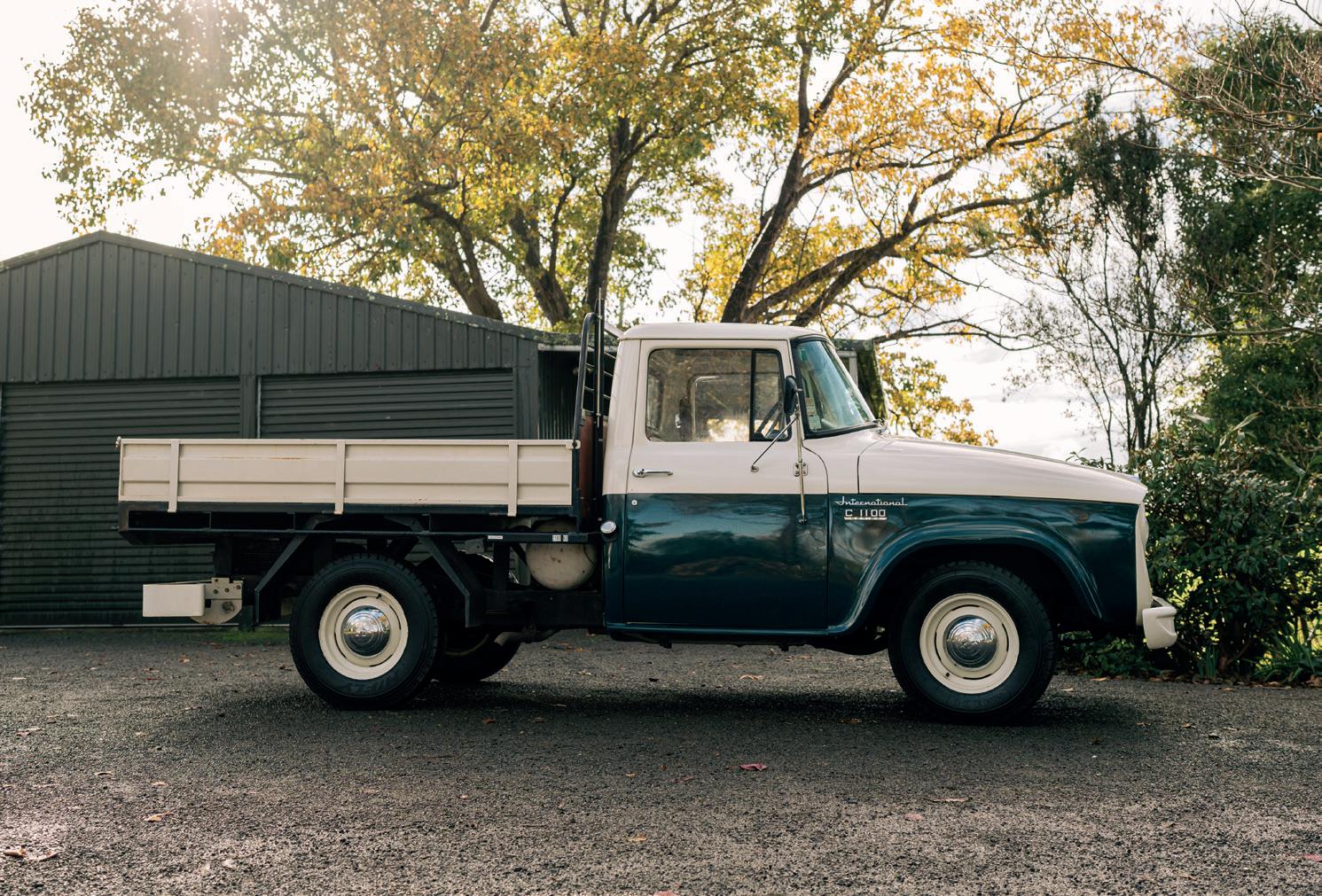
This New Zealand-new example truck is 2WD with 4,629cc straight 6 engine and comes complete with its original ownership papers, detailing just three owners — our vendor being the third, and having owned the truck since 1977. Shortly after the vendor purchased he replaced the deck with Douglas fir shiplap and converted the truck to LPG. The LPG system was later removed when it was road registered, as required by Waka Kotahi. It also has an owner’s manual and after decades of love the vendor is sad to see it go.
 The vehicle will be sold registered and with a current WOF.
The vehicle will be sold registered and with a current WOF.


This classic woody is a beautiful example of New Zealand boat design. With its Kauri carvel construction, Pohutukawa trim, and carbon fibre reinforced hull — this is a boat that enthusiasts will recognise as being not only of high quality design and build, but also of rich heritage coming as it does from craftsmen at the centre of New Zealand’s well entrenched nautical tradition.

Designed by Archibald Logan and built by Lidgard, Crème Brûlée has spent the majority of her life on Lake Tarawera. Originally owned by a local family, she has since passed through a number of owners before being discovered in Rotorua. Her original Austin Thetis engine was found nearby at Okere Falls, and has been fully reconditioned by the current owner.
This particular engine — a marinised Austin 7 — is a robust and compact staple of pre-war boat construction, and was known for its admirable propriety for marine use. Its cooling system in particular was leading technology at the time, and well suited to manoeuvrability.
After its discovery, Crème Brûlée was taken to Kawhia to undergo a full restoration, which was completed in Whangarei under her current owner. It comes complete with a trailer for movement.

A 19 footer with four seats, this is a beautiful craft in its restored glory, as stunning as it was the day it launched.
est $25,000 — $35,000
The Series III Land Rover represents the culmination of refined design, being the final direct descendant of Maurice Wilks’ original sketch in the sand. In the face of competition, particularly from Toyota, Land Rover made numerous improvements in the Series III to enhance reliability and passenger comfort, while still maintaining the rugged utilitarianism for which Series Land Rovers are renowned.
One significant improvement in the Series III was the implementation of synchromesh on all four gears, resulting in smoother transmission and a more relaxed driving experience. The dashboard was also redesigned with a modern plastic moulded design. These enhancements were complemented by overall improvements in reliability and usability. The instruments were relocated to the driver’s side, the Lucas generator was replaced with an alternator, and the long wheelbase version featured the dependable Salisbury rear axle
as standard. The Series III’s 2.25-litre engine was also more powerful than its predecessors, thanks to an increased compression ratio of 8:1.
This specific long wheelbase model is a New Zealand-new example, first registered on July 24, 1978. Recently restored by Robert Neal, a reputable Land Rover restorer, it is in excellent condition and has been well-maintained. Robert fully reconditioned the gearbox, brakes and engine, and everything was re-bored as it had oversized pistons when it came to him. It has been professionally painted and beaten by Forbes Panel and Paint in Blenheim.

The vendor acquired the vehicle in Christchurch after the restoration was completed and drove it back to Auckland without any issues. In the past year, new rear brake shoes and miscellaneous seals have been installed. With a mileage of a spritely 88,000km, this Land Rover is one of few in New Zealand in such great condition.
Engine: 90240850D
Chassis: 91372368C
est $50,000 — $55,000
The vehicle will be sold registered and with a current WOF.



Engine: 8AM-U-H/4319
Chassis: M-A2S4/2766
est $45,000 — $55,000
Britain’s best-loved small car, the classic Mini enjoyed a production life of more than four decades, throughout which it became a fashion statement, a motorsport hero, and wore the mantle as one of the most influential cars in the world.

Conceived in the first instance as a fuel-saving, efficient, and easy-to-drive small car, Alec Issigonis’ masterpiece evolved until production concluded in October 2000.
However, it is not the end of the Mini era that concerns us here, but the beginning — as the 1959 Mini Register of the UK advises:
“The 1959 Mini Register can confirm that chassis number M-A2S4/2766 was exported to New Zealand on 1st September 1959. It is one of the first generation of Minis produced having the rare early style body pressings. These were modified for later models in October 1959. According to our records, this car was one of the first batches of Minis sent to New Zealand and is the oldest Morris CKD (Completely Knocked Down) Mini in the world.”

The British Motor Industry Heritage Trust at Gaydon has similarly affirmed this fact, noting that “the car in CKD form was exported from the Cowley factory, Oxford, in component form in September 1959 and assembled in New Zealand.”
In an article written for the publication Mini World, February 2013, the Gaydon archives note further that it was in a list of 629 Morris Minor CKD kits that were destined for New Zealand and duly dispatched there on 29 September 1959.

Of further interest is the fact that 2012 correspondence from the NZTA (now Land Transport) reports that only one Mini from 1959 is still registered, viz. M-A2S4/2766, though it is understood that there may be others that are currently unregistered or on the Restoration Register.
Little is known of the early history of this car other than the fact that the second-previous owner to our vendor was at a South Island autojumble and got talking to a guy about some Mini seats. During this discussion, it was revealed that he had an old Mini that had been in his barn for 30 years. Apparently, in 1980, someone had turned up with it on the back of a trailer asking if he could look after it until storage was arranged. This was the first and last he saw of him! Whilst it was then the owner’s intention to restore the vehicle, time considerations prevented this from eventuating, hence a sale was enacted. In December 2010, the new owner had the car stripped and all underseal removed prior to it being moved to the paint shop in January of the next year. Then, in February 2011, the devastating 6.3-magnitude Christchurch earthquake occurred. Fortuitously, the Mini was rescued unscathed from the painter’s premises and taken to his home where he continued to work on it. The ensuing aftershocks however stressed him and his wife to such an extent that they migrated to Australia. Another painter was subsequently located and work re-commenced, culminating in the return of the vehicle in April of the same year complete with matching and original Clipper Blue paint. In 2013, the thenowner had a chance to buy another rare Mini, hence the ’59 was put up for sale and bought again by a prior vendor. Whilst the condition of the vehicle is not entirely immaculate, indeed some paint is a little distressed at the rear, it is nevertheless an original example of the very earliest of Mini history, not just in New Zealand but on a global basis. A rare opportunity to purchase a historically iconic and useable car such as this Mini presents a far from common occurrence, especially when accompanied by such a comprehensive provenance. Webb’s is grateful to the British Motor Industry Heritage Trust, Land Transport, 1959 Mini Register and, in particular, an article written by Kay Drury for the February 2013 publication of Mini World entitled ‘Quaking down under’. Their input has all been invaluable.
The vehicle will be sold registered and with a current WOF. A personalised plate 1959 along with its original black plate is to hand. A list of work undertaken can also be obtained on request from Webb’s.
Engine: L4101
Chassis: SCBZR03A2MCH35994
est $30,000 — $35,000
The Turbo R signified a return to Bentley’s pre-war racing heritage. Under RollsRoyce ownership, Bentley cars were often seen as rebadged versions, sharing chassis, engines, and parts. This led to a decline in Bentley’s reputation, with sales accounting for only 5% of total production in the early 1980s.
The introduction of the Mulsanne Turbo, named after the famous Le Mans straight, marked a positive change. With a turbocharger increasing horsepower by 50% compared to the standard Mulsanne and Silver Spirit, it aimed to restore Bentley’s reputation. However, the car lacked upgrades beyond the turbocharger, resulting in handling characteristics that didn’t match its newfound performance.
To remedy this, the Bentley Turbo R was introduced. Motor Trend called it “the first Bentley in decades deserving of the famous name”, and it seems the public agreed; by 1986, one year after the introduction of the Turbo R, Bentley sales had reached 40% of the combined total.
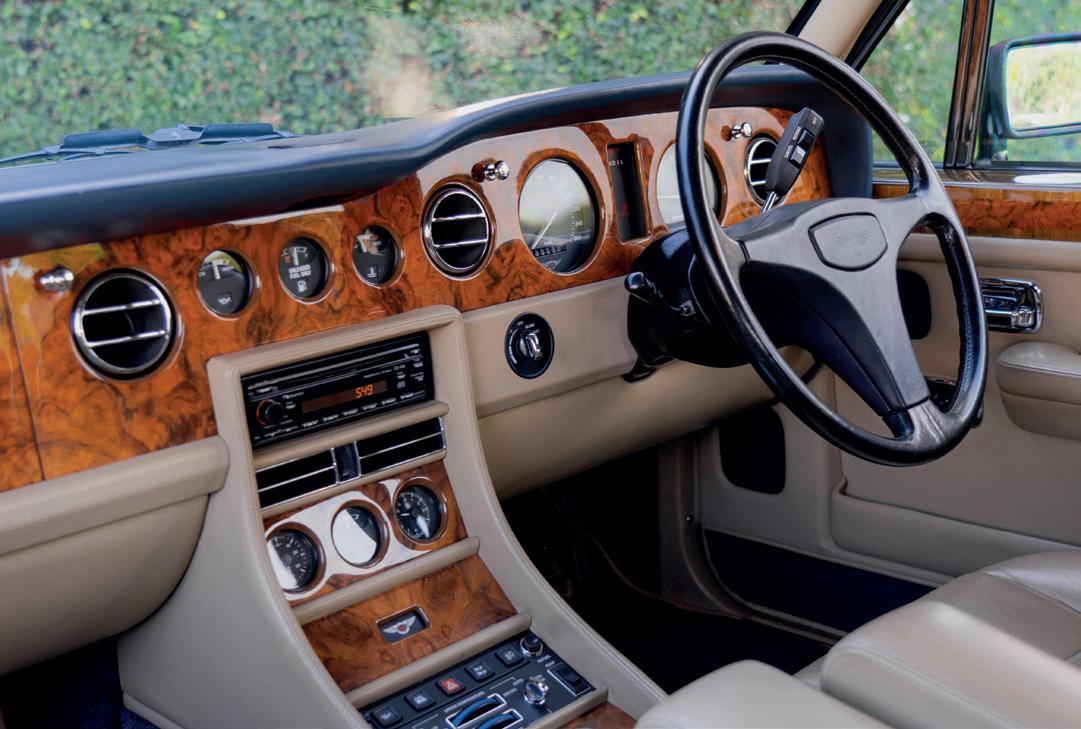
Mike Dunn, then engineering director, is perhaps to be thanked for the vast improvement the Turbo R offered. He demanded a 50% increase in roll stiffness (over the proposed amount of 10%), which led to drastically reduced body-roll. This was achieved by doubling the front anti-roll bar rate, increasing the rear by 60%, and improving the damping.

Further upgrades included wider tires on lightweight aluminum alloy wheels, fuel injection for improved torque, anti-lock brakes, slimmer sports seats, and a four-speed transmission that replaced the ancient three-speed transmission of numerous preceding models.
The 6.75L engine produced an estimated 300 horsepower with 660 Nm’s of torque, which allowed it to reach 100 kmph in a staggering 6.4 seconds. Notable for quality materials and construction techniques, the Turbo R is a car that deserves its bank vault reputation, yet in this guise does not drive like a bank vault.
This Japan-new example was formerly a Japanese diplomatic service vehicle. It was imported to New Zealand in around 2006 and stored in a collection until being first complied in and registered here in 2013. The number of Japanese owners is unknown, but our Auckland based vendor is the third New Zealand owner. After purchasing in February 2020 as his ‘ultimate grand tourer’, he has ‘loved’ driving the Bentley. He has taken it on trips from Dunedin to Cape Reinga and almost everywhere in between, putting approximately 9,000kms on the odometer during his ownership, with the total now sitting at 69,450kms.
A mechanical engineer by trade, he has completed all maintenance and servicing himself, with 6-monthly
oil changes, recent coolant flush with new thermostat/temperature sensors, recent LHM fluid flush, and new brake pads all round. The car has also spent some time off the road for repairs, where the registration was placed on hold (Sept 2021 — Nov 2022). This was for a full front suspension rubber bush replacement and front and rear brake calliper rebuild, also completed by the vendor. Apart from this period the vehicle has regularly been driven on long drives to ensure proper heat cycles and to keep everything ticking along. It has also always been garaged throughout his ownership.
Areas of note include: the air conditioning does not blow cold, the electrics on the front seats aren’t functioning. The rear tyres will require replacement at some stage in the future. There is some cracking to the clear coating on the roof, bonnet and boot lid. The lambswool carpets are missing in the rear as is the rear footrest. Finished in Midnight Blue paintwork, with the beige hide interior, dark blue seat piping and rear picnic tables adding a touch of luxury.
The vehicle will be sold registered and with a current WOF.



Engine: 12A2LY70 398679
Chassis: SAXXNPAZEY0186054
est $55,000 — $65,000
The Mini, Britain’s beloved small car, had an impressive production run spanning over four decades. Throughout its existence, the Mini transcended its role as a practical vehicle and became a symbol of fashion, a champion in motorsports, and one of the most influential cars in the world.
Originally conceived as a fuelefficient, easy-to-drive small car, Alec Issigonis’ masterpiece evolved over time until its production concluded on October 4, 2000. However, by the late 1990s, the Mini had shed its image as a cheap runabout. With the support of BMW, Rover re-engineered the design of the then 38-year-old car to create what is now known as “The Last Minis.”
While technically a 2000 Model Year vehicle (April-October 2000), it is likely that this particular car spent some time in the dealer’s showroom before being sold. As the last of its kind, it possesses special features befitting its status, including a Webasto-style sunroof, Mini logo radio, slotted racelook window winders, a solid steel gear
knob, Mini Cooper logos above the rear wheel arches, flared guards, Mini Lite-style wheels, front spotlights, Mini definitive side striping, classic red paint, and the original sales brochure.
This specific Mini was formerly part of the esteemed collection of Roy Savage, a well-known collector. According to the Savage family, “AFL706” is the last Mini sold new in New Zealand, registered in September 2001. The story goes that Mrs Savage, growing tired of waiting for public transport at a Wellington bus stop next to the Mini dealership, decided to purchase both this example and a green one and drive them home. The Savage family sold the car in 2019 with just 7,982 kilometres on the odometer. The second owner, based in Auckland, has maintained this time capsule automobile in pristine condition, with minimal signs of wear. The current odometer reading is an incredibly low 9,425 kilometres.
This Mini represents a unique opportunity to own a piece of automotive history, embodying the significance and charm of the iconic Mini brand.

The vehicle will be sold registered and with a current WOF.

Engine: TBC
Chassis: WBSBR920990EH77100
est $35,000 — $45,000
With its impressive 3.2-litre S54 engine, distinctive exhaust note, captivating intake noise, and exceptional performance, it’s no surprise that the E46 M3 is widely regarded as the definitive BMW M3 model. Not only did it receive acclaim for its stellar performance from the automotive press, but the interior craftsmanship was also top-notch, a characteristic often associated with BMWs of the E46 era. Under the hood the SMG gearbox offers precise and engaging shifting.
This example was originally sold new in the United Kingdom and registered there on 30 May 2002. Unfortunately, we lack detailed information about its history in the UK, except for the fact that our vendor acquired it in 2021 and personally imported it to New Zealand, with registration completed on May 2023.
The car underwent a full repaint in the UK, meticulously adhering to the original individual special order colour of Estoril Blue, carried out by a BMW specialist shop.

The mag wheels are uncurbed, the body is tidy with good shut lines. The black hood is nearly new and operates smoothly, although minor manual intervention may be needed for the last drop. There is a heated rear window. The car has recently been fitted with new brake discs. There is an aftermarket stereo present. A rear-mounted radio aerial is in situ along with a partial tool kit. A nice German touch is present with a Munchen number plate surround.
Additionally, this M3 features the M3 Individual Package, an option that allowed customers to select exclusive extras and colours not typically available, making these variants quite rare. In the case of this M3, it boasts a full leather interior (as opposed to the standard part leather), an individual colour (Estoril Blue) with interior colour highlights, a full stainless sports exhaust system, and a set of spacers. Now with 84,000 miles on the odometer, the vendor describes it as in “good mechanical condition”.

Overall, this stunning example represents the pinnacle of BMW cabriolet models. Whether you’re seeking an open-top driving experience for a delightful summer, or a comfortable daily driver with the roof up, this E46 BMW offers versatility. Many enthusiasts consider it to be the last great analogue car from BMW, embracing a more traditional driving experience before the shift towards digital technology took hold.
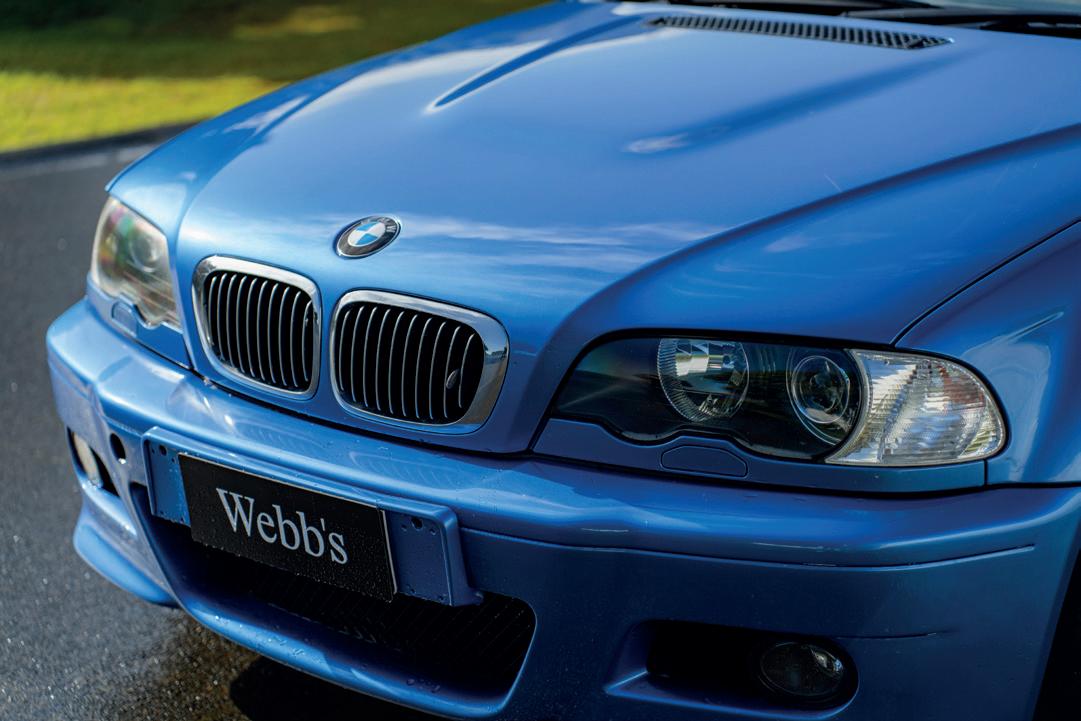 The vehicle will be sold registered and with a current WOF.
The vehicle will be sold registered and with a current WOF.

10 DAVE FRIEDMAN
The Legends of Motorsport
Limited edition of 350. Includes the signatures from motorsport legends: Chris Amon, Mario Andretti, Charlie Hays, Parnelli Jones, Phil Hill, Stirling Moss, Derek Bell, David Hobbs, Lother Motschenbacher, Jack Brabham, Brian Redman, Vic Elford, Jody Schecter, George Follmer, Denny Hulme, Jackie Stewart, Dan Gurney, Jacky Ickx, John Surtees, Jim Hall, Innes Ireland, Rodger Ward and Dave Friedman est $1,000 — $1,500

11 1962 Monaco GP Programme, signed by champion Phil Hill est $300 — $500
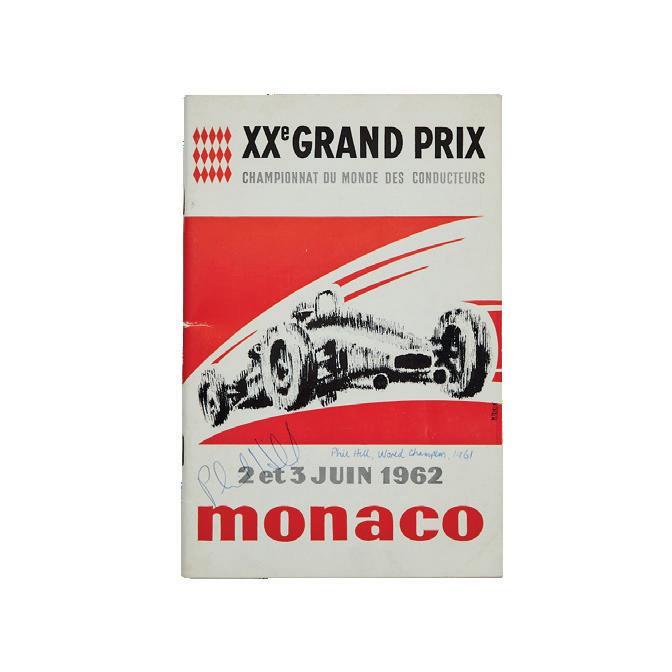
12 LYONS & HARNHOLDT Can-Am Cars in Detail (Publishers Edition) Detailing the racing series which brought Bruce McLaren much of his motorsport success and led the racing world in innovation, producing some of the sport’s most inventive minds. est $600 — $800
13
GAUTAM SEN Marcello Gandini: Maestro of Design Dalton Watson Fine Books Collectible: An ode to one of the greatest of car designers, Marcello Gandini. est $500 — $1,000
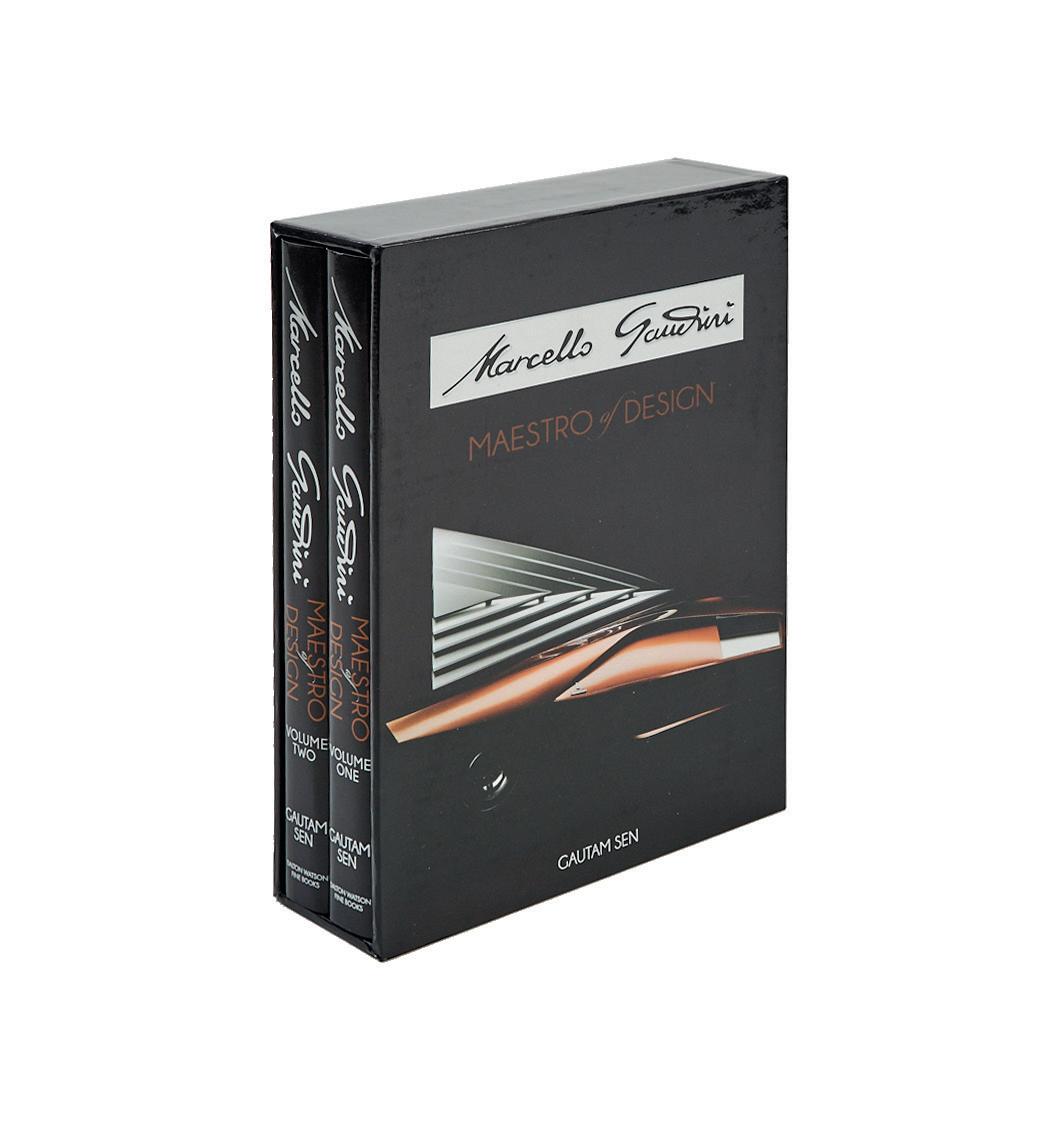

14 Tag Heuer F1 Helmet Clock Movable face shield that commemorates TAG Heuer’s sponsorship of various F1 seasons or racing-car drivers in the 1970s and 1980s. A red helmet mimicking that worn by Niki Lauda for Ferrari during the 1976 F1 season bears sponsorship decals from Römerquelle, Marlboro, and Goodyear. A Heuer quartz clock with Swiss movement is fitted into the helmet, working. H117mm est $1,000 — $2,000

15 Mobil Oil Flange Sign C. 1920s – Early branding: Gargoyle MobilOil, patina. H415 W500mm est $1,000 — $1,500


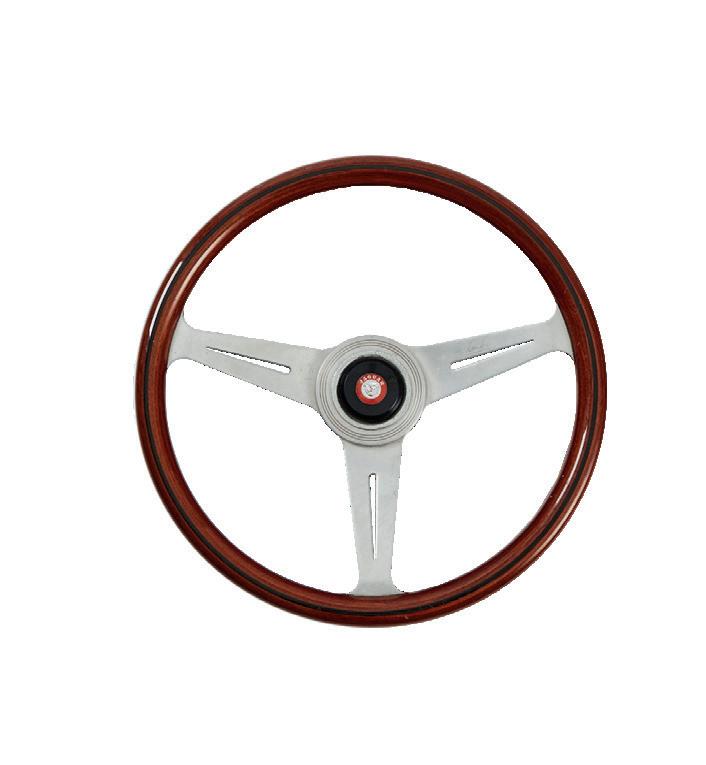





25 Two Leather and Fur Racing Hats Lined with fur. est $200 — $400

26 David Brabham Race Worn Suit Worn by David Brabham when he drove Brabham BT59 at Imola in 1990.

Provenance: Purchased Sotheby’s, 1997 est $600 — $1,200
27 ERG Batteries Shop Display
Painted wrought iron. Australian battery manufacturer from Sydney. Rarely seen brand in New Zealand. H830 W810 D220mm est $600 — $1,000

Engine: ELVA CF 45611


Chassis: 19544A
est $65,000 — $75,000

Buckler Cars, founded by C.D.F. Buckler based in Reading, England, produced approximately 400 cars between 1947 and 1962. Among them, the Buckler 90 stands out as a rare and distinctive sports car that holds a special place in automotive history. It was specifically designed to offer lightweight and agile performance, delivering exhilarating driving experiences to its owners.
One of the key features that set Buckler cars apart was their unusual construction, utilising a spaceframe design. This rigid and lightweight structure consisted of interlocking struts arranged in a geometric pattern, providing both strength and efficiency. The result was a car that offered nimble handling and impressive performance. The minimalist and purposeful design of the Buckler 90 exudes a sense of vintage charm and timeless appeal. Inside the cockpit, the focus remains on the driver, with a simple layout and minimal distractions. The low and sporty seating position further enhances the connection between the driver and the road, ensuring a thrilling driving experience.
Buckler cars were known for their high quality, and could be supplied either fully built to order with a works body or in component form for home completion. This flexibility allowed buyers to create
a lightweight sports car suitable for both road use and various motorsport events such as rallies, trials, speed hill climbs, and racing.
During the 1950s, Buckler cars were exported globally, including to New Zealand, where Arthur Harris managed Buckler NZ Limited. Notably, the first Mk90 registered for racing in New Zealand in October 1956 was owned by Merv Mayo and powered by a Ford 100E engine (1172cc). In New Zealand, the bodies were designed by Ferris de Joux, a highly skilled automotive designer, engineer, and constructor of sports cars.
The specific Buckler 90 being discussed was originally constructed by Alwyn Marshall of Pukekohe between 1954 and 1958. It achieved success in sports car races under 1,500cc from 1958 to 1962. After passing through several owners, the car was discovered in a derelict state near Whangarei in the early to mid-1980s. It was then meticulously restored by Bruce Sutcliffe between 1984 and 1987, allowing the Buckler to return to racing at Classic, Historic, and Vintage race meets between 1988 and 1991. In 1993, it was purchased by its current owner, who converted it to be road legal. Since then, the car has continued to be raced and rallied in various historic events. Owning and driving a Buckler
90 provides a unique opportunity to experience the thrill and nostalgia of a true classic sports car.

With its timeless design, exhilarating performance, and rarity, the Buckler 90 continues to captivate automotive enthusiasts who appreciate the beauty and craftsmanship of vintage automobiles.
Specification
• Chassis: Buckler constructed Space frame
• Suspension: Buckler modified Ford 10, fitted with Alva overhead conversion.
• Bodywork: Ferris de Joux Mark 1
• Engine: Ford 100E with Elva crossflow head
• Carburation: Weber (2 x 42mm)
• Gearbox: Ford 10, 3 speed, with Buckler close ratio gears
• Differential: Ford 100E with Buckler high ratio
• Exhaust: Four pipe extractor
• Wheels: Modified Ford 10 - Front 14” / Rear 15”
• Performance: Top Speed 169kmph (105mph)
• Standing Quarter mile: 17.8sec
Engine: TBC
Chassis: WBSAK07000AC79427
est $320,000 — $350,000
The legendary Sport Evolution stands as the ultimate and most refined variant of the original E30 M3 lineage. A mere 600 Sport Evolutions, also known as EVO III, were produced between December 1989 and March 1990. They were exclusively offered in Brilliant Red or Jet Black and featured the revered S14 engine, but this time in a 2.5-litre configuration. The result was a power increase to 238bhp at 7000rpm and 349Nm of torque at 4750rpm. The Sport Evolution boasted unique bodywork, including modified front wings, adjustable front and rear spoilers, two-tone 16-inch wheels, the removal of the touring fuel tank, a longer 3.15-1 differential ratio, a suede steering wheel and gear knob, red seat belts, and Recaro front seats with harness holes ready for action.

This particular example was originally delivered new in Milan, Italy, and registered there on October 28, 1998. It is likely that the vehicle was sold by the prominent local BMW concessionaire, the French-owned BYmyCAR Group. While limited information is available about its time in Italy, our understanding is that the car was subsequently acquired by a BMW collector based in the United Kingdom. Our vendor purchased the vehicle from the UK collector and registered it in New Zealand on June 26, 2021.
The leather interior, Brilliant Red paintwork, and suede steering wheel present themselves in impeccable condition, akin to brand new. The vehicle comes with a service book, and the Michelin Pilot Sport tyres show minimal signs of wear. The touch-up paint kit is
even included, and the car has a mere 69,000 kilometres on the odometer. Additionally, this vehicle was featured in the May 2023 edition of New Zealand Autocar magazine.
Regarded as the definitive embodiment of the Group A era, this exceptional vehicle has often been hailed as the most successful road racing car in history. It presents a fortunate opportunity for the next owner to acquire a true automotive gem.
The vehicle will be sold registered and with a current WOF.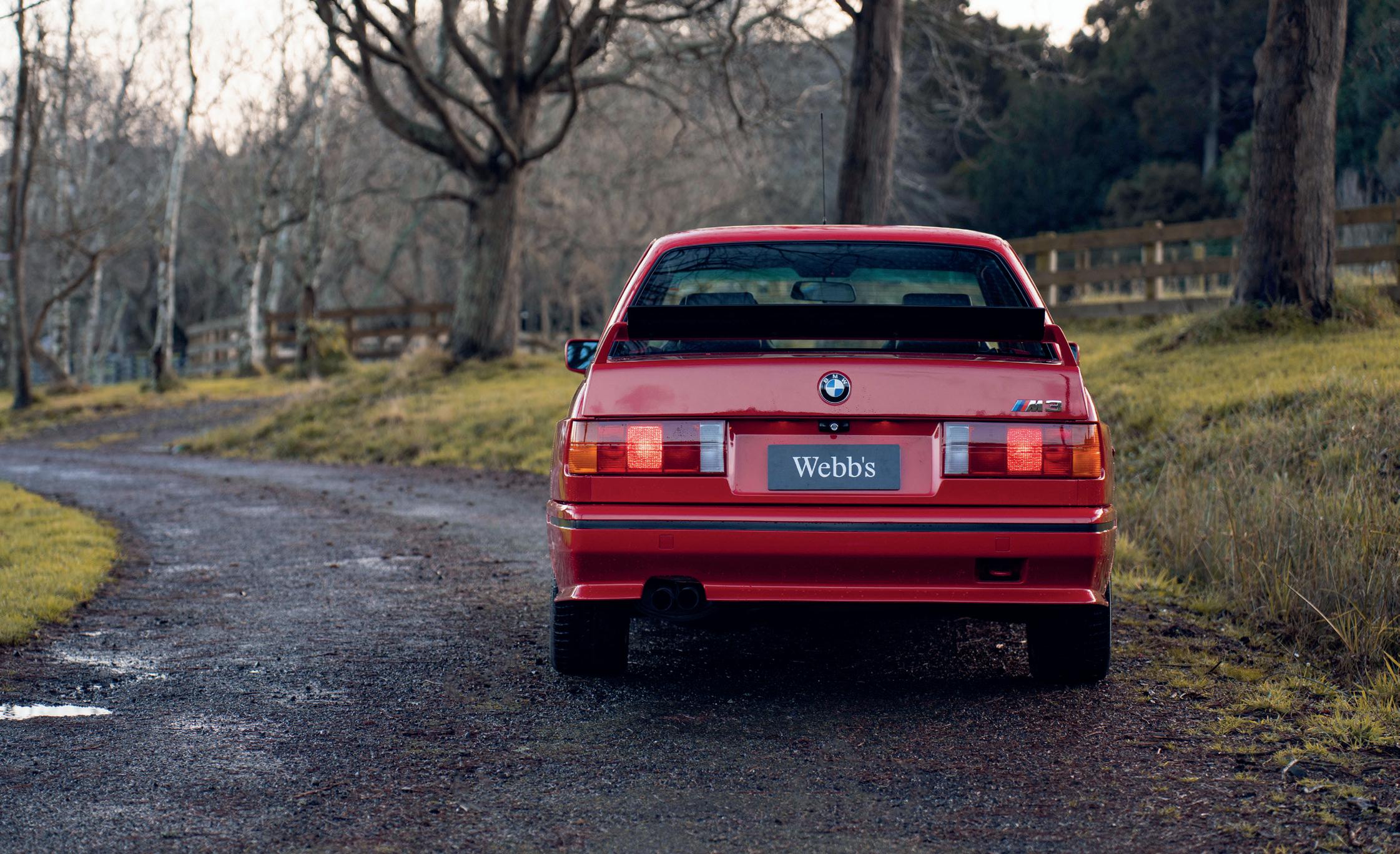




Engine: TBC
Chassis: SCFAA111JVK101537
est $50,000 — $60,000
The DB7 was the first model to be introduced after the Ford Motor Company acquired Aston Martin in 1987 — playing a pivotal role in reviving the brand’s fortunes during a challenging period in the company’s history. Designed by Ian Callum, the DB7 is a masterpiece, crafted in the same factory as the Jaguar XJ 220. Its sleek and aerodynamic shape was inspired by the DB4 and DB5 models from the 1960s. The long hood, elegant curves, and a distinctive front grille all exuded a sense of timeless elegance.

Powered by a supercharged 3.2-litre inline-six engine, which provided impressive performance and a distinctive engine note, mated to either a five-speed manual or, like this one, a five-speed automatic transmission, with 335bhp at 5750 rpm. The suspension was tuned to provide a balance between sportiness and long-distance touring comfort, making it an excellent grand tourer for both spirited driving and extended journey.
The bodywork is finished in green
with a tasteful complementary green and tan interior. Upholstered and trimmed with care at the car’s spiritual home in Newport Pagnell, this vehicle boasts an impeccable pedigree. With its steel monocoque body, the DB7 has earned its place as one of the most stunning cars of the late 20th century.

This example was delivered new to Japan and was first registered in New Zealand in 2002. It has had approximately four owners here and currently sits with 103,000kms in the odometer. The service history is stamped in the service book. The sale also comes complete with an Aston Martin jacket and accessories.
This Aston Martin DB7 is a remarkable example of automotive excellence, blending timeless design, superb craftsmanship, and an impressive performance heritage. Its rarity, exceptional condition, and meticulous service history make it a highly desirable addition for any discerning collector or Aston Martin enthusiast.
Engine: AM16/30604
VIN: SCFHCDAJ8BAF01955
est $100,000 — $120,000
First unveiled as a concept car at the 2006 Detroit Auto Show, the Aston Martin Rapide combined elegant design, exceptional performance, and refined craftsmanship.
Designed by stretching the DB9 to accommodate an extra pair of doors, and widening the rear of the car, a more balanced impression is conveyed through its curvaceous design language. Despite the sporty nature it can comfortably accommodate four adults, making it suitable for long journeys or daily commuting, which is rare for an Aston.
Aston Martin design director Marek Reichman attributed the design inspiration for the marques first four door car to the powerful appearance of a thoroughbred racehorse — hoping to capture the impression of muscles visible through the skin in the Rapide’s lines. A very capable racer, the Rapide finished 2nd in its class at the 2010 24HoursoftheNürburgring
The car’s aerodynamic shape not only enhances its visual appeal but also contributes to improved handling and stability at high speeds. Inside, the Rapide offers a luxurious and comfortable environment for both the driver and passengers. Premium materials, including fine leather, exquisite wood trims, and polished metal accents, adorn the interior. The cabin is thoughtfully designed, incorporating modern technology and amenities such as a Bang & Olufsen 16-speaker sound system, Bi-xenon headlamps and a tilt-telescoping steering wheel, all of which enhance convenience and driving pleasure.

Under the bonnet, the Rapide is powered by a formidable 6.0-litre V12 engine. This naturally aspirated powerhouse delivers exhilarating performance, producing an impressive output of around 470 horsepower. The engine is paired with a six-speed Touchtronic II automatic transmission on rear wheels, providing seamless shifts and responsive acceleration.
In terms of performance, the Aston Martin Rapide V12 6-litre delivers impressive acceleration and handling capabilities. It can accelerate from 0 to 100 kmph in just over 5 seconds, with a top speed of a dizzying 303 kmph. The car’s suspension is tuned for a balance of comfort and agility, allowing for a smooth ride while maintaining precise handling and responsiveness.
This New Zealand-new example has had just one owner. It shows 56,509kms on the clock, comes complete with service history, and is fitted with a radar detector. As with all Aston Martin vehicles, the Rapide represents a blend of luxury, performance, and craftsmanship. It is a statement of style and refinement, offering a thrilling driving experience with the practicality of a four-door sedan.
The vehicle will be sold registered and with a current WOF.





Engine: 4002846V
Chassis: DB62869R
est $750,000 — $825,000
Introduced in 1965 as the successor to the iconic DB5, the DB6 marked the end of the renowned David Brown ‘DB’ line of Aston Martins. Among enthusiasts of the brand, it is often regarded as the final embodiment of the authentic Aston Martin experience. To address the need for increased headroom and legroom, the factory extended the wheelbase by four inches while giving the DB6 a more streamlined appearance with a sloping windscreen, raised roofline, and redesigned rear quarter-windows.

Unveiled at the Paris and London Motor Shows in 1965, the DB6 maintained a clear lineage with the Touring-designed DB4 from 1958. Despite its larger appearance, the weight of the new model was only marginally increased. The most noticeable change was the introduction of a Kamm-style tail and a spoiler that improved aerodynamic efficiency.
This particular DB6 was imported into New Zealand in 1983 by a returning resident. Currently, it is in the possession of its third owner in New Zealand, who acquired the car in 2007 in its original condition. After driving it for 18 months, the owner noticed that the engine was in need of attention. Thus, in early 2009, they embarked on a meticulous and comprehensive 13-year restoration project, sparing no expense. Extensive documentation, including photographs and receipts, attests to the thoroughness of the restoration.
Notably, the engine was fully rebuilt, increasing its displacement from 4.0 to 4.2 litres. The block was machined by JMB Services, a specialist in the UK, and the rebuild incorporated various improved components from JMB. The 5-speed ZF gearbox and limited-slip differential were also rebuilt. The car underwent a conversion to electronic fuel injection using Jenvey Heritage Throttle Bodies, designed to replicate the appearance of the original Weber carburettors. The original fuel system components, including the Webers, are still with the car. Additional enhancements include the installation of twin electric fans to prevent overheating in New Zealand’s summer traffic; electric power steering from GTC Engineering with a new, smaller steering wheel; an upgraded wiper motor with intermittent function; enhanced brake boosters and new brake lines; Quikfit retractable seat belts;



a new stainless steel exhaust with improved “Jet-coated” headers; and new stainless-steel bumpers, heat deflectors, and screens. The suspension was upgraded with Harvey Bailey components (including Konis and an uprated sway bar), and Aston Engineering improved lever arm dampers at the rear (with the original Armstrong Selectarides still retained). New rubber seals were applied throughout the car.
All necessary replating was performed on the brightwork, ensuring that all surfaces match the factory specifications. For modern convenience, a Bluetooth-connected stereo system was discreetly integrated into a customised centre console. Stainless steel fasteners were used throughout the restoration, except where higher tensile strength or chrome screws were required. Minor rust in the driver’s side footwell, above the master cylinders, and in the sills was treated and repaired, while all other sills and chassis cavities were rust-proofed. The underside, engine bay and boot received a two-pot epoxy treatment, followed by a textured black overcoat in the wheel arches. Heat and acoustic paint systems (two separate treatments) were applied to the interior using “Lizard Skin” products. The body was refinished in Aston Martin’s periodcorrect ‘Old English Pewter’ colour. Inside, the car features a new OEM headlining, re-trimmed sun visors, new Wilton carpets, and re-trimmed leather in the correct OEM Connolly Vaumol black leather where necessary. The dashboard and glovebox well were also refurbished. The current owner describes the car as a “very strong performer” that handles “exceptionally well”.
The sale includes the original parts, build sheet, and some spare components. The odometer currently shows 80,319 miles. It is worth noting that it is not uncommon for DB6 Vantage engines to be rebuilt to 4.2 litres, and many restored examples exist worldwide with this upgrade, which is often preferred by drivers.


In conclusion, vintage Aston Martins are widely recognised as resilient investments, akin to blue-chip assets, and this DB6 exemplifies that trend. Owning a Newport Pagnell model is a special privilege, and this particular car’s status as one of only 268 right-hand drive Mk1 models produced in the coveted Vantage specification further adds to its desirability. As Motor Magazine concluded, the DB6 stands among the “most extraordinary sports cars ever tested”, reaffirming its allure and exceptional quality.




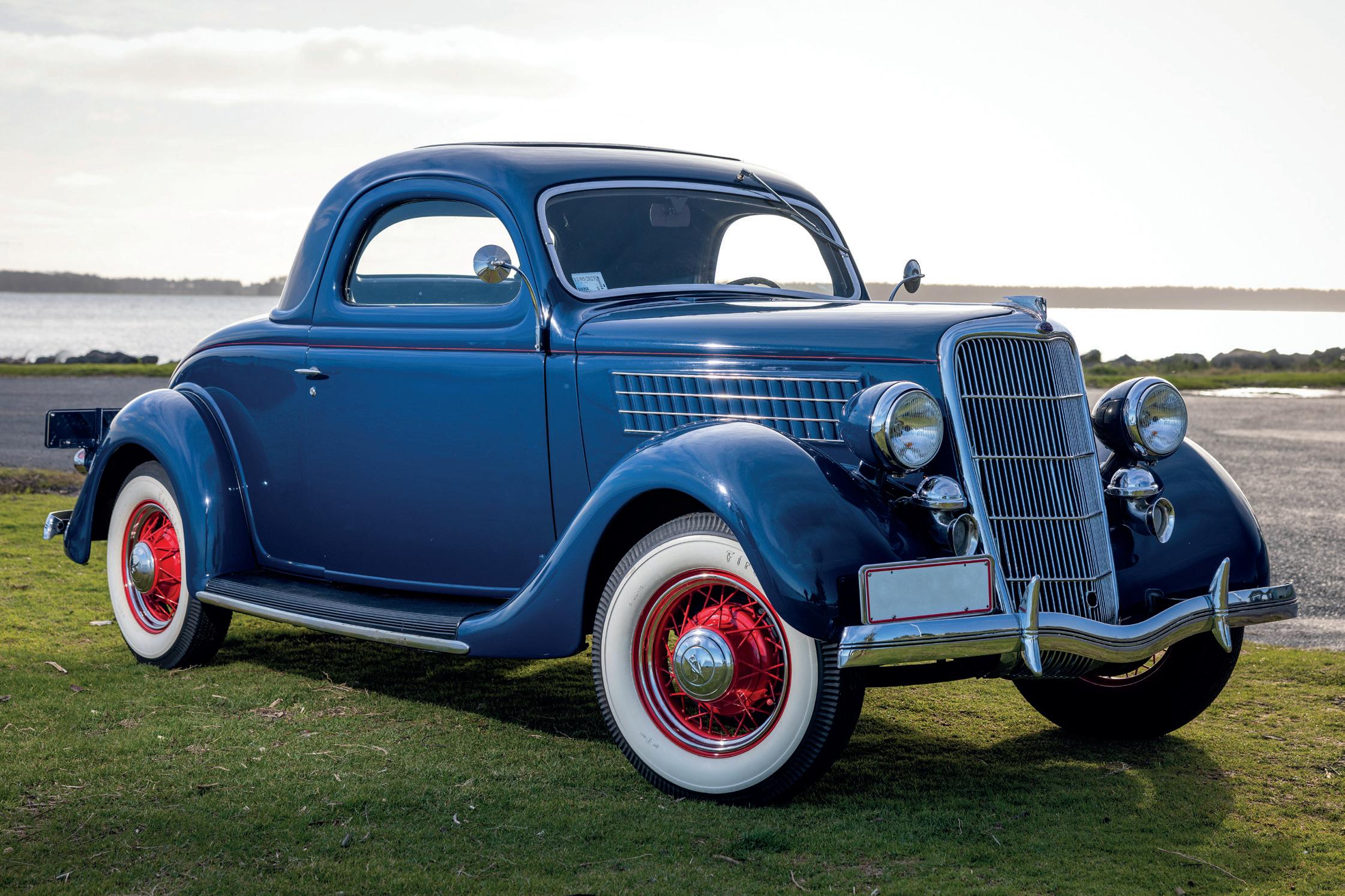
Engine: TBC
Chassis: 18141054
est $160,000 — $200,000
The Model 48 Ford, also known as the Ford V8, is an iconic automobile produced by Ford Motor Company. It is significant as the first Ford car to feature a V8 engine, which brought increased power and performance to the mass market.
The Model 48 Ford line-up had many changes from the outgoing 1934 model, both stylistically and technically. It featured revised front suspension and engine placement to afford more interior room and comfort. It was also the first year that Ford’s legendary Flathead V8 was the sole engine option, marking the end of the four-cylinder carried over from the Model A. Introduced in 1932, the side-valve ‘flathead’ V8 was the first affordable, mass-produced V8. Regarded as one of the greatest and most important engines of the 20th century this 3.6 litre motor produced 85 horsepower and 195 Nm – an increase of 10 horsepower over its 1934 variant.
Visually, the Model 48 features a lowered body, extended front grille, smoother integrated fenders, and a curvier, more aerodynamic body. Several body styles were offered, including body 720, the sporty 3-window coupe. Arguably the least practical and most dramatic option with exaggerated
proportions and curves, the overall design was influenced by the Art Deco aesthetic of the time. The three-window coupe enjoyed a production run of 30,000 units.

This particular vehicle was imported from the USA and registered here on 15 February 2018. A renowned Auckland independent shop conducted the VIN process, installed a cut-out switch, increased voltage to 12V, fitted new twin carbs, undertook an oil change and tuned it. The car has hydraulic brakes, a power generator, and the Mercury 8BA motor — now fitted with Offenhauser heads — delivers an output of 100bhp.
The Model 48 Ford proved to be a significant success for the Ford Motor Company. The combination of increased power, attractive styling, and affordability appealed to buyers, making the Model 48 Ford a popular choice. Its success helped solidify Ford’s reputation as a leader in the mass-market automobile industry. Presented in immaculate condition, this coupe offers a great opportunity to acquire a well sorted automobile featuring Ford’s legendary flathead V8 in a beautifully left-hand drive elegant body.
The vehicle will be sold registered and with a current WOF.
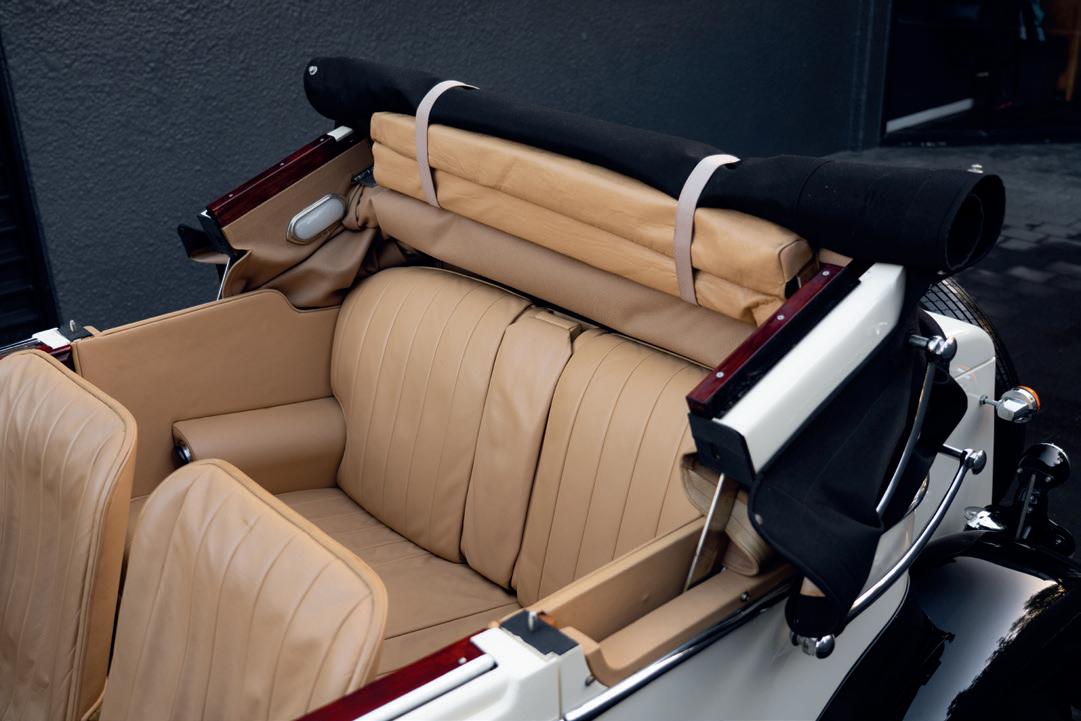
Engine: A5H
Chassis: GNS30
est $110,000 — $130,000
This handsome Rolls was originally delivered new in 1930 to George Health Motors Ltd, Birmingham, and subsequently sold to Mrs Palethorpe of Edgewood who was resident of Stone Manor, Kidderminster. The handsome 56-room country pile was designed by the architect Edwin T. Hall, who also designed Liberty’s department store in London. The Palethropes were once dubbed ‘the world’s largest sausage producer’. A copy of the original order reference and build specification comes complete with the sale.
Originally, this car was a 1930 20/25 Rolls-Royce. Mrs. Palethorpe paid £999 for the chassis, and the body was an additional expense on top of that. Factory cards and drawings for most pre-war Rolls-Royce cars were rescued by members of the UK RR club when they were slated for disposal. The build card meticulously details all the parts used, with the “LOP” (List of Parts) identifying everything from the crankshaft onward and noting the individuals involved in the work. This ensures the car’s authenticity and traceability.
The 20/25 model started as a designated 20hp car, targeting the “economy model” niche already occupied by makers like Sunbeam, Vauxhall, and Armstrong Siddeley. It was a step below the 40/50 series cars (Silver Ghost and later Phantoms), which had a slower pace in terms of development. Yet, due to the reverence for the Rolls-Royce name, the 20hp model proved remarkably successful, even within this challenging segment, selling nearly 3000 examples. Even more of the later 20/25hp chassis were sold, reaching a total of approximately 7,000 units.
We’re uncertain when this car arrived in New Zealand but it is estimated to have been some time in the late-1980s. A few years later our vendor purchased the Rolls and set about
a decade-long restoration which was completed in 2003. The vendor planned to build a drophead coupe. The car came with a rather unattractive body, labelled as a Sports Saloon, which was not the original Barker Sedanca De Ville body. Determined to achieve his vision, he utilised resources gathered from the UK club to produce full-sized drawings, which his brother, skilled in boat-building, used to create the framing for a replica Park Ward-style four-seater coupe. This frame was then expertly panelled in aluminium by Alan Bowden at Classicar Restorations in Auckland.
From any angle, this car exudes an imposing presence. It is not difficult at all to imagine it sitting at Stone Manor. A narrower focus reveals numerous glimpses of excellence in the details. The motor and engine bay on both sides showcase a busy yet well-organised treatment of ancillaries, wiring, and control rods. These elements are beautifully executed, reflecting engineering excellence that remains easily comprehensible and followable for those moderately knowledgeable. One of the main features is the famous radiator, composed of a core directly connected to the shell, with the header tank integrated into the top. The crucial louvves in front are operated by control rods from the dashboard. In fact, a significant amount is controlled via adjustable rods, including spark advance, fuel mixture, and the magneto. A testament to the quality of engineering principles applied is the absence of any ‘lost’ movement. Polished mahogany, Wilton carpet, leather seating and panels, and ivory and brightwork appointments create an atmosphere of luxury and opulence.


Engine: 18110727
Chassis: 18110727
est $95,000 — $105,000
The 1934 Ford Tudor is a captivating twodoor sedan with a closed-roof design. Its stylish and sleek body, reminiscent of the Art Deco period, features a distinctive shape characterised by smooth lines and rounded edges. Compared to earlier Ford models, the Tudor exhibits a longer, lower, and more streamlined appearance.

When Henry Ford introduced the Ford version of the V8 engine in 1932, it was not a novelty, but never before had such an engine been produced successfully in large numbers and at such an affordable price. The Tudor model is equipped with a remarkable 3.6-litre Flathead V8 engine. This engine, commonly referred to as the “L-head” or “flathead” due to its valve-inblock design, represented a significant advancement during its time. It delivered approximately 85 horsepower, offering sufficient power for the era. The V8’s running gear was further improved with the introduction of a new X-member double-drop chassis on a longer 112inch wheelbase in 1933. Additionally, the Tudor incorporated a solid front axle
and leaf spring suspension, providing a relatively smooth and stable ride capable of handling the diverse road conditions of the time.
Inside the Ford Tudor, the focus was on comfort and functionality. It offered seating for up to four passengers, featuring comfortable bench seats. The dashboard displayed a straightforward layout, with gauges and controls conveniently placed within easy reach of the driver.

The Tudor holds high regard among classic car enthusiasts and collectors, being hailed as an iconic model. Its sleek design, advanced V8 engine, and association with the hot-rodding era contribute to its popularity and timeless appeal. Moreover, the Tudor represents a symbol of American automotive history, reflecting Ford’s resilience and innovation during the challenging years of the Great Depression.
This particular left-hand drive example arrived in New Zealand from the USA in June 2015. Our vendor acquired it in Christchurch five years ago when it possessed a complete body but required engine work. The necessary
repairs and enhancements were carried out by a reputable independent shop in Auckland. The modifications included a new carburettor, conversion to a 12V power system, reconditioning of the steering box, and installation of a highgeared differential.
Overall, this 1934 Ford Tudor boasts an excellent and reliable V8 engine, making it a desirable and trustworthy classic car option for enthusiasts and collectors alike.
The vehicle will be sold registered and with a current WOF.


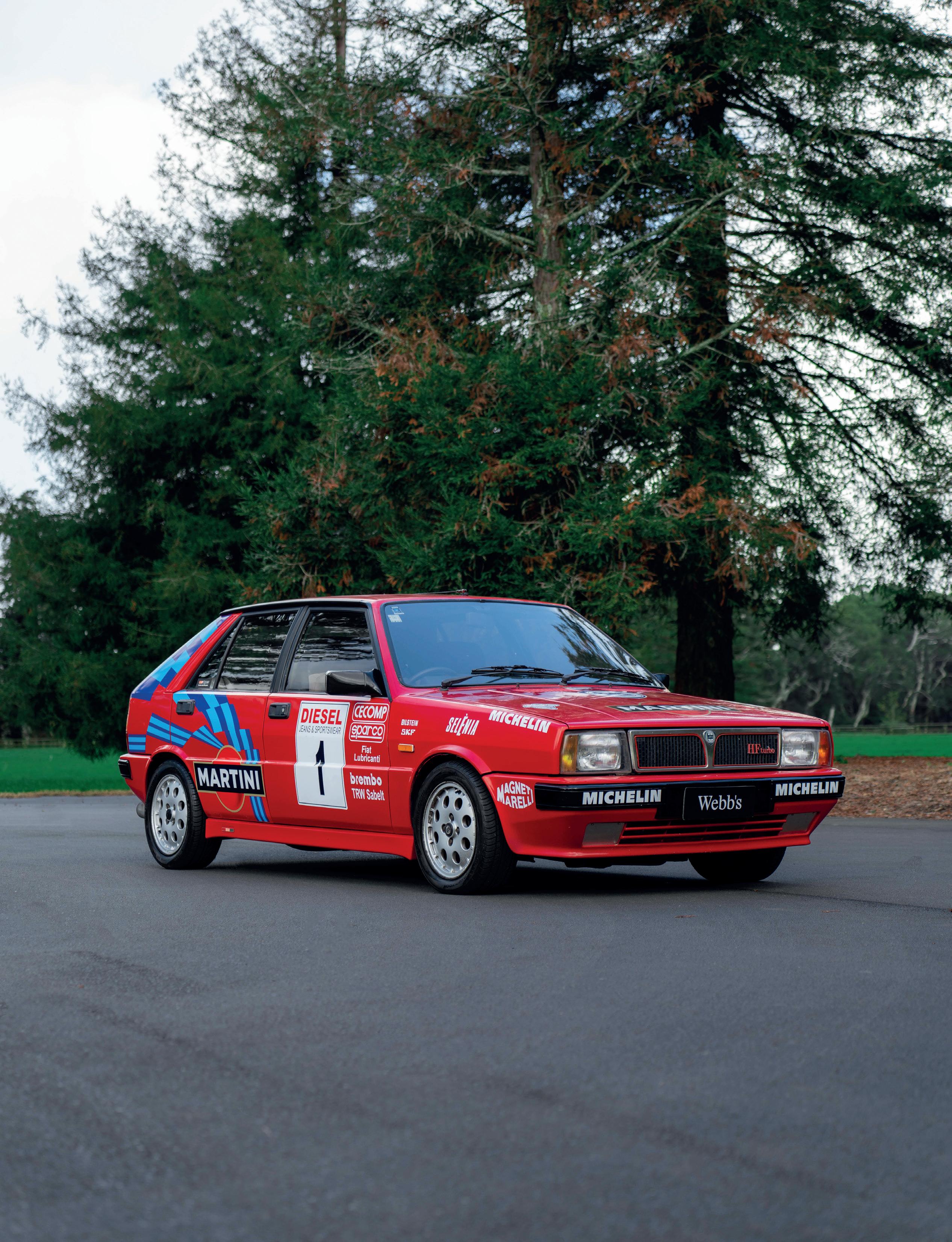
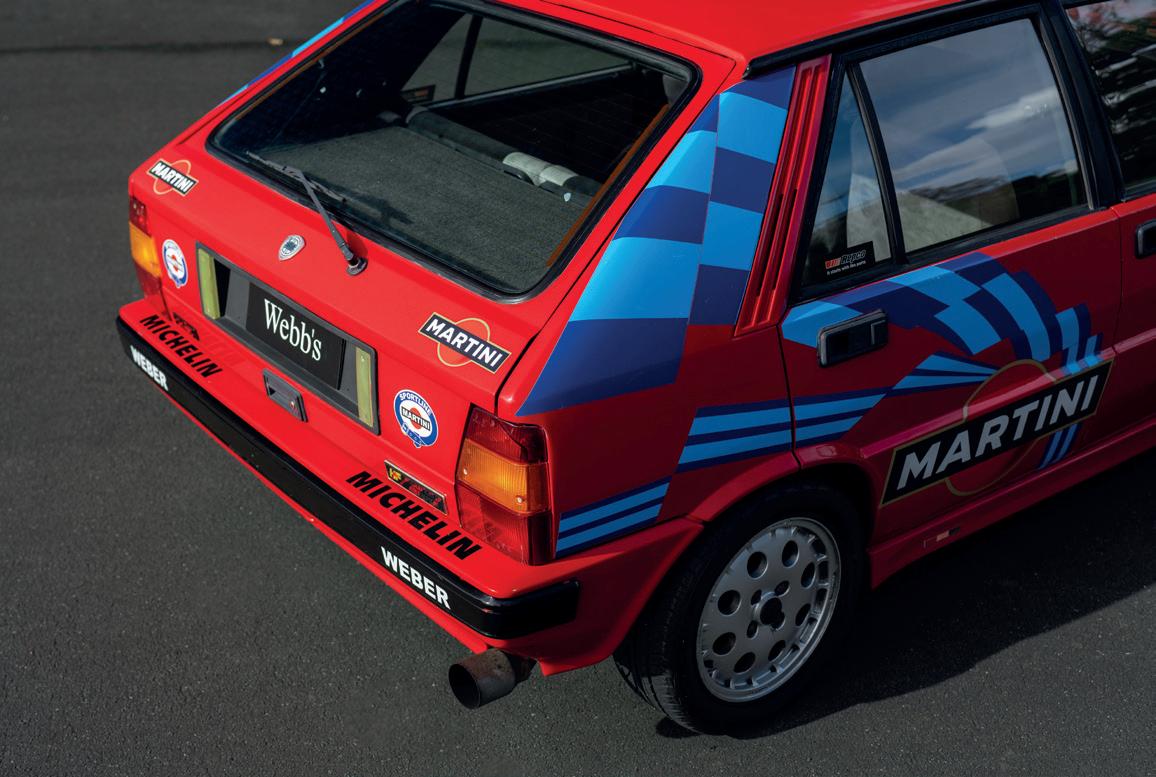
Engine: 0725346
Chassis: ZLA831AB000393062
est $15,000 — $20,000
Designed by Giorgetto Giugiaro, the Lancia Delta debuted at the 1979 Frankfurt Motor show to great acclaim, winning the 1980 European Car of the Year award among numerous other accolades. Selling 43,000 units in 1980, and over 100,000 units by 1982, the Delta was a very popular vehicle and one of the forerunners of the “Hot Hatch” revolution, a fad that has persisted to this day with cars such as the GR Yaris and Ford Focus ST as popular as ever.
The now mythological Delta received such status from its unparalleled rallying success: six consecutive World Rally Championships and four driver’s titles between 1987 and 1992. It remains the most successful marque in the history of the WRC.
The performance-oriented HF (high-fidelity) was introduced in 1983. It was powered by a 1.6-litre turbocharged inline-four, producing 138bhp, which is delivered to the front wheels through a five-speed manual transmission. To facilitate the extra power, the HF featured increased oil capacity, an oil cooler, and sodium-filled valves in the cylinder heads. Weighing in at approximately
1,000 kilograms, the HF Turbo was able to achieve a spritely 200 kmph top speed and a 0-100 time of 8.0 seconds.

Being, essentially, a front-wheel drive version of the later HF Turbo 4WD, which spawned the Integrale model, the HF Turbo is the lighter and nimbler father of the iconic line, being approximately 150 kgs lighter than its 4WD sibling and a full 230 kgs lighter than the later Integrale. Lacking the complicated permanent 4WD system, the HF Turbo benefits not only from the weight savings but also in mechanical simplicity which spares the cheque book.
The 1986 facelift gave the HF Turbo the benefit of receiving the same trim as the HF Turbo 4WD, both within and out, except for its square headlights and single exhaust, which in typical Italian fashion produce a fantastic tone.
These cars are now extremely rare on our roads, with around 10 currently registered. Further to the point, this HF Turbo is a New Zealand new, right hand drive example, and features a mere 111,900 kms on the dial. It’s had some rust repairs in the lower sills and around the windscreen, along with the work on the
ignition. There is an aftermarket stereo fitted along, later wheels and some Intergrale car mats. The vendor notes that the car “drives and runs well.” It’s decorated with the Martini Livery which was created to celebrate the victory of Lancia ‘s 6th consecutive World Rally Championship title. Despite visible signs of wear through age and use, the car has good bones and offers an opportunity to add a Lancia Delta to your collection without the price tag of the Integrale. We here at Webb’s see this example as being a worthy early representative of the Delta dynasty and the direct forerunner to the legendary Integrale. If you are looking for a lightweight, fuel efficient, and very manageable enthusiast vehicle from one of Italy’s most renowned marques, this one is for you.
Engine: TBC
Chassis: BNR32-100301
est $230,000 — $250,000
The R32 GT-R NISMO is a high-performance variant of the Nissan Skyline R32 GT-R, which was produced by Nissan from 1989 to 1994. Nismo, short for Nissan Motorsports, is Nissan’s in-house tuning division responsible for developing performance parts and specialised versions of their vehicles.
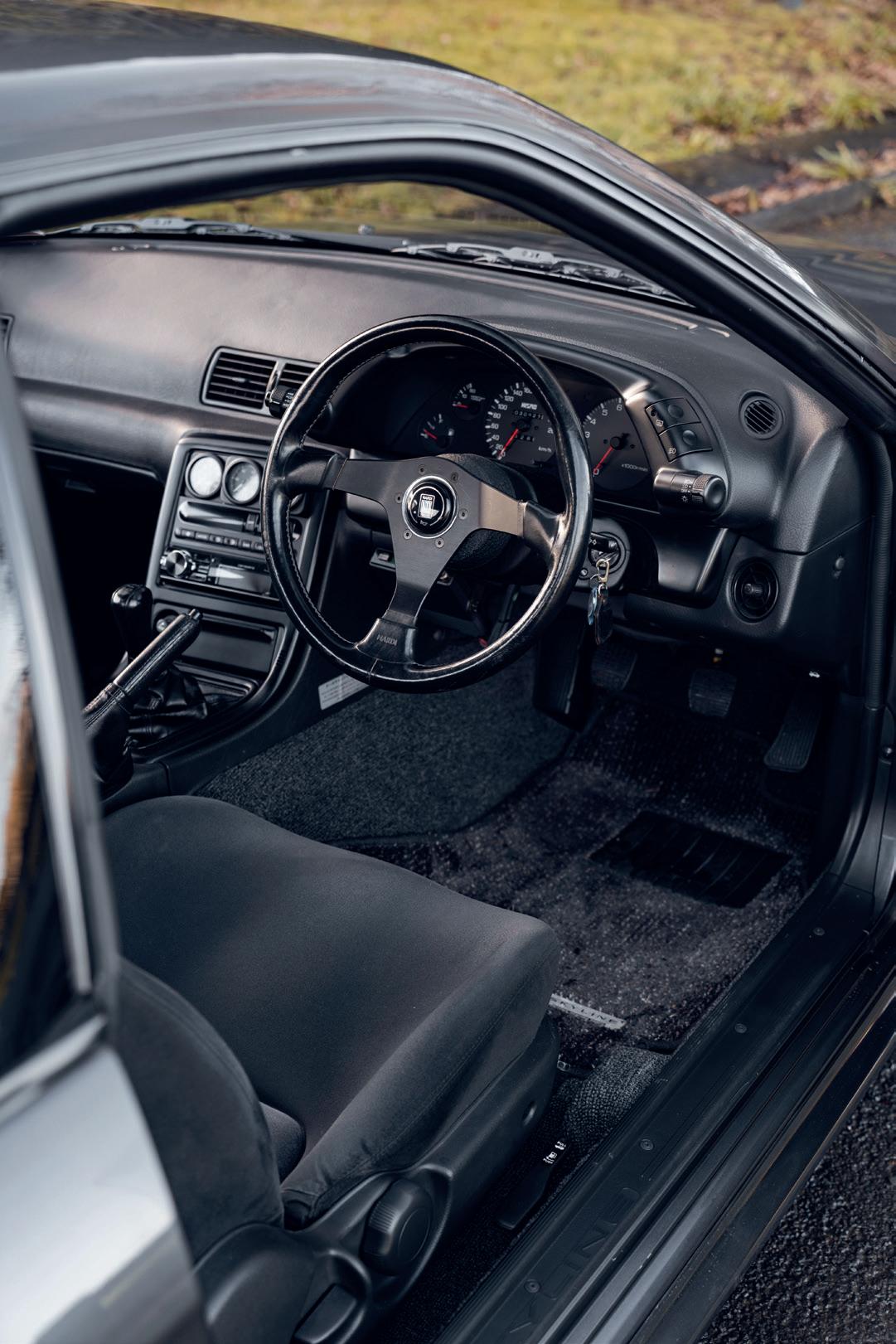
The R32 GT-R Nismo was introduced in 1990 and featured numerous upgrades over the standard GT-R model. It was designed to enhance the car’s performance capabilities and provide an even more thrilling driving experience. This is one of only 560 limited edition R32s introduced in February, 1990, to homologate several changes required to meet FIA regulations for Group A racing. Of the 560 built, 60 were sent to race in Group A and the other 500 were sold to members of the public. Performance changes applied to the Nismo Edition included the fitment of larger turbochargers, aerodynamic intercooler cooling ducts in the front bumper, deeper rear spats, an additional boot lip spoiler and grippier tyres. Of note however is the fact that the Nismo version was specified without both ABS and rear windshield wipers, resulting in a weight savings of approximately 40kg.
The R32 was only available in Gunmetal Grey Metallic paint and upholstered with grey velour trim, though visual differences compared to other Nismo renditions are minimal. The Nismo badge is present on the rear of the car. Powered by the famed twin-turbocharged 2.6-litre six-cylinder RB26DETT engine, this motor delivers over 206kW and 353 Nm of torque to all four wheels. A five-speed manual transmission was the only gearbox available on the R32 GT-R, allowing it to go from zero to 100kmph in 5.3 seconds.



This example is 301 of the 560, has covered 38,000 kilometres, and comes with its seemingly original spare plus a manual and fitted mats. Modifications include an ARC exhaust system, Mine’s coil overs, an HKS electronic valve controller, a strut tower brace, and Modena wheels. NISMO-specific bodywork includes a modified front bumper, a hood lip spoiler, an additional trunk lip spoiler, and side skirts with sill protectors. The carbon fibre front lip spoiler is an aftermarket addition. Interior mods include a leather-wrapped Nardi steering wheel, an HKS electronic valve controller, a Pioneer CD player, and Stack gauges mounted in the centre console. The car has been driven on a regular basis by the vendor, who believes that larger brakes may have been fitted by a previous owner, though this has not been verified. Fitted with 16” wheels.
The car was imported from the USA and registered in New Zealand March 2021. The previous American owner held it for four years before that. It is important to note that all these vehicles were only produced in right-hand drive, so there is no question of a conversion.
Our vendor, who is a collector of exotic sports cars spent a long time searching globally for a Nismo, and always had a desire to own one. Now that he has satisfied that craving he’s ready to pass it on to the next custodian. An example of this calibre will be a true asset to the next owner.
The R32 GT-R Nismo is considered an iconic and highly regarded sports car, known for its exceptional performance, advanced technology, and legendary status in the automotive world. It played a significant role in establishing the GT-R nameplate as a performance powerhouse and set the stage for subsequent generations of the GT-R lineage.
The vehicle will be sold registered and with a current WOF.
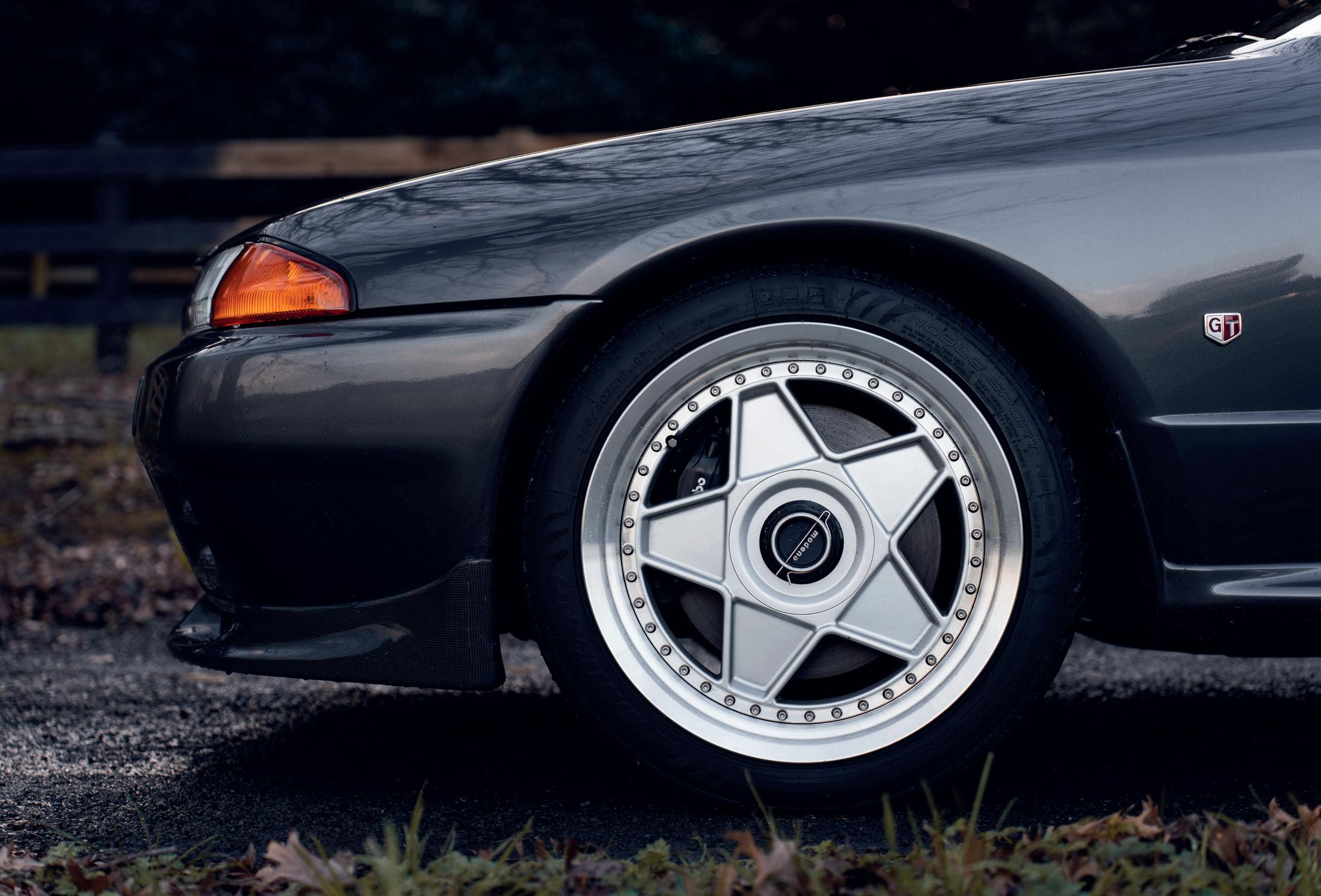

Engine: 6D52896F
VIN: C18BF14303
est $60,000 — $65,000
In the immediate post-war period Mercury’s were essentially dressed-up Fords, bridging the gap between the De Luxe and Lincoln-Zephyr ranges that prevailed at that time. The Mercury had a more modern and streamlined design compared to its pre-war counterparts, with smooth, rounded lines, integrated fenders, and a wider grille. The overall look was more aerodynamic and contemporary for its time. The interior of the Mercury was designed with comfort and style in mind. It featured spacious seating for five passengers, and the dashboard had a clean, functional layout.

Some 86,363 examples were manufactured through the 1947 Model year, with much of the advertising concerning the brand trumpeting its aircraft-inspired engineering and supposed fuel efficiency! The flathead V8 developed 100bhp at 3800 rpm. Heady figures at the time from a highly regarded car.
The original ownership papers verify that this New Zealand new example was first registered in Papakura on 22 September 1947 to a well-known Auckland merchant of the period. With fitted radio, 3-speed column gearshift, spotlights, and bench seats, this was a vehicle available to only a wellheeled few.
This example has been restored at some stage with an engine rebuild, along with a quality paintjob and white wall tyres, all creating a wonderful example of what driving in postwar New Zealand felt like. Recorded mileage now sits at 83,997 miles. A modern stereo has been fitted under the dash as the original doesn’t work but is still there. The vendor comments that it is “a lovely drive”, and notes it “does everything it’s meant to do”. He is only selling as he is running out of garage space after some other Webb’s Auction purchases!
The vehicle will be sold registered and with a current WOF.


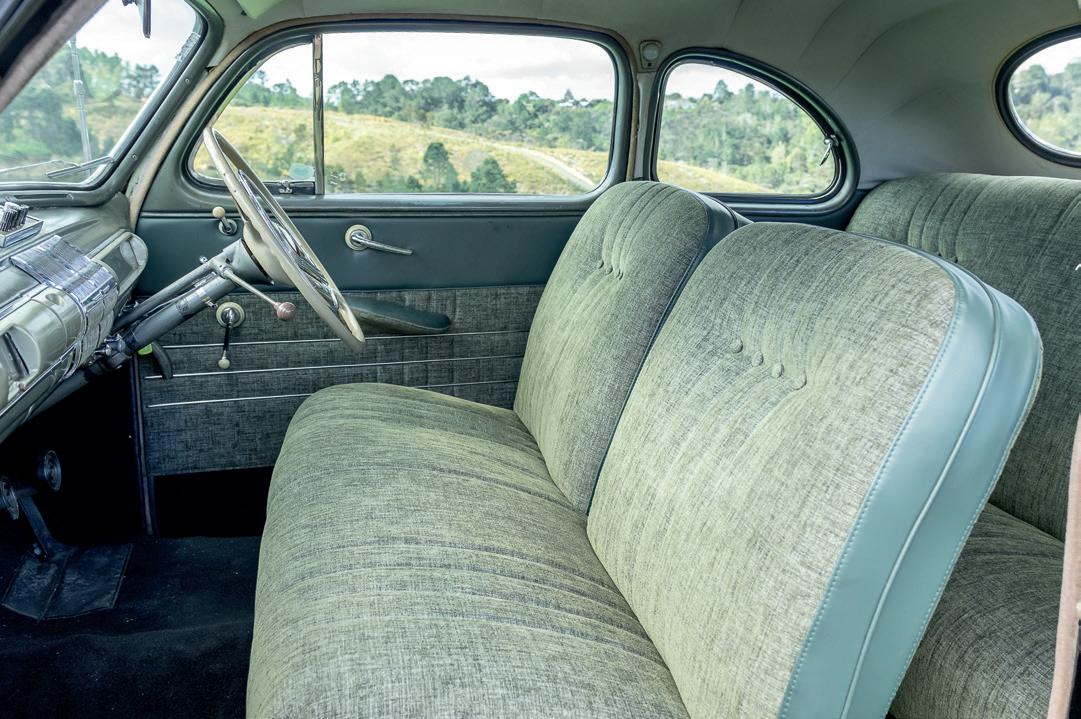
The Toyota Hilux has a long-standing legacy, dating back to its first production in March 1968. Over the years, it has earned a well-deserved reputation for being rugged, reliable, and versatile. Renowned for its durability, off-road capabilities, and adaptability, the Hilux has become a trusted choice for both commercial and personal use.
The sixth generation of the Hilux was introduced in 1997, offering a range of engine options to suit different preferences and needs. Its off-road prowess is legendary, thanks to features such as high ground clearance, robust suspension systems, and available fourwheel drive configurations. This makes it the ideal companion for adventurous enthusiasts and off-road lovers. With impressive payload and towing capacities, the Hilux can effortlessly handle heavy loads and trailers, thanks to its sturdy frame and strong chassis.
The 1999 model being presented here is equipped with a powerful 3.0-litre V6 engine and features the extended
‘Xtra Cab’ configuration. Our vendor is the fourth owner of this New Zealand new Hilux, having owned it since 2006. In 2019, an extensive restoration was undertaken, covering all aspects of the vehicle. The running gear, joints, universals, bearings, bushes, brakes, rims, tires, suspension, and shocks were all restored or replaced. The body underwent sandblasting and was painted in the original factory colour. Underbody and chassis treatments were applied, and new door seals, mirrors, wipers, and rear LED light clusters were added. The interior was refreshed with new upholstery and carpets. Additionally, the vehicle received new headlamps, a grill, an ARB bulbar package with a 5T winch and built-in air compressor, an LED light bar (linked to the high beam), and a new battery. The engine was meticulously inspected and underwent necessary maintenance, including new gaskets, mounts, timing belt, hoses, and consumables. The deck was fitted with new hardwood, a waterproof
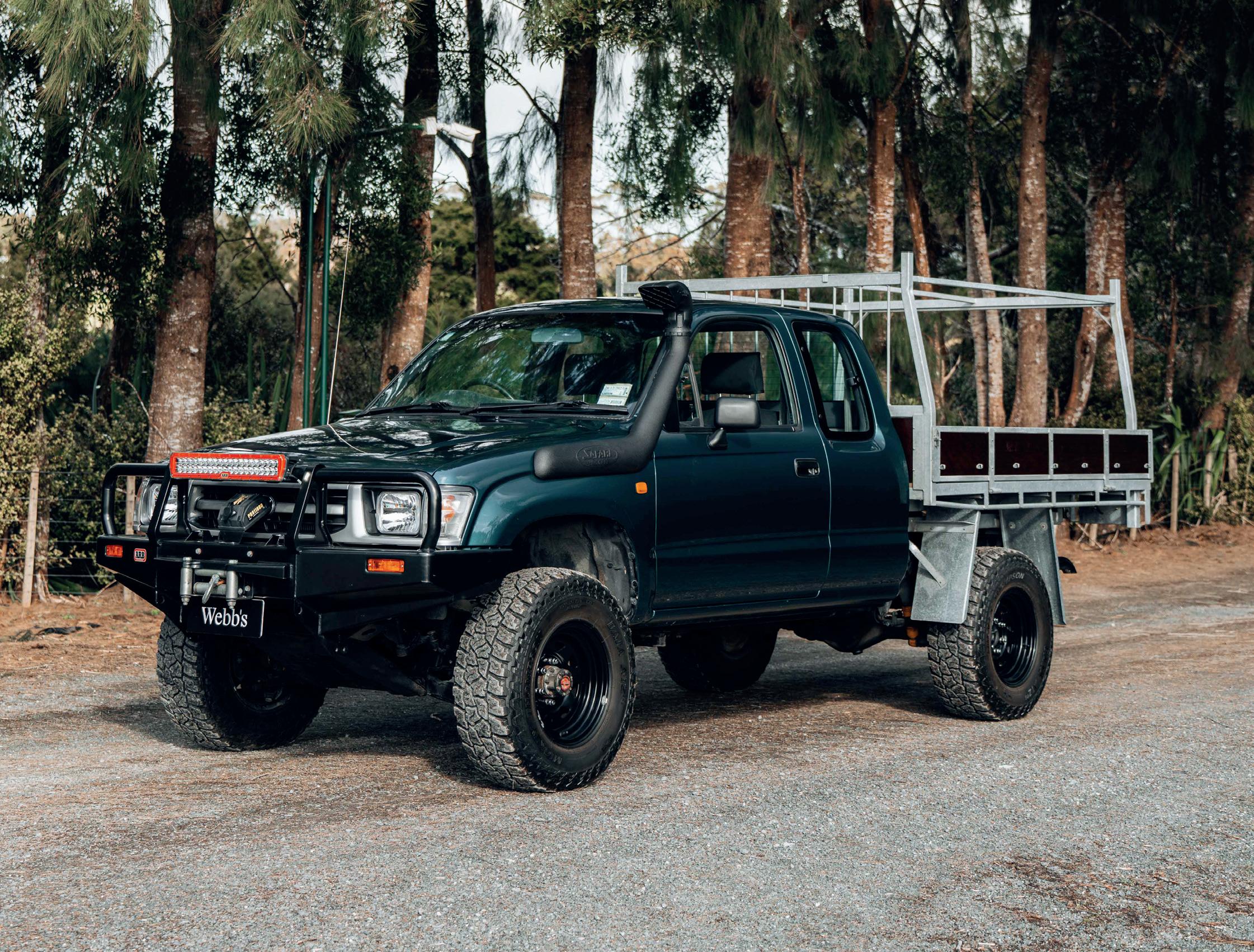
canopy, pipe rack, and hydraulic tipper mechanism. The rims and tires were refurbished, and the steering, brakes, turbo, air compressor, case breathers, and snorkel were all upgraded. The exhaust system and suspension were also enhanced, and all modifications have been certified. Modern comforts like a Bluetooth stereo, reversing light, and camera were added to further enhance the driving experience. With an odometer reading of 340,000 kilometres, the Hilux has only covered 3,000 kilometres since the comprehensive restoration.
The Toyota Hilux continues to be a highly sought-after option in the used car market due to its resilience, dependability, and versatility. Whether it’s utilised for work or leisure, the Hilux has proven itself as a capable and enduring pickup truck. With its exceptional off-road capabilities and reliable performance, the Hilux has garnered a loyal following worldwide.
The vehicle will be sold registered and with a current WOF.
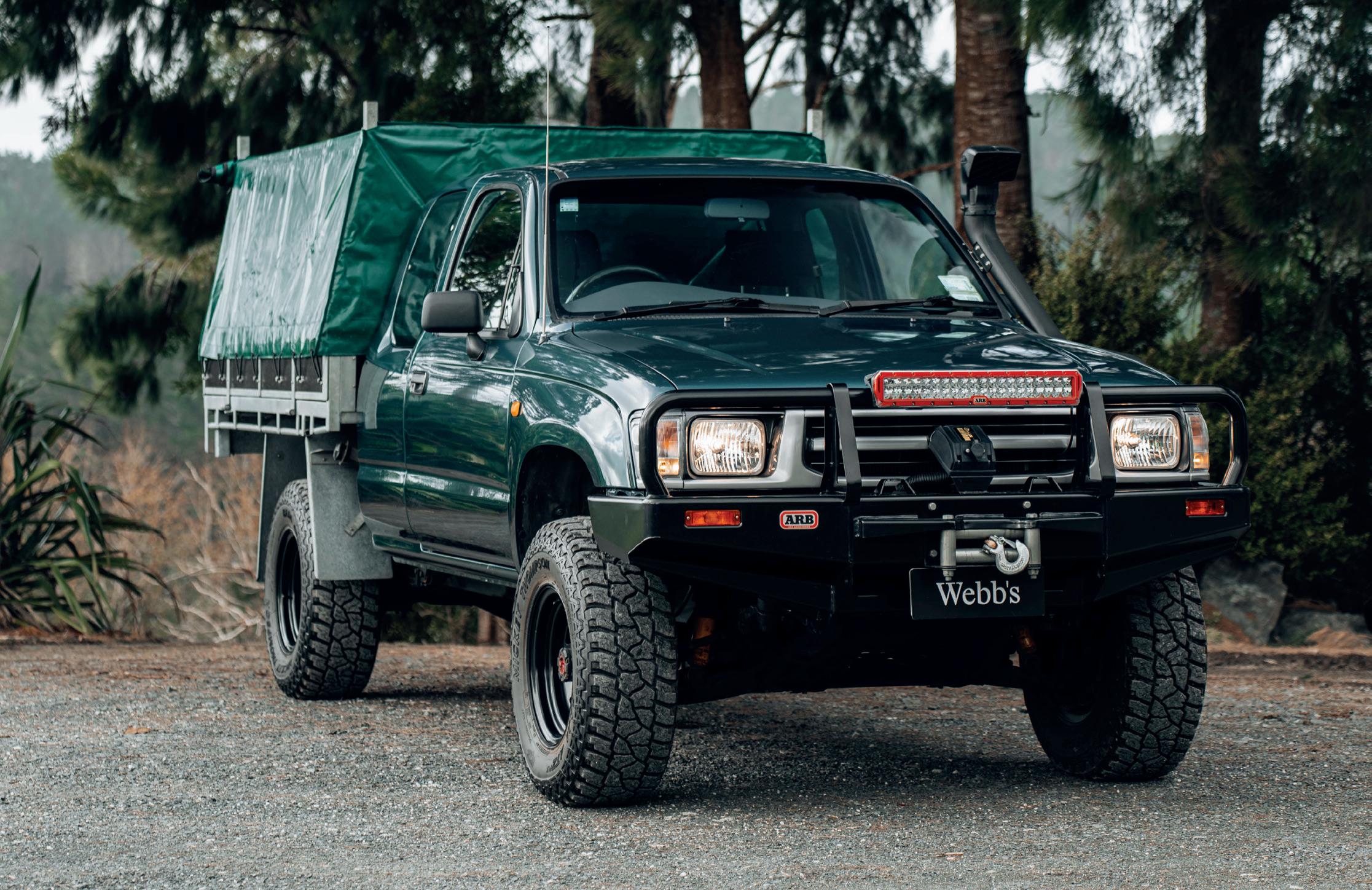

Engine: 5L-4782953
Chassis: JT732LNH200003344
est $50,000 — $60,000
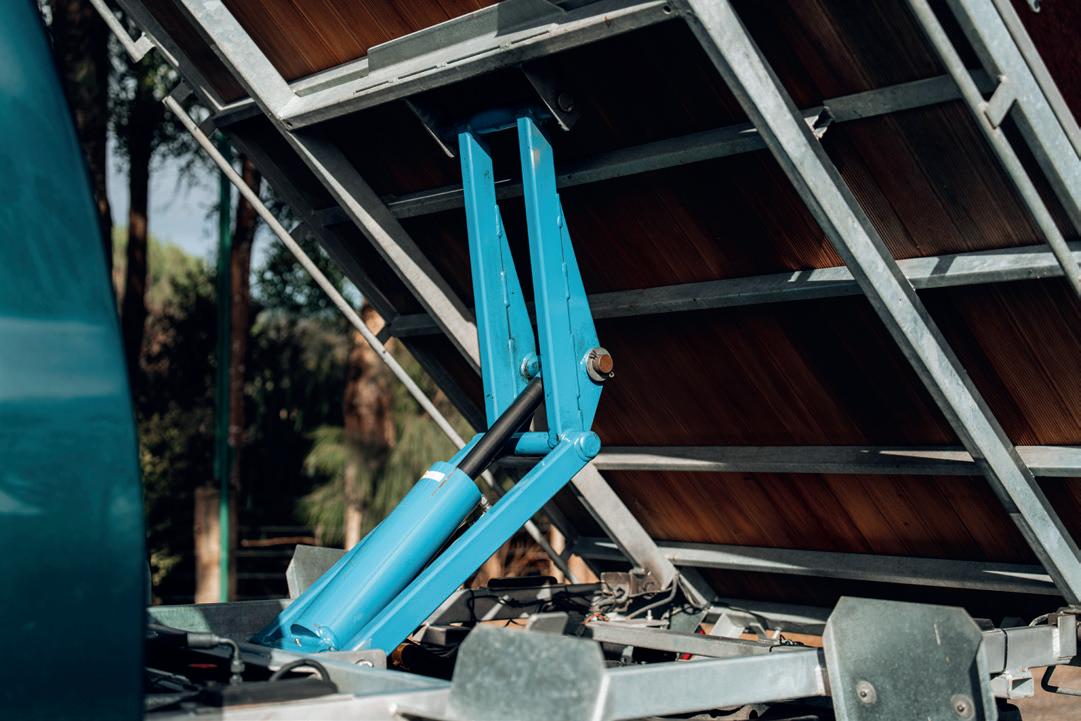
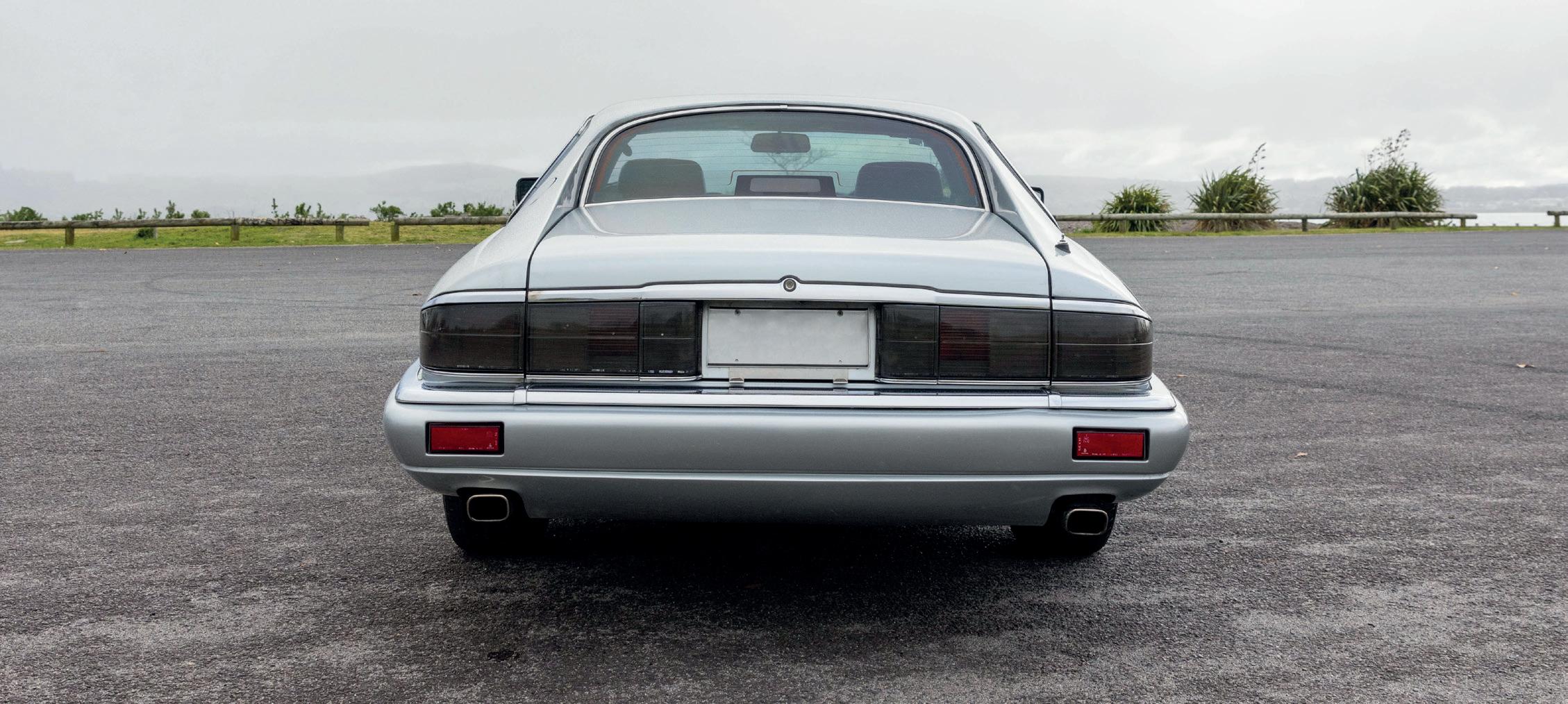

Engine: COVERED Chassis: SAJJNKES3EP189063
est $35,000 — $45,000
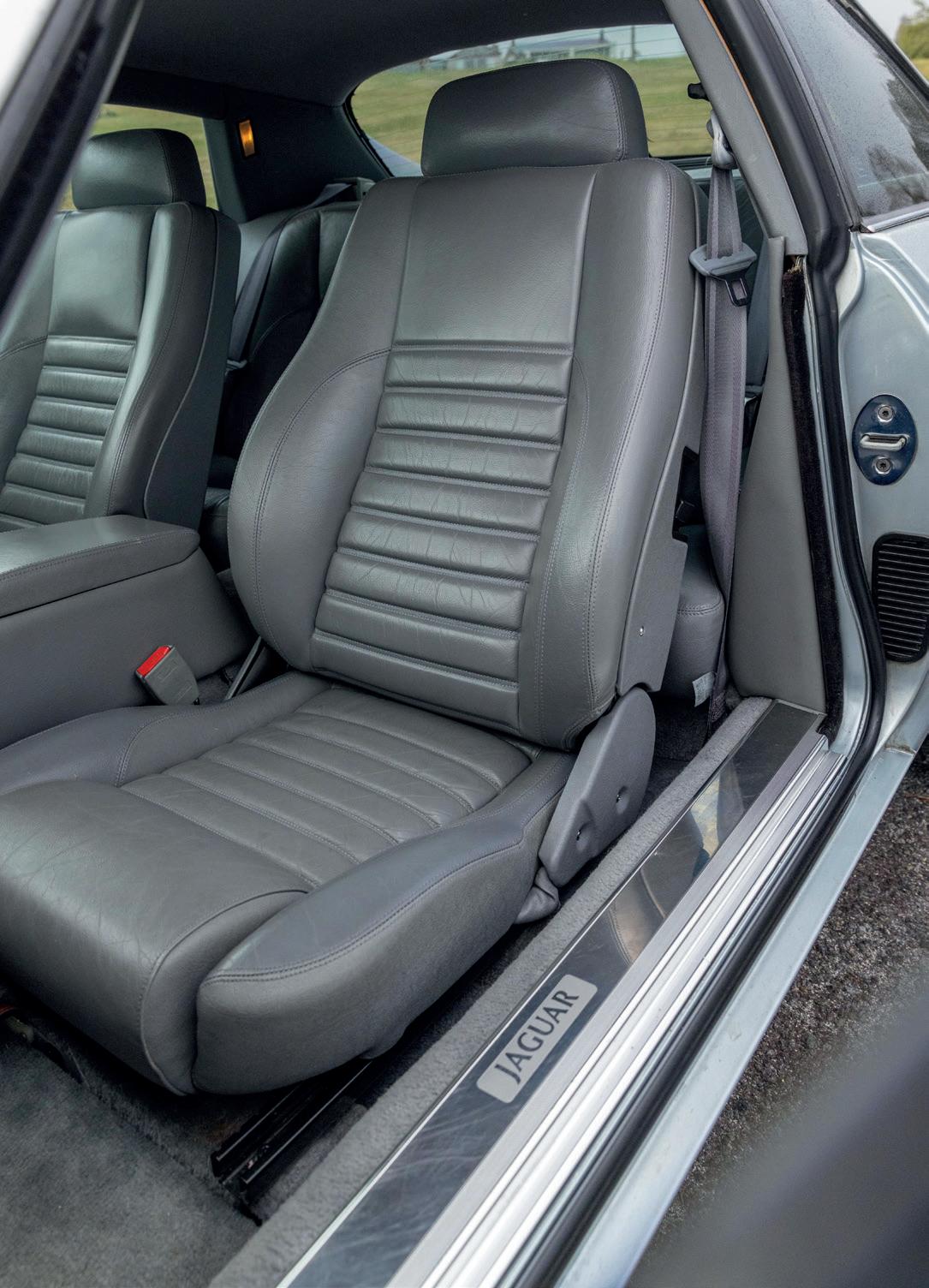
The Jaguar XJS — introduced in September 1975 as the successor to the iconic E-Type — marked a new era for Jaguar. Priced at £8,900, it was the most expensive production car the company had ever produced at the time. While intended as a prestigious Grand Touring coupé, the XJS boasted impressive sports car performance, with a top speed of nearly 240 kmph, combined with exceptional comfort and refinement.
Initially, the XJS’s unconventional styling and lack of traditional wood veneer raised some concerns. However, over time, the XJS gained a strong reputation and became one of Jaguar’s most successful sporting cars. It also achieved success in competition, with appearances in American races as part of the Group 44 team from 1976 to 1982. In 1982, the Jaguar TWR team entered XJS cars in the European Touring Car Group A championship, with Tom Walkinshaw winning the championship in 1984 and securing a victory in the Spa 24-hour race alongside Win Percy.
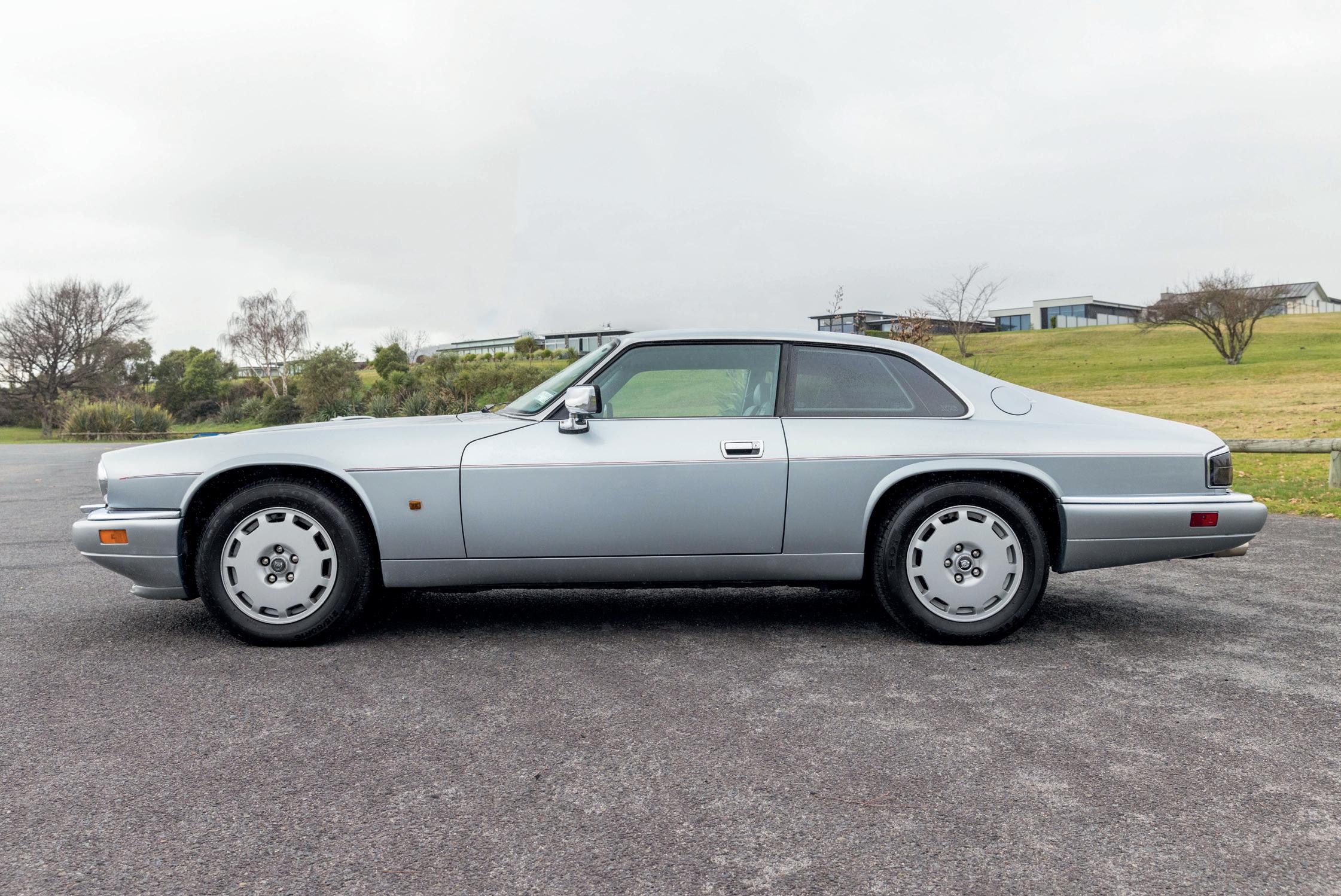
This variant of the XJS is powered by a robust and smooth 6.0-litre V12 engine, delivering impressive performance and ample power and torque for exhilarating acceleration and effortless cruising. Paired with a fourspeed automatic transmission, the XJS offers a refined and comfortable driving experience. The engine produces a maximum power of 309PS (305bhp –227 kW) at 4750rpm and a maximum torque of 476Nm at 3950rpm.
In terms of chassis details, the XJS features independent double wishbones, coil springs, and an anti-roll bar for the front suspension, while the rear suspension is equipped with coil springs and an anti-roll bar.
This particular example of the 1993 Jaguar XJS 6-litre is a Japan-new model that was first registered in New Zealand in September 2012. The vendor is the second local owner, and the car comes with an extensive local service history. It is described as “rust-free”, has been fitted with an aftermarket Bluetooth stereo, and
has accumulated approximately 90,000 km on the odometer.
The 1993 Jaguar XJS 6-litre remains a highly sought-after classic car, cherished for its combination of performance, luxury, and timeless design. It represents a significant era in Jaguar’s history and continues to captivate automotive enthusiasts and collectors alike. Whether enjoyed for weekend cruising or used for long-distance touring, the XJS 6-litre offers a refined and captivating driving experience that embodies the essence of classic British grand touring.

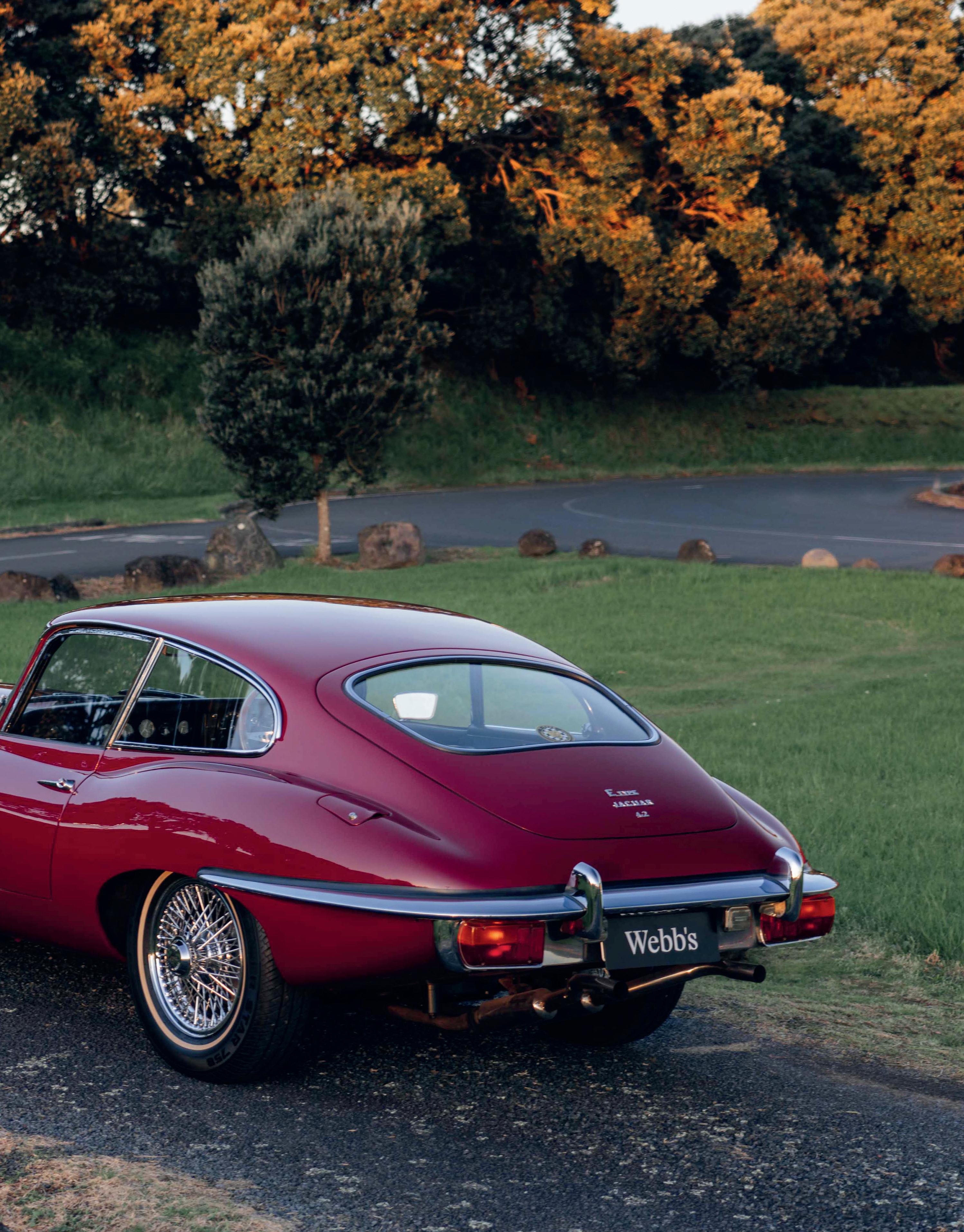

Engine: 7R 2767-8
Chassis: 1R 25720
est $175,000 — $200,000
Jaguar entered the swinging sixties with the ultimate object of automotive desire – the E-Type. Its aerodynamic shape, high performance engine, nimble handling and luxurious interior have made it a favourite among car enthusiasts and collectors for decades. It has become an icon of the era.

Development of the E-Type began in the late 1950s, when Jaguar’s chief engineer, William Heynes, tasked aerodynamicist Malcolm Sayer with designing a car that would be faster and more flow-efficient than the company’s XK sports car. Sayer used his experience designing aircraft and racing cars to create a sleek, low-slung, beautiful and highly functional body. The E-Type’s racing pedigree has been championed from conception, having been based on Jaguar’s highly successful and wildly popular D-Type racing car. Introduced to the public in 1961, it quickly became a sensation.
Over the years, the E-Type evolved to meet changing tastes and regulatory requirements. Its looks and speed astonished everyone in the ‘60s and early ‘70s, making the E-Type an instant must-have accessory for the jet set, including Princess Grace, Steve McQueen and Frank Sinatra. In 1996, the New York City Museum of Modern Art recognised the significance of the E-Type by including a blue roadster in its permanent design collection, one of only nine motor cars to receive this distinction.
As the marque progressed, 1964 saw the launch of the 4.2-litre E-Type model, offering a gearbox with synchromesh on first gear together with the bigger, torquier engine. The Series II E-Types underwent a number of design changes that were phased-in during 1967, largely


due to U.S. design legislation. From 1969, major changes were made to the bodywork with a more raked windscreen, the most distinctive feature being the absence of the aerodynamic glass headlight covers. Improved engine cooling was achieved thanks to an enlarged air-intake and twin electric fans, and the smooth polished cam covers were changed to the easily identified ribbed appearance. The engine was detuned for the US market with twin Stromberg carburettors and larger valve clearances, but in the UK and Europe, triple SUs were retained with tighter valve clearances. The Series 2 4.2 had a factory quoted top speed of 149mph and achieved 0-60 in 7.2 seconds. Accordingly, bigger brakes were fitted.
This Series II was formerly in the collection of noted collector Roy Savage, who acquired the car in 1979 following its importation in to New Zealand in 1976 by Mr. Geoffrey Easterbrook-Smith. Easterbrook-Smith was Roy’s neighbour and a member of the Diplomatic Corp in Switzerland. It is believed he purchased this car in Europe from a previous owner and brought it back to New Zealand when his commission had finished. According to the Jaguar Heritage Trust Certificate, this car was originally delivered to the Swiss distributor Emil Frey, Zurich on 13th February, 1969 as a fixed-head coupe, left-hand drive. The car retains its original livery of Regency Red with black interior. It is believed Easterbrook-Smith brought the factory components to make the conversion to right-hand drive on this car and that the work was carried out in New Zealand. Our vendor purchased the car from Webb’s sale of the Roy Savage Collection in 2016. Roy had owned the car for 37 years. It is a genuine triple SU carburettor model with the 4-speed manual gearbox and the original Smiths gauges. The paintwork has since been resprayed. The body work is straight and the glassware and chrome work is in good condition. The interior is original and its overall condition is consistent with its age and use. A desirable after-market Moto-Lita steering wheel has been fitted. General maintenance has been regularly attended to with receipts available.
This E-type is in good running order showing approx. 66,698kms on the clock. It is an interesting example of the marque and offers a very good opportunity for collectors.


Engine: MX-COVERED
Chassis: 1J4FY19S9XP481925
est $25,000 — $35,000
Since its introduction in 1986, the Jeep Wrangler has remained a beloved and iconic off-road vehicle that has captured the hearts of adventure enthusiasts for decades. Known for its rugged design and exceptional off-road capabilities, the Wrangler has become a symbol of freedom and exploration.
The second generation of Wrangler, the TJ, was introduced in 1996. It’s exterior design is distinctive and instantly recognisable. It features a boxy shape with a prominent seven-slot grille at the front, round headlights, and a removable top and doors, allowing for an open-air driving experience. The rugged body-on-frame construction and high ground clearance make it well-suited for tackling challenging terrains.
The TJ came equipped with a variety of engine options to cater to different driving preferences. The standard engine was a 2.5-litre inline-4, which provided adequate power for daily driving and light off-roading. For those seeking more power like this example, there was also a 4.0-litre inline-6 engine, mated to a five-speed manual transmission, known
for its durability and torque.
With its solid front and rear axles, robust suspension system, and available four-wheel drive, it can conquer challenging trails, crawl over rocks, and ford through water with ease. Its compact size and short wheelbase contribute to its impressive manoeuvrability in tight spaces.
This Japan-new model was first registered in New Zealand in November 2019, little is known about its Japanese history, although it comes complete with a Japanese manual. The ‘Firecracker red’ paintwork is in good order, as is the nearly new canvas cover. Our vendor is the third New Zealand owner, and the odometer reads approximately 50,000 kms. It comes complete with a spare tyre, two spare side doors and a car cover.
Whether cruising on city streets or conquering challenging trails, the Jeep Wrangler embodies the spirit of exploration and continues to be a favourite choice among those seeking an authentic off-road experience. It is begging for a summer roadie.


DeSoto, a brand of the Chrysler Corporation, was launched in 1928 following Chrysler’s acquisition of Dodge Bros. The brand was named after Hernando DeSoto, a 16th-century Spanish explorer known for leading Europe’s first expedition into the American hinterland. The car’s crest featured the phrase “Multum pro Parvo,” meaning “much for little,” highlighting its affordability and value, similar to the concept of “bang for your buck” today.
The 1928 Model K DeSoto was introduced alongside the Chrysler Plymouth, sharing the same chassis. However, the DeSoto was equipped with a six-cylinder engine instead of the four-cylinder engine found in the Plymouth. The DeSoto was targeted at customers seeking a mid-priced car and was priced between $845 and $885, positioning it above the Plymouth ($685-$735). The higher-end Chrysler 65 was also available, priced at $1,040-$1,145. By offering cars at different price points, Chrysler appealed to a wide range of customers, contributing to its status as one of America’s ‘Big Three’ automakers alongside Ford and General Motors.
The DeSoto enjoyed great success, with 80,000 units produced in its first year, a record only surpassed by the popular Ford Falcon in 1960. Over time, the brand underwent several rejuvenations until production ceased in 1960, with over two million vehicles manufactured since 1928.
This particular DeSoto has a documented provenance in New Zealand and is likely one of the first models of the marque sold in Auckland. It was previously owned by Mr. George Nilsson, whose daughter, Mrs. M.B. Keenan, donated it to MOTAT (Museum of Transport and Technology) around 1972.

Engine: K103125
Chassis: TBC
est $10,000 — $15,000
The museum subsequently restored the vehicle in the style of a Checker taxi cab, paying homage to the local company founded in 1925. Originally registered as 349.168, it was later assigned the number plate AS6394 by MOTAT. Although there is no documentation specifying the exact date of the restoration, it is believed to have taken place in the late-1970s or early ‘80s. It should be noted that there is no evidence of this particular vehicle being used as a taxi, so its current livery should not be considered authentic. According to Webb’s research, it is one of the 807 DeSotos sold new in New Zealand in the late-1920s.
The DeSoto is in good condition considering its age, with some minor crazing in the paint. The interior is in very good condition, as are the artillery-style wheels fitted with what appear to be relatively new tires. Compression is present, but the starter motor requires attention according to Webb’s information. The bodywork appears untouched, with door shut lines consistent with factory specifications. A blue towing light at the front is a characteristic feature of the era. The brakes are hydraulic. A list of recent service work carried out by MOTAT is available upon request.
 Sold unregistered and unwarranted. This vehicle is offered without reserve.
Sold unregistered and unwarranted. This vehicle is offered without reserve.

Engine: 10499222076682
Chassis: WDB1240522C201302
est $20,000 — $25,000
Regarded by marque lovers as the “last of the old guard”, the Mercedes-Benz 124 chassis was the company’s midsize offering from the early ‘80s through to 1995. The ultimate expressions of this chassis were their coupes and convertibles, both series’ graced by the E320 for but two years in 1994 and 1995. This particular coupe, a C 124, is an excellent example of the revered line.
When first released the E320 was a particularly expensive model, even for Daimler-Benz standards, priced initially higher than an equivalent SL model. This was for good reason, however, as W124’s, and in particular E320’s, are known for their buildquality and have gained a good reputation for reliability.

This example is equipped with a 5-speed automatic
transmission and 3.2-litre M104 engine. Featuring a DOHC design with four valves per cylinder the M104 produces 220hp at 5500rpm.
The coupe that Webb’s presents today would itself bring that same efficient engineering to the table 20 years later. Having been regularly maintained by Mercedes-Benz Wellington after having come into its second owners possession, and bought new that same year in 1994 by its first, this E320 presents in excellent condition. Through close to two decades of usage it bears only minor cosmetic blemishes apparent on the original paint, completed repairs to the seatbelt extender arm and 111,967 kms on the dash as marks of its service. This E320 then, is a true example of the timelessness that the marque is known for.





Introduced at the 1970 Geneva Motor Show, the Citroën SM stands as a unique and distinctive luxury GT car resulting from a collaboration between Citroën and Maserati. This collaboration blended French innovation with Italian performance, resulting in a vehicle that was truly ahead of its time. Designed by Robert Opron, the SM boasted innovative styling, including a sleek and aerodynamic shape characterised by a long hood, a sloping roofline, and a distinctive semi-fastback rear end. Its smooth lines and iconic hydropneumatic suspension system gave it a futuristic appearance that still captivates today.

Citroën’s acquisition of Maserati in 1968 proved fortuitous as it allowed the incorporation of a brand-new twin-cam V6 engine with a 2670cc capacity, producing 170 bhp. The power from this engine was channelled to the front wheels through either a five-speed manual or a three-speed automatic transmission, with this particular example featuring the former. Retaining the hydropneumatic suspension system from the DS, the SM delivered a smooth and comfortable ride. The suspension automatically adjusted the car’s height based on road conditions, while allowing the driver to manually customise the ride height. Combined with self-levelling suspension and power-assisted Divari steering, the SM exhibited exceptional driving dynamics.
Inside, the SM offered both luxury and innovation. The adjustable front seats allowed for a personalised seating position, while the dashboard featured a unique arrangement of gauges and controls, including a speed-sensitive power steering system and an unconventional single-spoke steering wheel.
With only 12,920 units produced during its five-year lifespan, the SM remains a highly sought-after car today, blending modernity, comfort, and performance to create a true grand tourer that is distinctively prestigious and stylish.
The current vendor acquired the vehicle in 1995. It had been imported from New Caledonia where it was originally purchased by an executive of a French mining company. Throughout its existence, the car has had a total of only four owners. Recently, it has undergone a restoration process, receiving a new hood lining, refurbished leather, and new carpets. The paintwork alone entailed a $30,000 investment, resulting in a finish that matches the original Feuille Dorée (Golden Leaf) colour. The car also includes a Continental Edison radio and an authentic model handbook. Furthermore, the current owner intends to provide the purchaser with a book documenting the restoration process and accompanying receipts. The vehicle has accumulated a low mileage of 105,561 kms on the Jaegar dial. Rarely seen and rarely offered for sale, the SM is widely regarded as the ultimate embodiment of French automotive “Haute Couture,” infused with an abundance of “Toute Vitesse” (full speed). It remains a remarkable GT car that showcases the ingenuity and creativity of Citroën alongside the performance heritage of Maserati. With its sleek design, distinctive suspension, and luxurious interior, the SM stands as an icon of automotive engineering, representing an enduring symbol of automotive innovation.


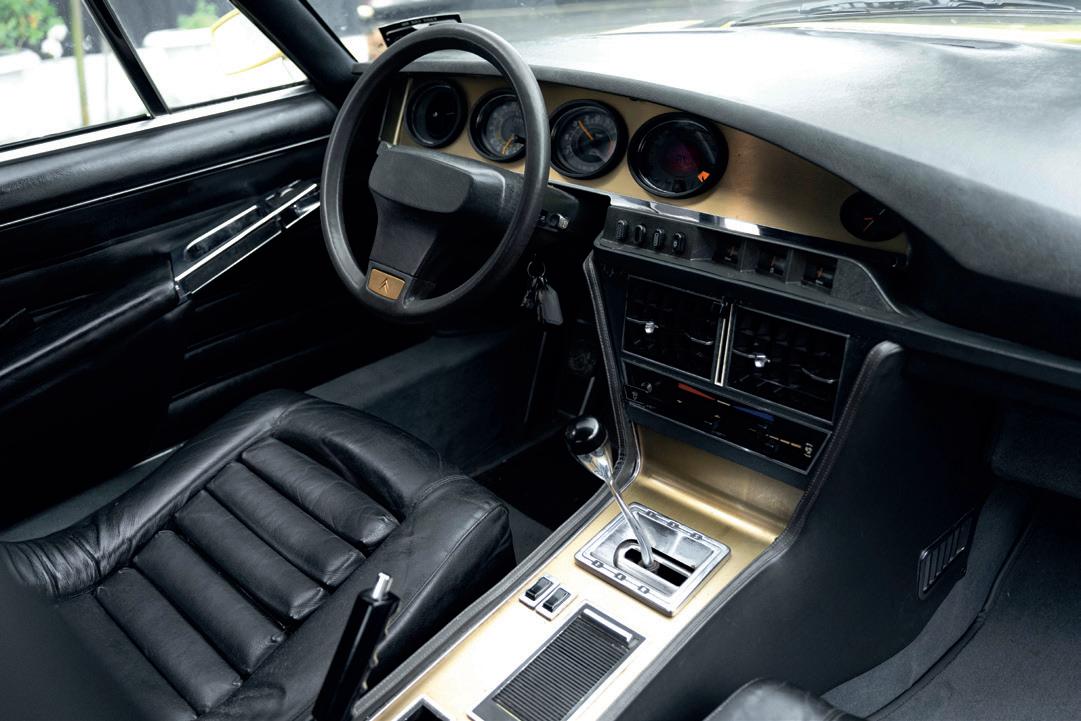

Engine: OSB 2422
Chassis: SB 2422
est $120,000 — $140,000
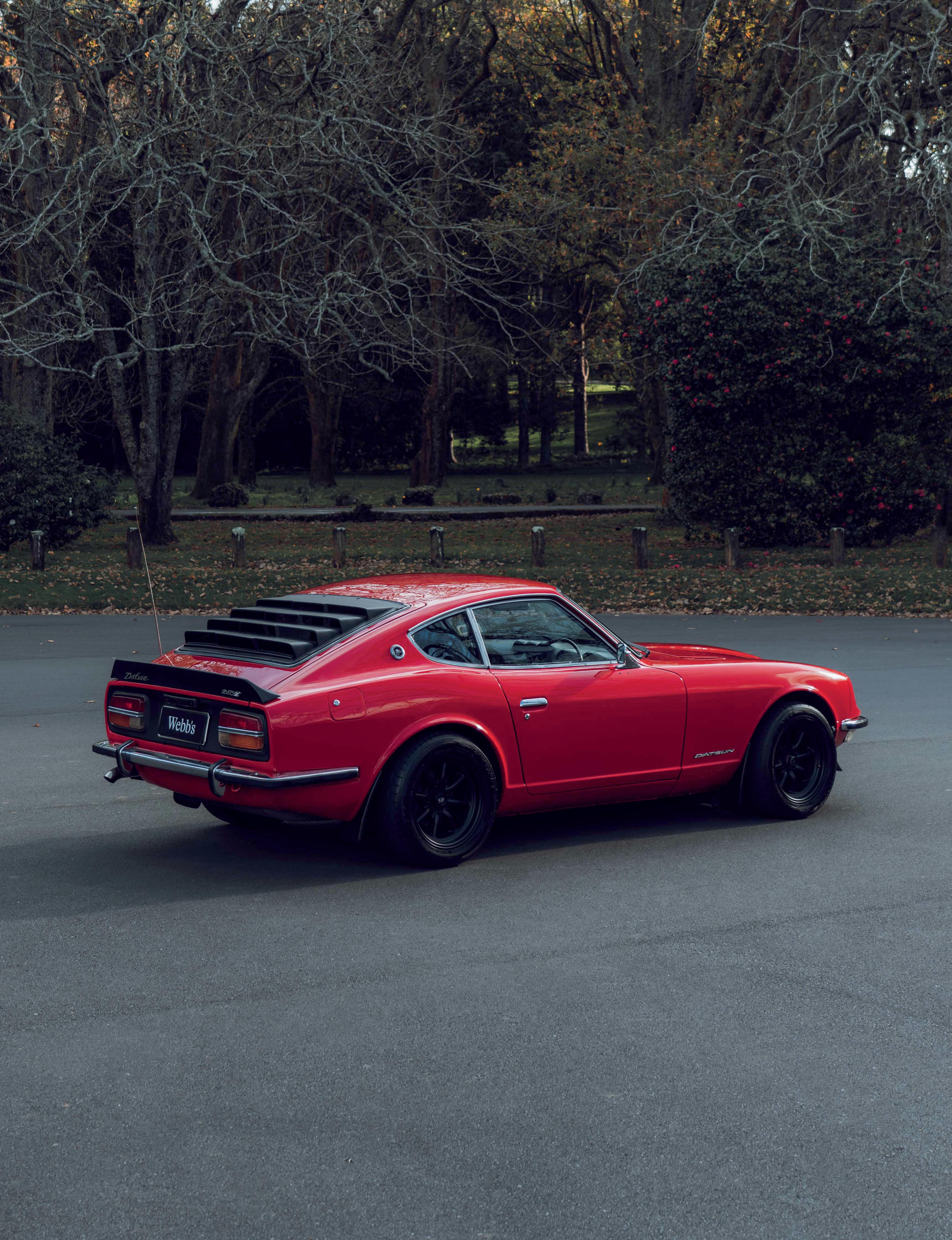

Engine: 24189578
Chassis: HS30103464
est $75,000 — $90,000
Established in 1933, the Nissan Motor Company initially marketed its export cars under the name Datsun until 1983 when the brand was discontinued. Prior to the iconic 240Z, the company had produced Datsun sports cars, notably the Fairlady series in the 1960s. However, with the introduction of the 240Z in 1969, Nissan solidified its position as a formidable player in the sports/GT market. Remarkably, the Datsun 240Z became the first Japanese-made sports car to gain global acclaim. Despite being designed by a team led by Yoshiko Matsuo at Nissan, with contributions from consultant Count Albrecht Goertz, known for styling the BMW 503 and 507, the 240Z exuded a distinctly European appearance.
Featuring a powerful 2.4-litre overhead-camshaft sixcylinder engine, a five-speed manual (or three-speed automatic) transmission, all-round independent suspension, and a generous standard equipment level, the competitively priced 240Z achieved immense success in multiple markets, posing a significant challenge to competitors like MG, Triumph, and Jaguar. In his book A-Z of Sports Cars, Mike Lawrence remarked: “With a top speed of 125mph (0-60mph in eight seconds), a high level of standard trim (with optional air conditioning), a reasonable price, and unmatched reliability, the 240Z not only replaced the Austin-Healey 3000 but also surpassed the sales of both the MGB and Jaguar E-Type.”


In addition to its commercial triumphs, the 240Z also proved to be highly successful in motorsport, particularly in club racing and international rally events. Factory-prepared and well-driven rally cars earned a reputation for their durability in long-distance events, notably securing outright victories in the Safari Rally of 1971, ‘72, and ‘73, with drivers such as Edgar Hermann, Rauno Aaltonen, Harry Kallstrom, Shekhar Mehta, and Tony Fall at the helm.
The particular example offered by Webb’s entered the local registration system on January 8, 1981. While the vehicle’s history in New Zealand is not fully known, the vendor acquired it in Queenstown. It currently sports non-stock wheels, but the original ones are available and will be included with the purchase. The red paint, while likely not the factory colour, has adorned the car since its arrival in New Zealand.
Mileage sits at approximately 85,000 miles, a list of the work completed by the vendor is available on request. Presented by Webb’s, this 240Z stands as a remarkable survivor of the first generation of Z-Cars, with considerable investment potential. Finding one in such exceptional condition is rare and presents a unique opportunity for interested collectors or enthusiasts.
The vehicle will be sold registered and with a current WOF.


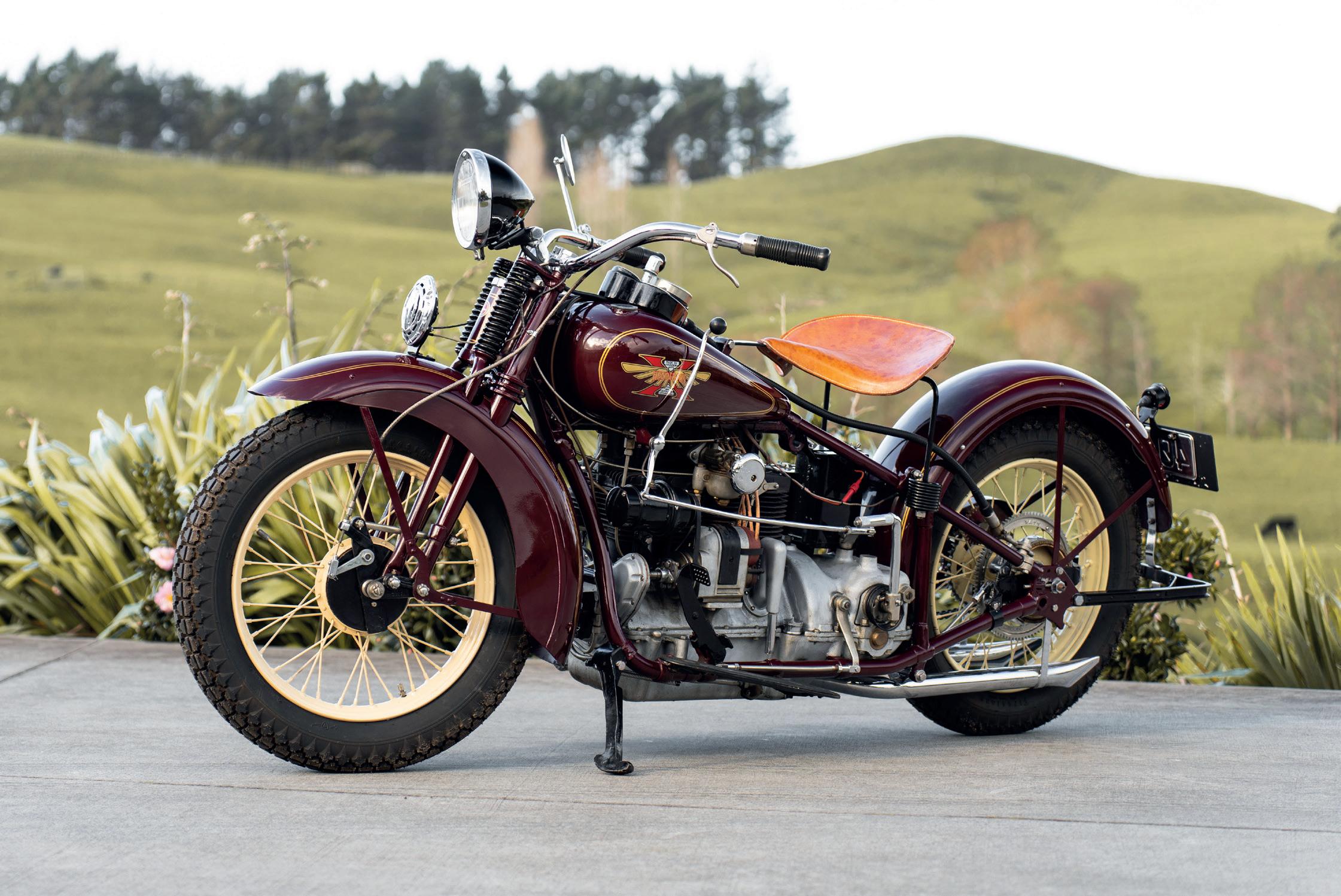
Engine: KL36001
Chassis: KL36001
est $200,000 — $225,000
This example of motorcycling performance history was born out of the marriage of three great early manufacturers of transport equipment. In 1911 Ignaz Schwinn — the founder of Schwinn Bicycle Company purchased Excelsior motor and Manufacturing Company and subsequently purchased Henderson in 1917, when the latter fell into financial difficulty. What would eventually be produced by this partnership, some fourteen years later, was this model — one of the last of its kind. Excelsior-Henderson, known for manufacturing high-quality motorcycles throughout the early 20th century, had itself fallen into to financial difficulty, and
was not to produce another motorcycle for decades.
The Henderson Four/KL was introduced in 1929 as an updated version of the popular KJ model.
It features a 1,301cc inlinefour engine with a side-valve design. Producing around 40 horsepower, the KL had several improvements over its predecessor, including a stronger frame, improved brakes, and a redesigned suspension system.
This example has been restored faithfully to its historical condition in appearance, fit-out and performance, and has been upgraded with a Kevlar clutch. It was recently registered in New Zealand with an NZ VIN, and was previously owned and restored by Richard Schultz of Iowa in the United States. Schultz is a renowned authority on Henderson motorcycles and is also known for writing the book Henderson – Those Elegant Machines. Naturally then, included with this lot are various documents establishing its pedigree and providence in rich detail — a cache of history including notes and letters from Schultz to the previous owner. These documents clarify works done and specifications including engine work done by Carl Vandre, also known as “Mr Henderson” — a renowned and highly regarded engine builder and lover of Henderson’s.
Favoured by early 20th-century American highway patrolmen for their excellent and unyielding performance, and loved by the most perfectionist of enthusiasts, these motorcycles, and in particular this example, were and still are built to be ridden. Current mileage is 32,479km; a speedometer was optional in 1931.
While there are few extant Henderson’s remaining, Webb’s understands that this one-of-one bike in New Zealand is the sibling of an award-winning KL — of which there have been many. Such examples, alongside this one, undoubtedly contributed to the fine reputation of such a rare marque and model. These motorcycles exemplify quality over quantity and have often been called the RollsRoyce of the category.
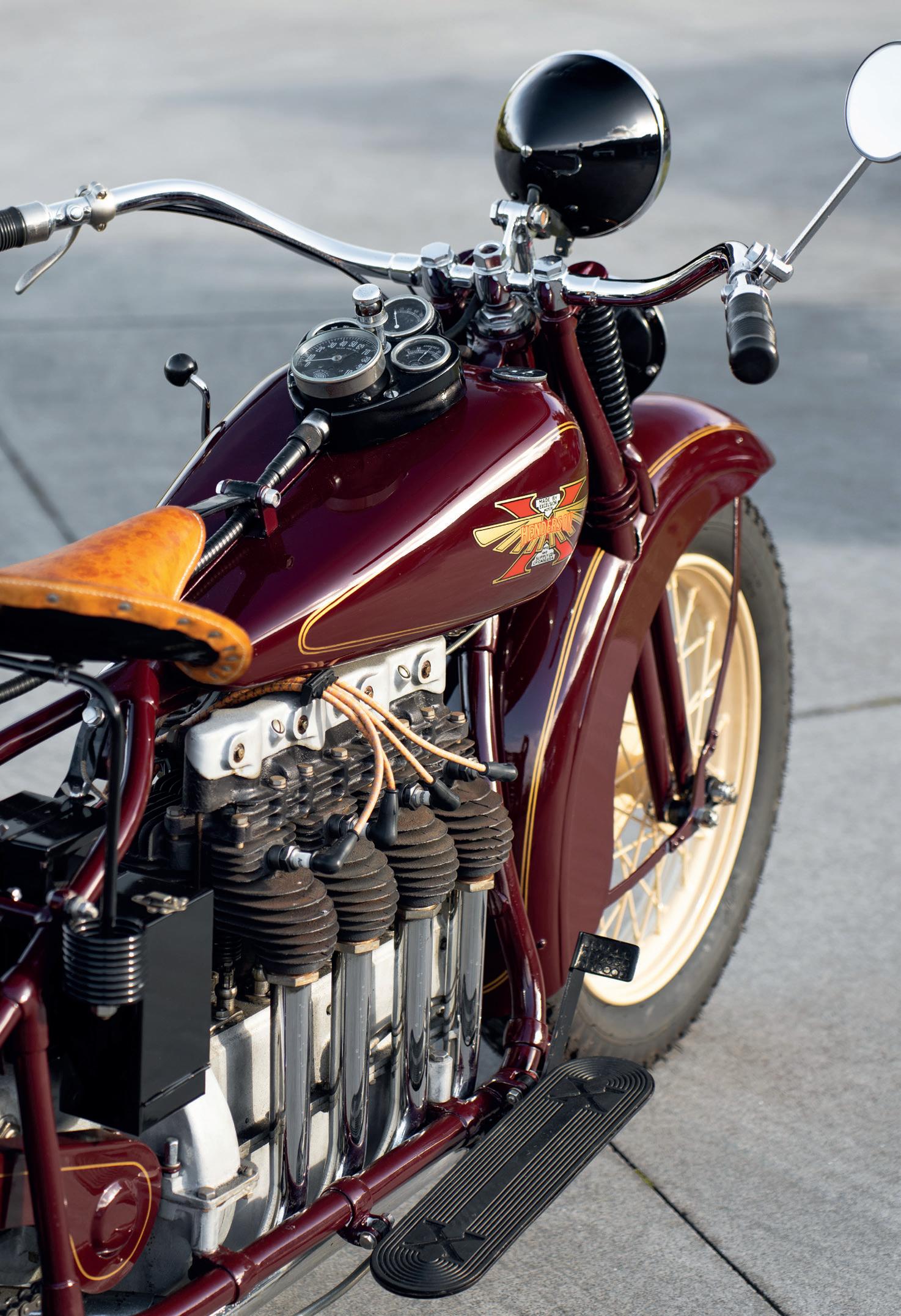

Engine: 1366
Chassis: GHN331406
est $25,000 — $30,000
Introduced in 1962 and remarkably still in production nearly two decades later, the MGB unquestionably stands as the definitive and classic sports car, inheriting the legacy of its highly successful predecessor, the MGA. Throughout its journey, it did gain some weight due to American safety influences, but this particular example retains the purity of the original chrome design, resulting in a car that stays true to the essence of the marque by providing maximum fun at a minimum investment!
This particular MGB is believed to have been originally destined for the UK market, although its precise origin remains unverified. Nonetheless, it was subsequently registered in New Zealand in October 1969, bearing the number plate DR9697. Adorned with stylish wire wheels, this car has been lovingly cared for by its current owner, who has dedicated seven years of meticulous attention to its maintenance. The list of improvements is extensive, including a new hood, carpet, steering wheel, horn, and windscreen. Furthermore, the bonnet
has been freshly repainted, and a luggage rack adds a touch of practicality and charm. All of these refurbishments have been skilfully carried out by an independent garage, which is entrusted with the vendor’s notable classic car collection.

As with any classic car, there are some minor imperfections to be noted. There is slight distressing in the paintwork at the rear, and the synchromesh on second gear shows signs of wear, requiring a measured approach when changing gears.


In conclusion, the timeless MGB undeniably holds the title of the most beloved sports car ever manufactured in Britain. Even to this day, its appeal remains unmatched as an affordable, practical, and exhilarating two-seater, especially when presented in its early and unadulterated form.
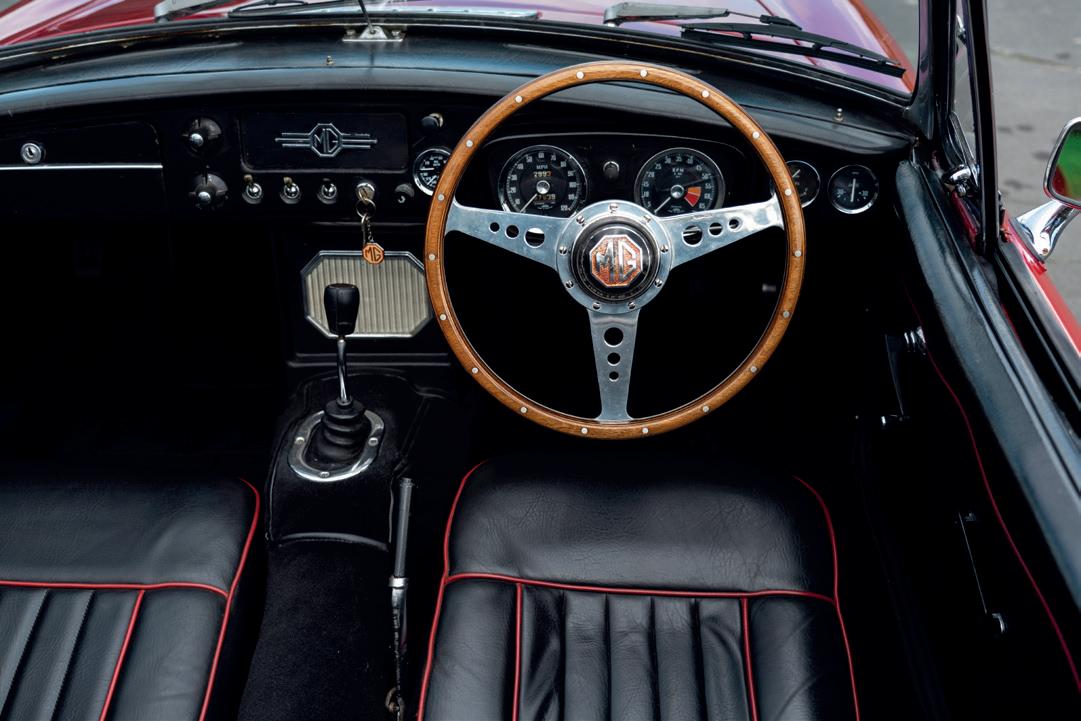

The terms and conditions of sale listed here contain the policies of Webb’s (Webb Fine Art). They are the terms on which Webb’s (Webb Fine Art) and the Seller contract with the Buyer. They may be amended by printed Saleroom Notices or oral announcements made before and during the sale. By bidding at auction you agree to be bound by these terms.
The conditions that are listed below contain terms that are used regularly and may need explanation. They are as follows:
“the Buyer” means the person with the highest bid accepted by the Auctioneer.
“the Lot” means any item depicted within the sale for auction and in particular the item or items described against any lot number in the catalogue.
“the Hammer price” means the amount of the highest bid accepted by the auctioneer in relation to a lot.
“the Buyer’s Premium” means the charge payable by the Buyer to the auction house as a percentage of the hammer price.
“the Reserve” means the lowest amount at which Webb’s has agreed with the Seller that the lot can be sold.
“Forgery” means an item constituting an imitation originally conceived and executed as a whole, with a fraudulent intention to deceive as to authorship, origin, age, period, culture or source, where the correct description as to such matters is not reflected by the description in the catalogue. Accordingly, no lot shall be capable of being a forgery by reason of any damage or restoration work of any kind (Including re-painting).
“the insured value” means the amount that Webb’s in its absolute discretion from time to time shall consider the value for which a lot should be covered for insurance (whether or not insurance is arranged by Webb’s).
All values expressed in Webb’s catalogues (in any format) are in New Zealand Dollars (NZD$). All bids, “hammer price”, “reserves”, “Buyers Premium” and other expressions of value are understood by all parties to be in New Zealand Dollars (NZD$) unless otherwise specified.
2.
Except as otherwise stated, Webb’s acts as agent for the Seller.
The contract for the sale of the property is therefore made between the Seller and the Buyer.
3.
3.1. Examination of Property
Prospective Buyers are strongly advised to examine in person any property in which they are interested before the Auction takes place. Neither Webb’s nor the Seller provides any guarantee in relation to the nature of the property apart from the Limited warranty in the paragraph below.
The property is otherwise sold “AS IS”
2. Catalogue and Other Descriptions
All statements by Webb’s in the
catalogue entry for the property or in the condition report, or made orally or in writing elsewhere, are statements of opinion and are not to be relied upon as statements of fact. Such statements do not constitute a representation, warranty or assumption of liability by Webb’s of any kind. References in the catalogue entry to the condition report to damage or restoration are for guidance only and should be evaluated by personal inspection by the bidder or a knowledgeable representative. The absence of such a reference does not imply that an item is free from defects or restoration, nor does a reference to particular defects imply the absence of any others. Estimates of the selling price should not be relied on as a statement that this is the price at which the item will sell or its value for any other purpose. Neither Webb’s nor The Seller is responsible for any errors or omissions in the catalogue or any supplemental material.
Images are measured height by width (sight size). Illustrations are provided only as a guide and should not be relied upon as a true representation of colour or condition. Images are not shown at a standard scale. Mention is rarely made of frames (which may be provided as supplementary images on the website) which do not form part of the lot as described in the printed catalogue. An item bought “on Extension” must be paid for in full before it will be released to the purchaser or his/her agreed expertising committee or specialist. Payments received for such items will be held “in trust” for up to 90 days or earlier, if the issue of authenticity has been resolved more quickly. Extensions must be requested before the auction. Foreign buyers should note that all transactions are in New Zealand Dollars so there may be a small exchange rate risk. The costs associated with acquiring a good opinion or certificate will be carried by the purchaser. If the item turns out to be forged or otherwise incorrectly described, all reasonable costs will be borne by the vendor.
3. Buyers Responsibility
All property is sold “as is” without representation or warranty of any kind by Webb’s or the Seller. Buyers are responsible for satisfying themselves concerning the condition of the property and the matters referred to in the catalogue by requesting a condition report.
No lot to be rejected if, subsequent to the sale, it has been immersed in liquid or treated by any other process unless the Auctioneer’s permission to subject the lot to such immersion or treatment has first been obtained in writing.
4.1. Refusal of Admission
Webb’s reserves the right at our complete discretion to refuse admission to the auction premises or participation in any auction and to reject any bid.
4.2. Registration Before Bidding
Any prospective new buyer must complete and sign a registration form and provide photo identification before bidding. Webb’s may request bank, trade or other financial references to substantiate this registration.
4.3. Bidding as a Principal
When making a bid, a bidder is accepting personal liability to pay the purchase price including the buyer’s premium and all applicable taxes, plus all other applicable charges, unless it has been explicitly agreed in writing with Webb’s before the commencement of the sale that the bidder is acting as agent on behalf of an identified third party acceptable to Webb’s and that Webb’s will only look to the principal for payment.
4.4. International Registrations
All International clients not known to Webb’s will be required to scan or fax through an accredited form of photo identification and pay a deposit at our discretion in cleared funds into Webb’s account at least 24 hours before the commencement of the auction. Bids will not be accepted without this deposit. Webb’s also reserves the right to request any additional forms of identification prior to registering an overseas bid. This deposit can be made using a credit card, however the balance of any purchase price in excess of $5,000 cannot be charged to this card without prior arrangement. This deposit is redeemable against any auction purchase and will be refunded in full if no purchases are made.
4.5. Absentee Bids
Webb’s will use reasonable efforts to execute written bids delivered to us AT LEAST 24 Hours before the sale for the convenience of those clients who are unable to attend the auction in person. If we receive identical written bids on a particular lot, and at the auction these are the highest bids on that lot, then the lot will be sold to the person whose written bid was received and accepted first. Execution of written bids is a free service undertaken subject to other commitments at the time of the sale and we do not accept liability for failing to execute a written bid or for errors or omissions which may arise. It is the bidder’s responsibility to check with Webb’s after the auction if they were successful. Unlimited or “Buy” bids will not be accepted.
4.6. Telephone Bids
Priority will be given to overseas and bidders from other regions. Please refer to the catalogue for the Telephone Bids form. Arrangements for this service must be confirmed AT LEAST 24 HOURS PRIOR to the auction commencing. Webb’s accepts no responsibility whatsoever for any errors or failure to execute bids. In telephone bidding the buyer agrees to be bound by all terms and conditions listed here and accepts that Webb’s cannot be held responsible for any miscommunications in the process. The success of telephone bidding cannot be guaranteed due to
circumstances that are unforeseen. Buyers should be aware of the risk and accept the consequences should contact be unsuccessful at the time of Auction. You must advise Webb’s of the lots in question, and you will be assumed to be a buyer at the minimum price of 75% of estimate (i.e. reserve) for all such lots. Webb’s will advise Telephone Bidders who have registered at least 24 hours before the auction of any relevant changes to descriptions, withdrawals, or any other sale room notices.
4.7. Online Bidding
Webb’s offers an online bidding service. When bidding online the buyer agrees to be bound by all terms and conditions listed here by Webb’s.
Webb’s accepts no responsibility for any errors, failure to execute bids or any other miscommunications regarding this process. It is the online bidder’s responsibility to ensure the accuracy of the relevant information regarding bids, lot numbers and contact details. Webb’s does not charge for this service.
4.8. Reserves
Unless otherwise indicated, all lots are offered subject to a reserve, which is the confidential minimum price below which the Lot will not be sold. The reserve will not exceed the low estimate printed in the catalogue. The auctioneer may open the bidding on any Lot below the reserve by placing a bid on behalf of the Seller. The auctioneer may continue to bid on behalf of seller up to the amount of the reserve, either by placing consecutive bids or by placing bids in response to other bidders.
4.9. Auctioneers Discretion
The Auctioneer has the right at his/her absolute and sole discretion to refuse any bid, to advance the bidding in such a manner as he/she may decide, to withdraw or divide any lot, to combine any two or more lots and, in the case or error or dispute and whether during or after the sale, to determine the successful bidder, to continue the bidding, to cancel the sale or to reoffer and resell the item in dispute. If any dispute arises after the sale, then Webb’s sale record is conclusive.
4.10. Successful Bid and Passing of Risk
Subject to the auctioneer’s discretion, the highest bidder accepted by the auctioneer will be the buyer and the striking of his hammer marks the acceptance of the highest bid and the conclusion of a contract for sale between the Seller and the Buyer. Risk and responsibility for the lot (including frames or glass where relevant) passes immediately to the Buyer.
4.11. Indicative Bidding Steps, etc.
Webb’s reserves the right to refuse any bid, withdraw any lot from sale, to place a reserve on any lot and to advance the bidding according to the following indicative steps:
$50,000 $500,000–$1,000,000
Absentee bids must follow these increments and any bids that don’t follow the steps will be rounded up to the nearest acceptable bid.
5. After the Sale
5.1. Buyers Premium
In addition to the hammer price, the buyer agrees to pay to Webb’s the buyer’s premium. The premium varies dependant on the hammer price of the lot;
$0 - $199,999: 15%+GST
$200,000 - $399,999: 10%+GST
$400,000 and above: 5%+GST
Note - GST is applicable to the buyer’s premium only and not the hammer price. E.g. if the hammer falls at $10,000, you will receive an invoice for $11,725. If the hammer falls at $200,000, you will receive an invoice for $223,000.
5.2. Payment and Passing of Title
The buyer must pay the full amount due (comprising the hammer price, buyer’s premium and any applicable taxes and GST) not later than 2 days after the auction date.
The buyer will not acquire title to the lot until Webb’s receives full payment in cleared funds, and no goods under any circumstances will be released without confirmation of cleared funds received. This applies even if the buyer wishes to send items overseas.
Payment can be made by direct transfer, cash (not exceeding NZD$5,000, if wishing to pay more than NZD$5,000 then this must be deposited directly into a Bank of New Zealand branch and bank receipt supplied) and EFTPOS (please check the daily limit). Payments can also be made by credit card in person with a 2.2% merchant fee for Visa and Mastercard and 3.3% for American Express. Invoices that are in excess of $5,000 and where the card holder is not present, cannot be charged to a credit card without prior arrangement. Bank cheques are subject to five days clearance.
The buyer is responsible for any bank fees and charges applicable for the transfer of funds into Webb’s account.
5.3. Collection of Purchases & Insurance
Webb’s is entitled to retain items sold until all amounts due to us have been received in full in cleared funds. Subject to this, the Buyer shall collect purchased lots within 2 days from the date of the sale unless otherwise agreed in writing between Webb’s and the Buyer.
At the fall of the hammer, insurance is the responsibility of the purchaser.
5.4. Packing, Handling and Shipping
Webb’s will be able to suggest removals companies that the buyer can use but takes no responsibility whatsoever for the actions of any recommended third party. Webb’s can pack and handle goods purchased at the auction by agreement and a charge will be made for this service. All packing, shipping, insurance, postage & associated charges will be borne by the purchaser.
5.5. Permits, Licences and Certificates
Under The Protected Objects Act 1975, buyers may be required to obtain a licence for certain categories of items in a sale from the Ministry of Culture & Heritage, PO Box 5364, Wellington.
If the Buyer fails to make full payment immediately, Webb’s is entitled to exercise one or more of the following rights or remedies (in addition to asserting any other rights or remedies available under the law)
5.6.1. to charge interest at such a rate as we shall reasonably decide.
5.6.2. to hold the defaulting Buyer liable for the total amount due and to commence legal proceedings for its recovery along with interest, legal fees and costs to the fullest extent permitted under applicable law.
5.6.3. to cancel the sale.
5.6.4. to resell the property publicly or privately on such terms as we see fit.
5.6.5. to pay the Seller an amount up to the net proceeds payable in respect of the amount bid by the defaulting Buyer. In these circumstances the defaulting Buyer can have no claim upon Webb’s in the event that the item(s) are sold for an amount greater than the original invoiced amount.
5.6.6. to set off against any amounts which Webb’s may owe the Buyer in any other transactions, the outstanding amount remaining unpaid by the Buyer.
5.6.7. where several amounts are owed by the Buyer to us, in respect of different transactions, to apply any amount paid to discharge any amount owed in respect of any particular transaction, whether or not the Buyer so directs.
5.6.8. to reject at any future auction any bids made by or on behalf of the Buyer or to obtain a deposit from the Buyer prior to accepting any bids.
5.6.9. to exercise all the rights and remedies of a person holding security over any property in our possession owned by the Buyer whether by way of pledge, security interest or in any other way, to the fullest extent permitted by the law of the place where such property is located. The Buyer will be deemed to have been granted such security to us and we may retain such property as collateral security for said Buyer’s obligations to us.
5.6.10. to take such other action as Webb’s deem necessary or appropriate.
If we do sell the property under paragraph (4), then the defaulting Buyer shall be liable for payment of any deficiency between the total amount originally due to us and the price obtained upon reselling as well as for all costs, expenses, damages, legal fees and commissions and premiums of whatever kinds associated with both sales or otherwise arising from the default.
If we pay any amount to the Seller under paragraph (5) the Buyer acknowledges that
Webb’s shall have all of the rights of the Seller, however arising, to pursue the Buyer for such amount.
Where purchases are not collected within 2 days from the sale date, whether or not payment has been made, we shall be permitted to remove the property to a warehouse at the buyer’s expense, and only release the items after payment in full has been made of removal, storage handling, insurance and any other costs incurred, together with payment of all other amounts due to us.
Webb’s agrees to refund the purchase price in the circumstances of the Limited Warranty set out in paragraph 7 below. Apart from that, neither the Seller nor we, nor any of our employees or agents are responsible for the correctness of any statement of whatever kind concerning any lot, whether written or oral, nor for any other errors or omissions in description or for any faults or defects in any lots. Except as stated in paragraph 7 below, neither the Seller, ourselves, our officers, agents or employees give any representation warranty or guarantee or assume any liability of any kind in respect of any lot with regard to merchantability, fitness for a particular purpose, description, size, quality, condition, attribution, authenticity, rarity, importance, medium, provenance, exhibition history, literature or historical relevance. Except as required by local law any warranty of any kind is excluded by this paragraph.
Subject to the terms and conditions of this paragraph, the Seller warrants for the period of thirty days from the date of the sale that any property described in this catalogue (noting such description may be amended by any saleroom notice or announcement) which is stated without qualification to be the work of a named author or authorship is authentic and not a forgery. The term “Author” or “authorship” refers to the creator of the property or to the period, culture, source, or origin as the case may be, with which the creation of such property is identified in the catalogue. The warranty is subject to the following: it does not apply where a) the catalogue description or saleroom notice corresponded to the generally accepted opinion of scholars and experts at the date of the sale or fairly indicated that there was a conflict of opinions, or b) correct identification of a lot can be demonstrated only by means of a scientific process not generally accepted for use until after publication of the catalogue or a process which at the date of the publication of the catalogue was unreasonably expensive or impractical or likely to have caused damage to the property.
the benefits of the warranty are not assignable and shall apply only to the original buyer of the lot as shown on the invoice originally issued by Webb’s when the lot was sold at Auction. the Original Buyer must have remained the owner of the lot without disposing of any interest in it to any third party. The Buyer’s sole and exclusive remedy against the Seller in place of any other
remedy which might be available, is the cancellation of the sale and the refund of the original purchase price paid for the lot less the buyer’s premium which is non-refundable. Neither the Seller nor Webb’s will be liable for any special, incidental nor consequential damages including, without limitation, loss of profits.
The Buyer must give written notice of claim to us within thirty days of the date of the Auction. The Seller shall have the right, to require the Buyer to obtain two written opinions by recognised experts in the field, mutually acceptable to the Buyer and Webb’s to decide whether or not to cancel the sale under warranty. the Buyer must return the lot to Seller in the same condition that it was purchased.
8. Severability
If any part of these Conditions of Sale is found by any court to be invalid, illegal or unenforceable, that part shall be discounted, and the rest of the Conditions shall continue to be valid to the fullest extent permitted by law.
9. Copyright
The copyright in all images, illustrations and written material produced by Webb’s relating to a lot including the contents of this catalogue, is and shall remain the property at all times of Webb’s and shall not be used by the Buyer, nor by anyone else without our prior written consent. Webb’s and the Seller make no representation or warranty that the Buyer of a property will acquire any copyright or other reproduction rights in it.
10. Law and Jurisdiction
These terms and conditions and any matters concerned with the foregoing fall within the exclusive jurisdiction of the courts of New Zealand, unless otherwise stated.
11. Pre-Sale Estimates
Webb’s publishes with each catalogue our opinion as to the estimated price range for each lot. These estimates are approximate prices only and are not intended to be definitive. They are prepared well in advance of the sale and may be subject to revision. Interested parties should contact Webb’s prior to auction for updated pre-sale estimates and starting prices.
12. Sale Results
Webb’s will provide auction results, which will be available as soon as possible after the sale. Results will include buyer’s premium. These results will be posted at www.webbs.co.nz.
13. Goods and Service Tax
GST is applicable on the hammer price in the case where the seller is selling property that is owned by an entity registered for GST. GST is also applicable on the hammer price in the case where the seller is not a New Zealand resident. These lots are denoted by a dagger symbol † placed next to the estimate. GST is also applicable on the buyer’s premium.

Webb’s is New Zealand’s premier multi-department auction house. Our team of specialists offer industry–leading service and expertise in Art, Collectors’ Cars, Motorcycles and Automobilia, International Decorative Arts, Jewels, Watches & Luxury Accessories, and Fine Wines & Whiskies.
We are leading the auction industry in New Zealand, with cutting-edge marketing and superior service. Achieving outstanding results is our core business. Webb’s is now accepting entries for all up and coming 2023 auctions, contact our specialist team today for more information.
Art Charles Ninow charles@webbs.co.nz
+64 21 053 6504
Asian Art Tom Pan tom@webbs.co.nz
+64 21 045 0118
Collectors’ Cars
Caolán McAleer caolan@webbs.co.nz
+64 27 929 5603
Decorative Arts
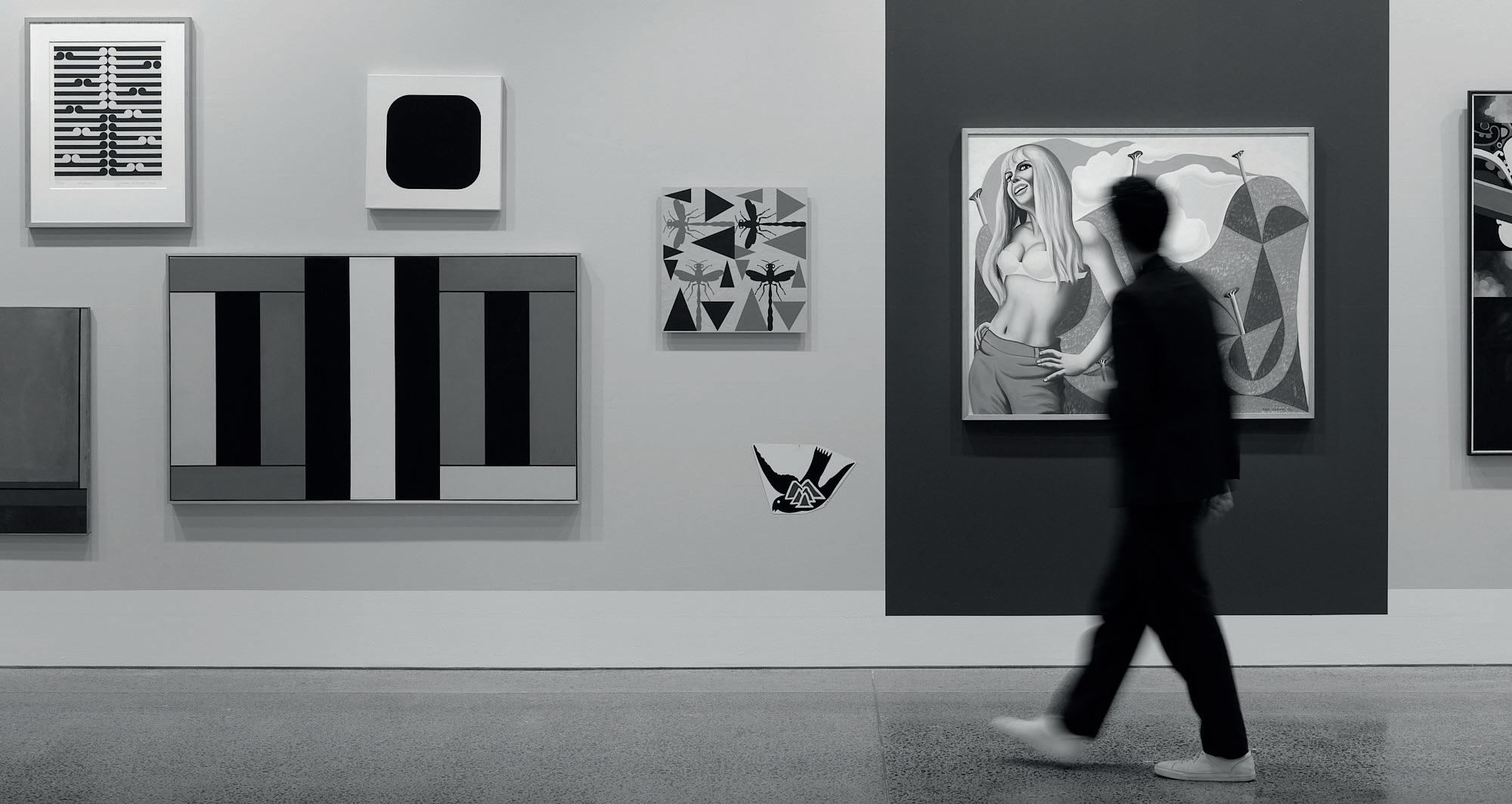
Ben Erren ben@webbs.co.nz
+64 21 191 9660
Fine Jewels & Watches
Christine Power christinep@webbs.co.nz
+64 27 929 5607
Fine Wines & Whiskies
Marcus Atkinson marcus@webbs.co.nz
+64 27 929 5601
webbs.co.nz
